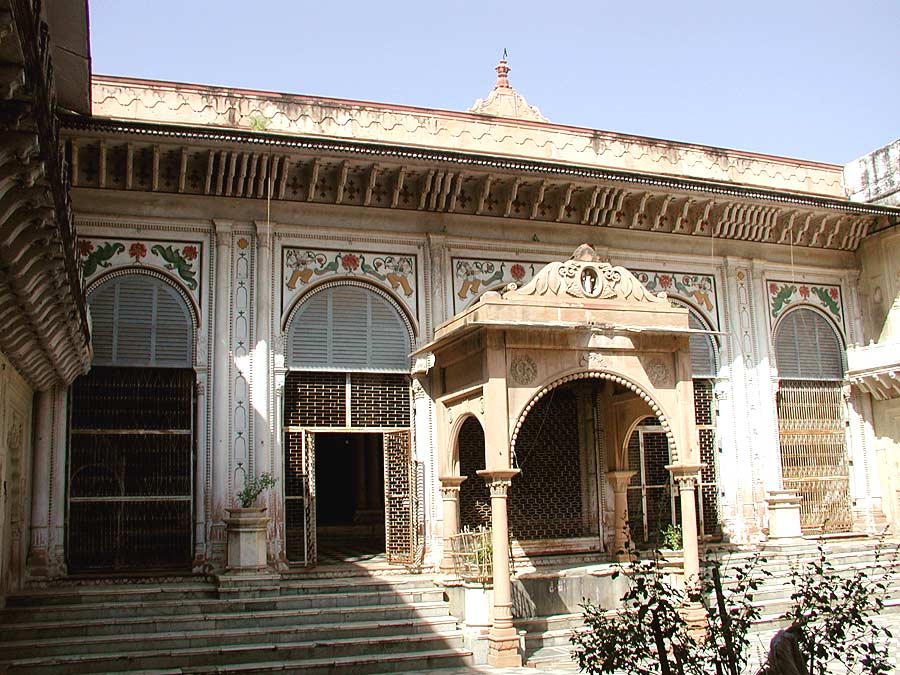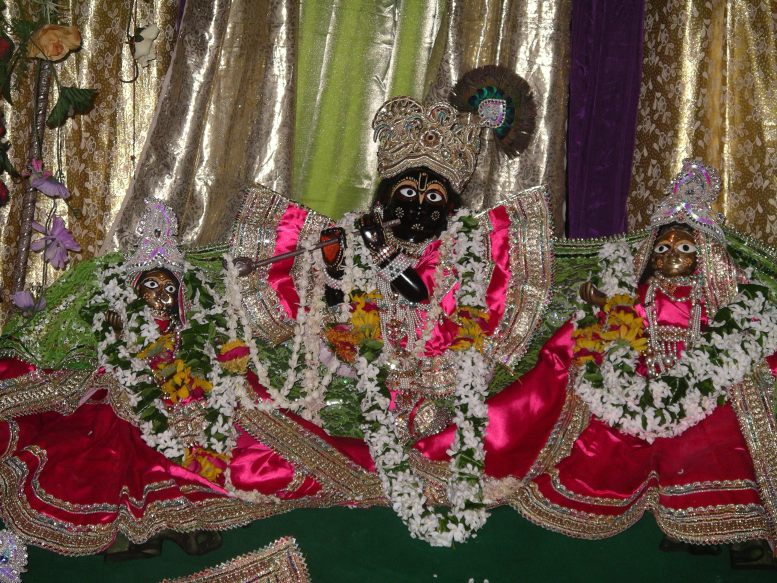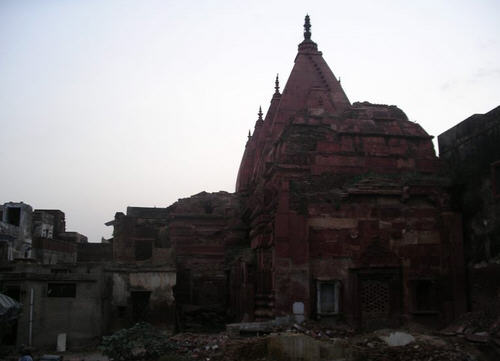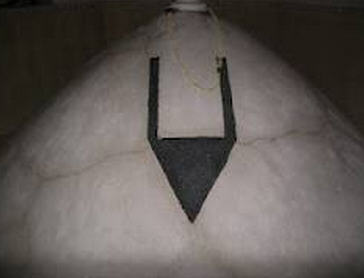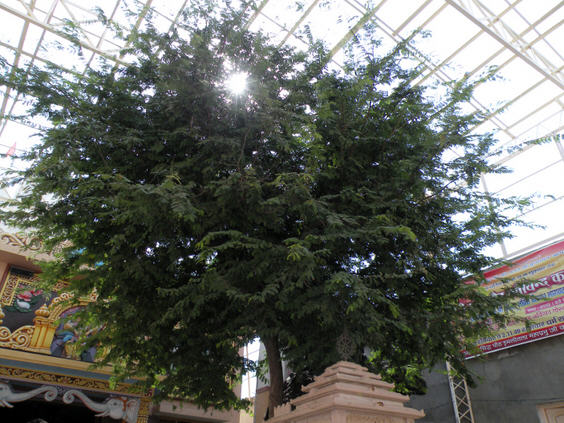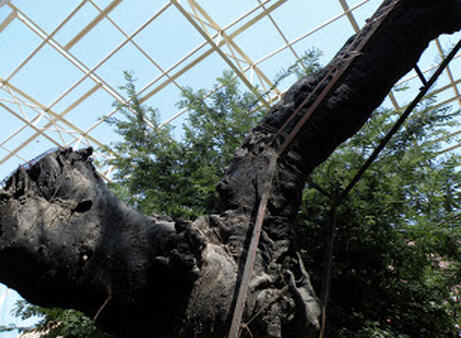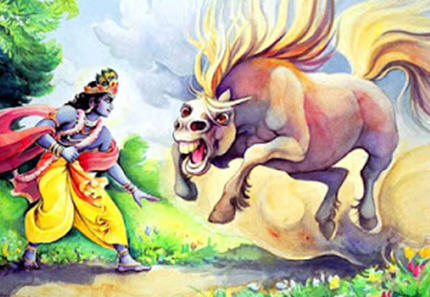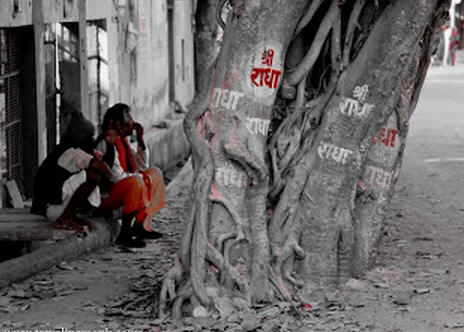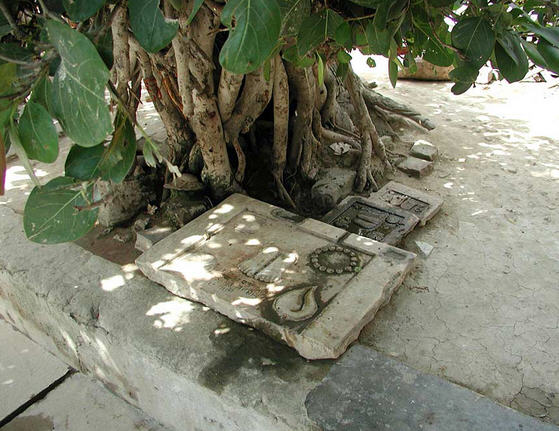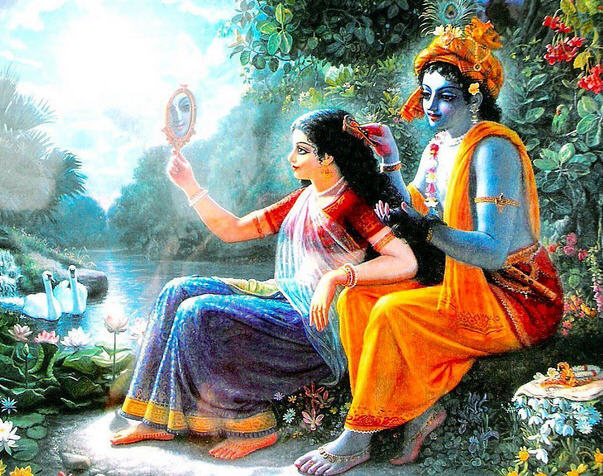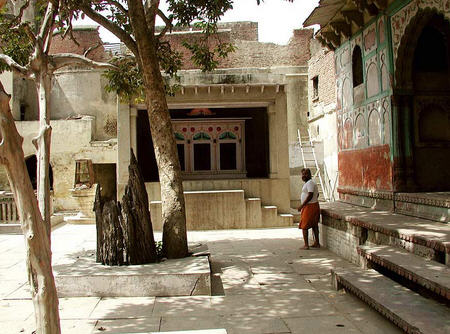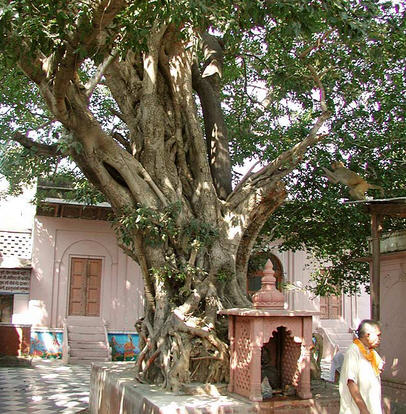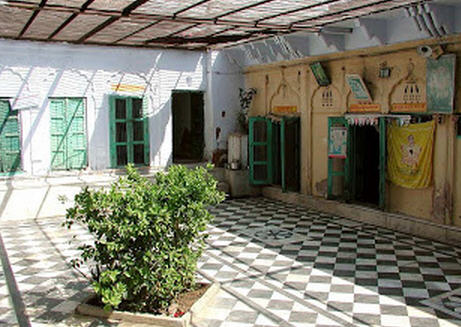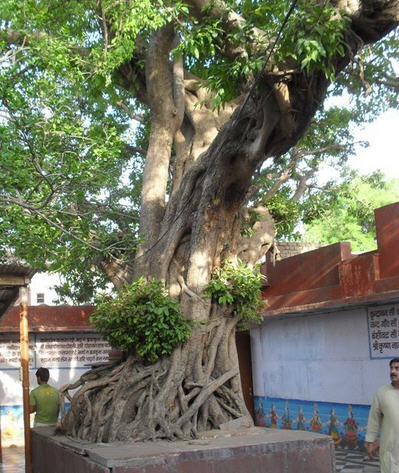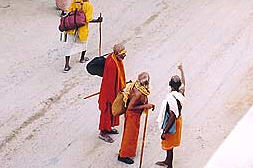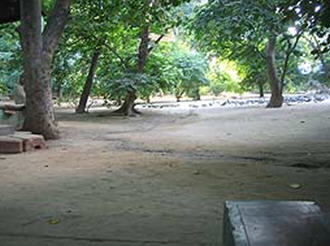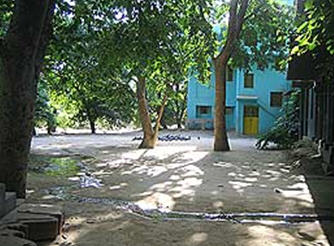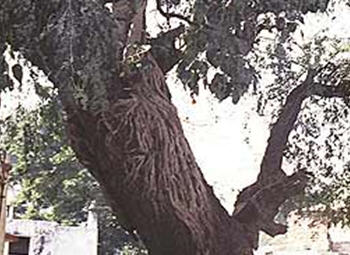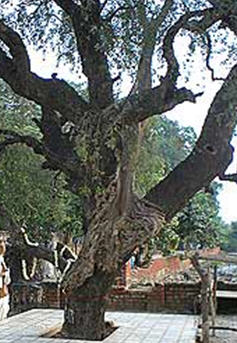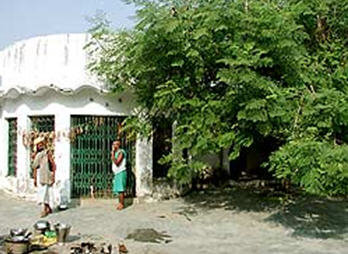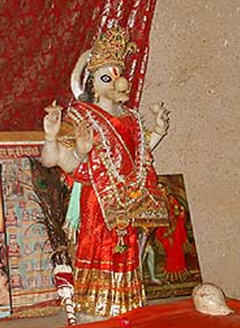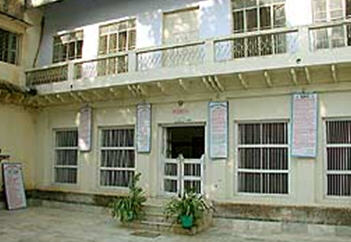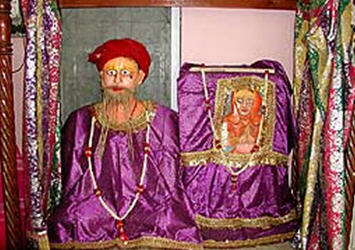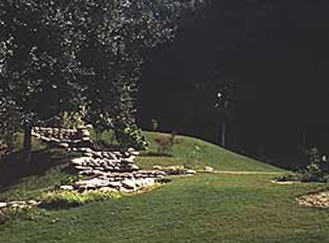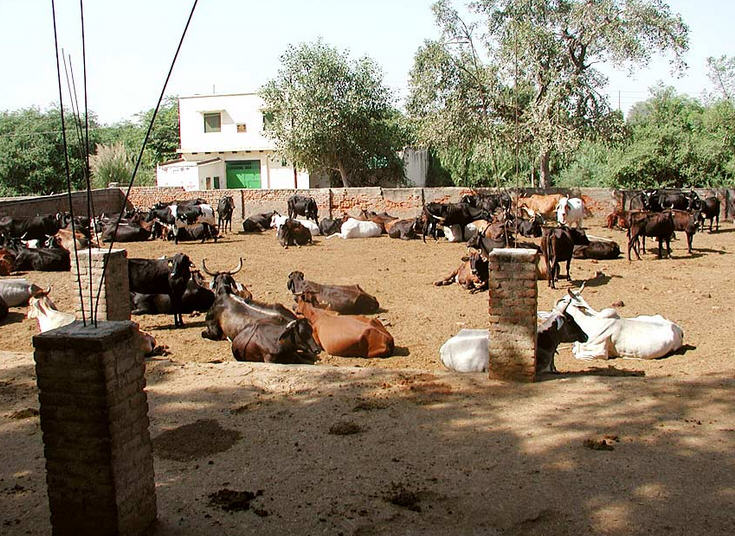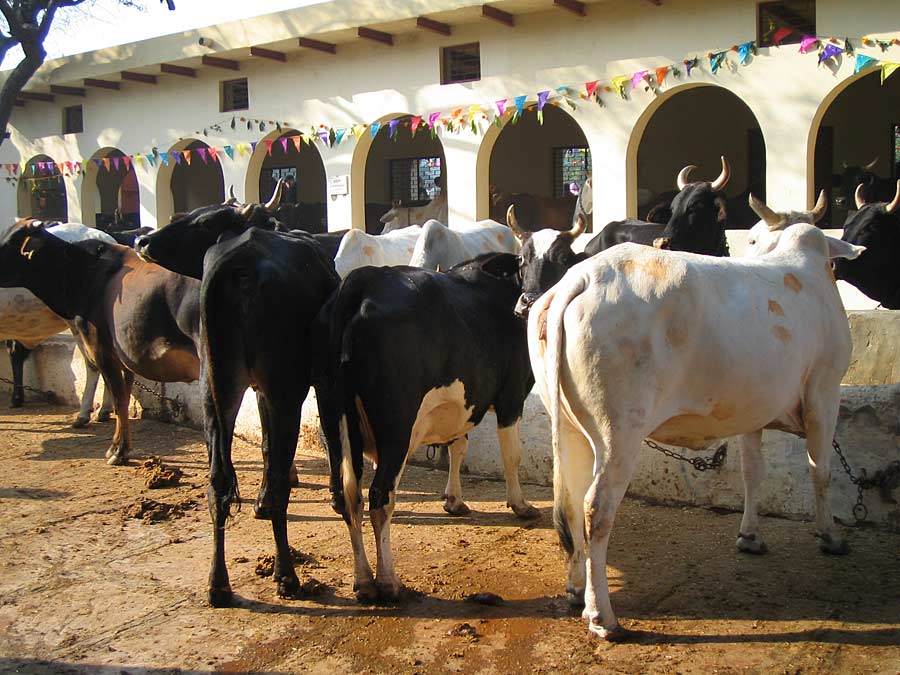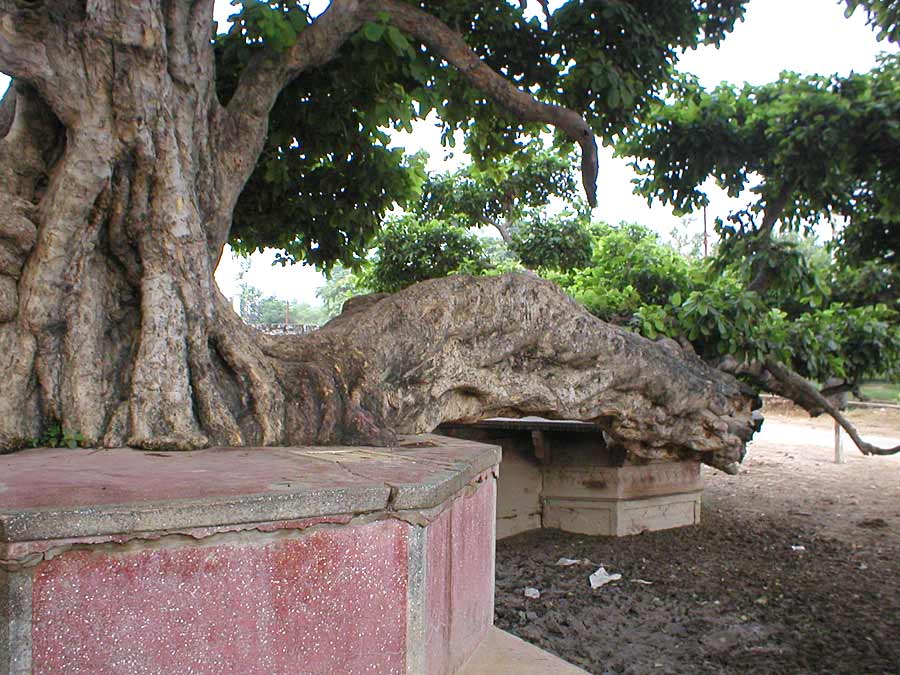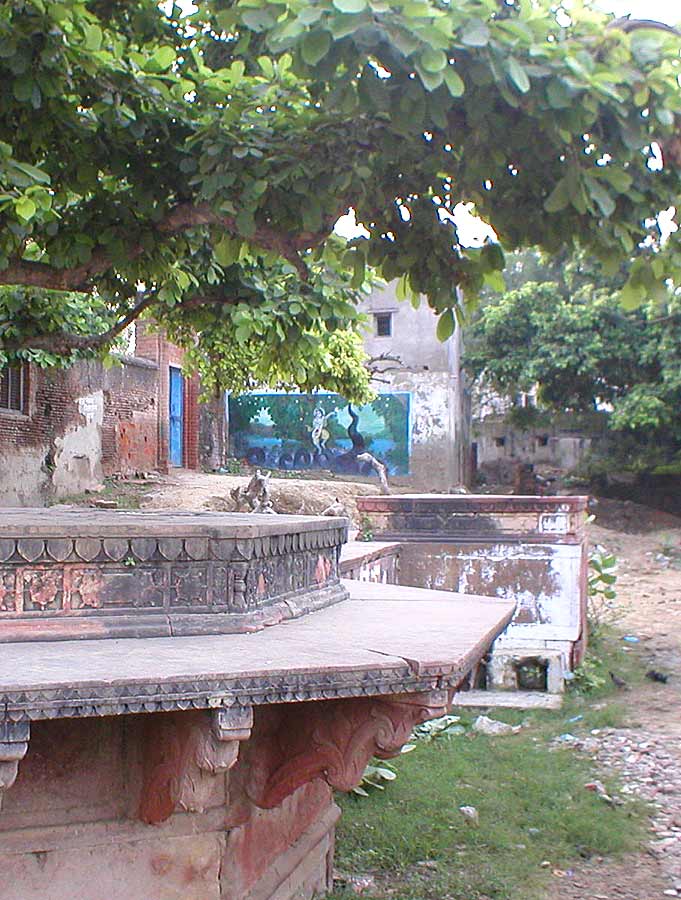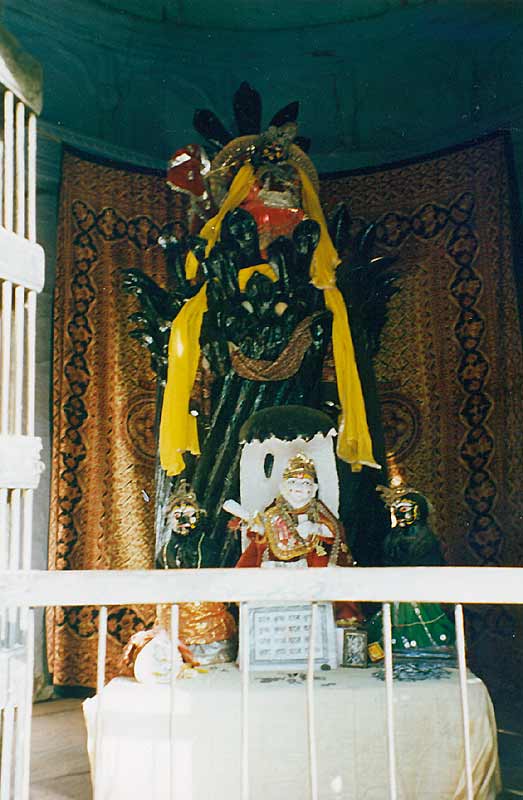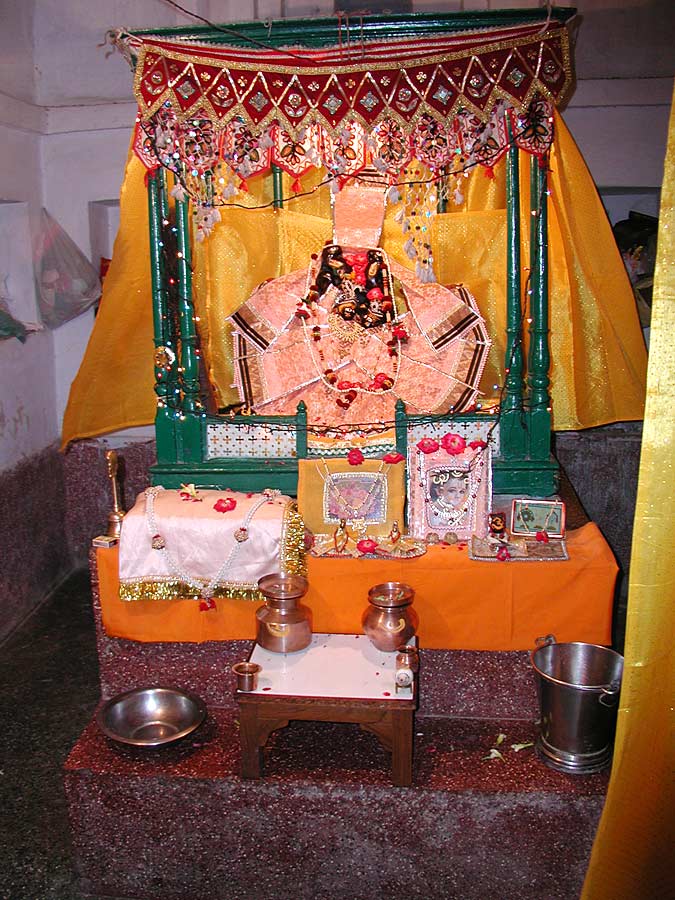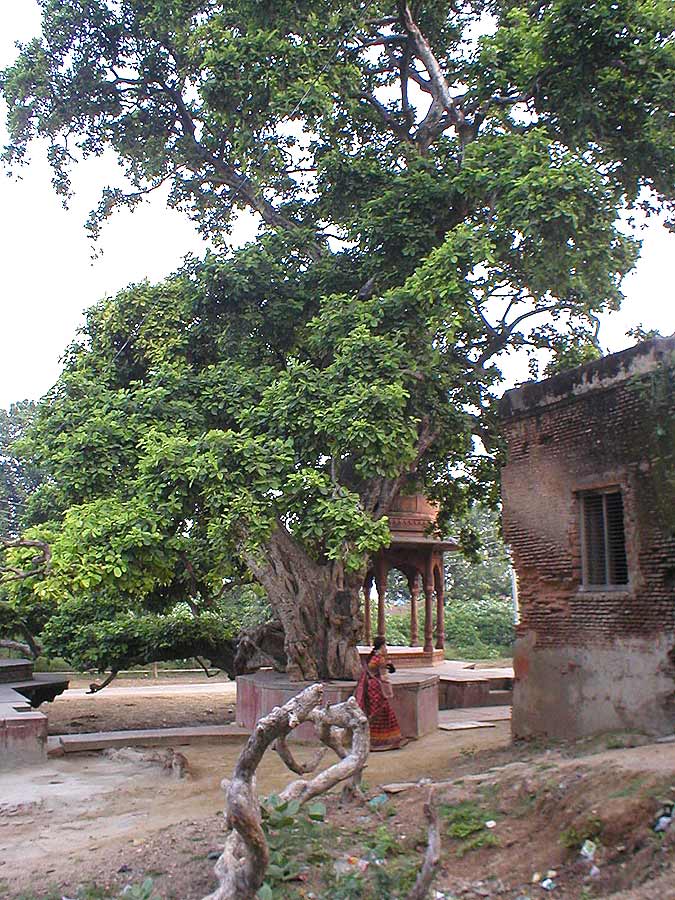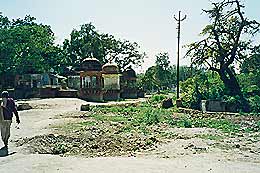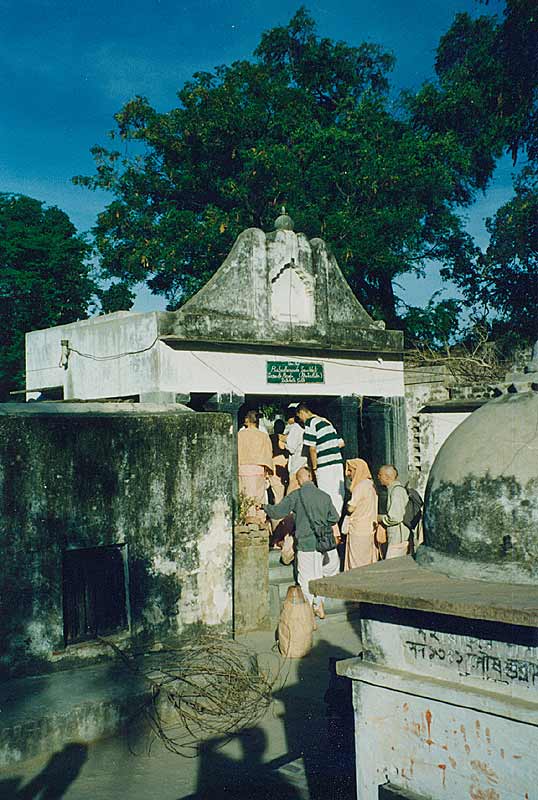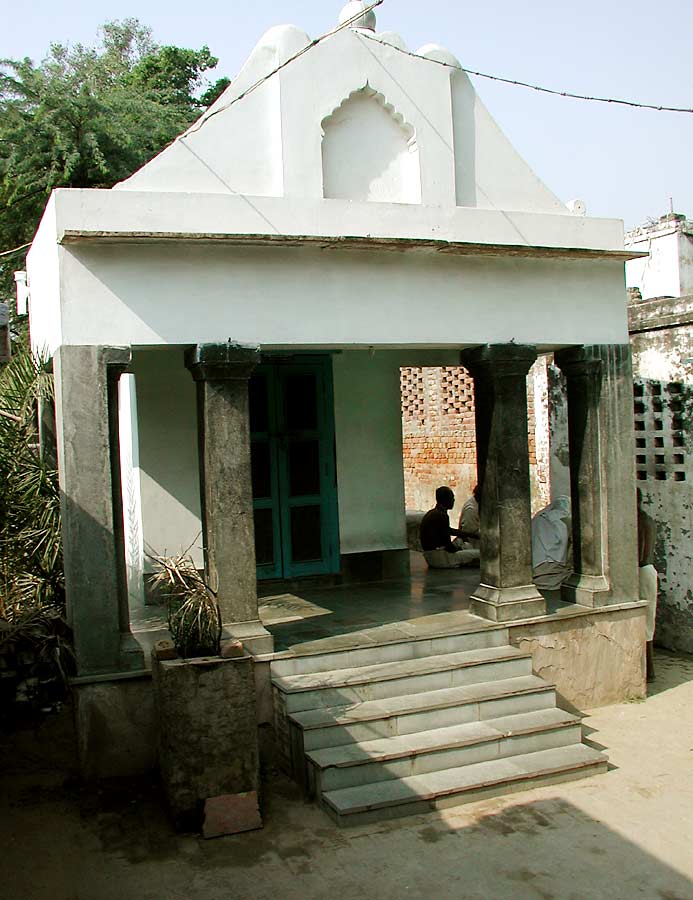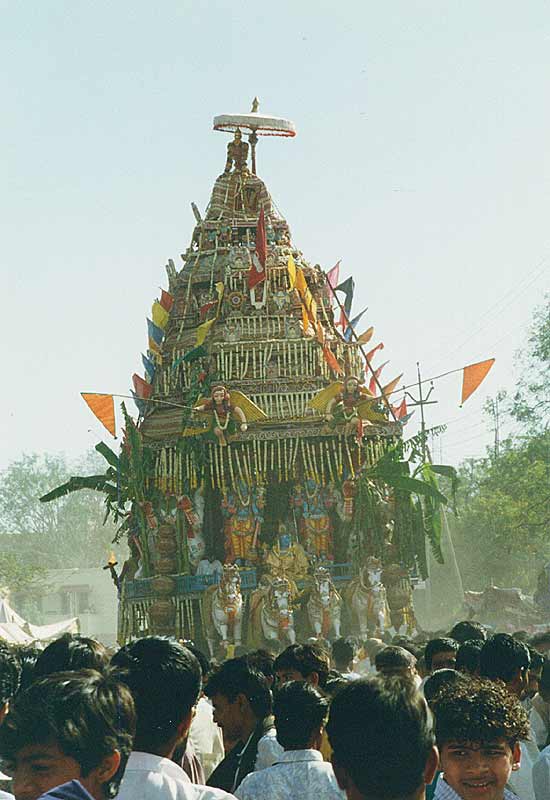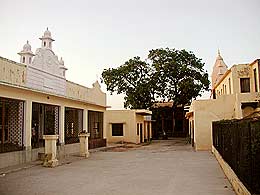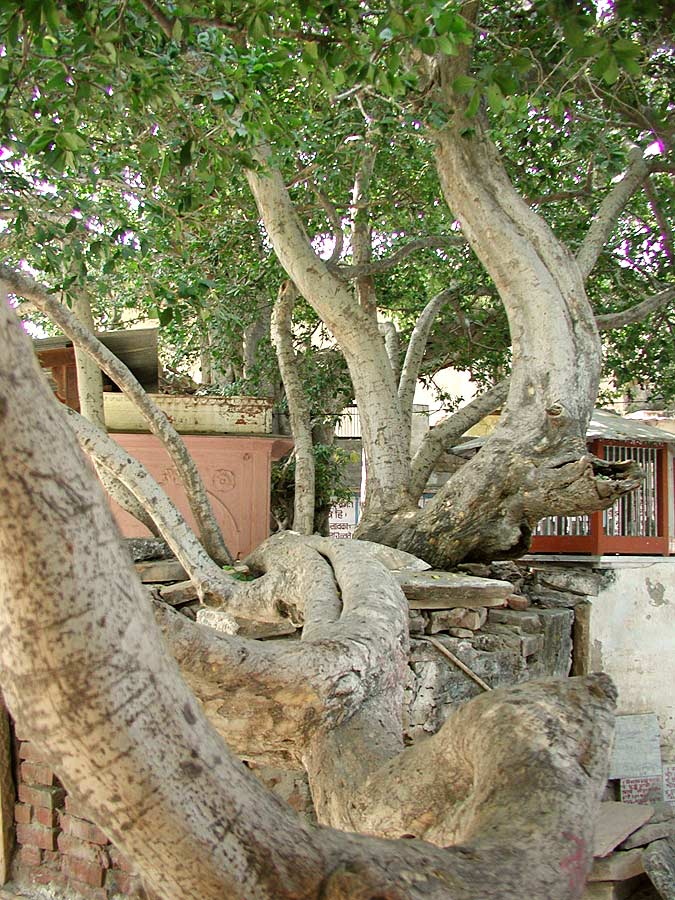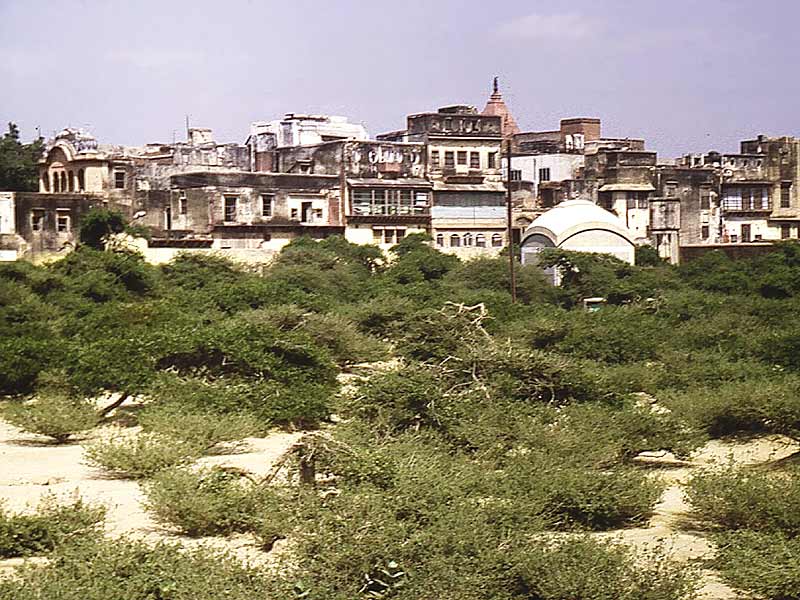This temple is a few minutes’ walk from Govindaji’s temple, was founded by Madhu Pandit Goswami, and its marvelous construction reveals a glorious past. Gopinatha, the presiding deity was first installed 5,000 years ago by Vajranabha, Lord Krishna’s grandson, and rediscovered at Vamsi-vata by Paramananda Goswami.
Sri Sri Radha Gopinath, pratibhu vigrahas (Vrindavan)
Sri Krishna´s grandson Vajranabha had three Deities carved according the descriptions of Krishna given by Parikshit´s mother Uttara. Thousands of years later, the same deity of Gopinath was rediscovered at Vamsi Vat in Vrindavan by Gadadhar Pandit´s disciple Paramananda Bhattacharya. Later the seva was taken over by Sri Madhu Pandit, whose samadhi is located at back of the temple premises.
Radha-Gopinath, original deities (Jaipur)
In the hall leading to Radha-Gopinath´s current altar there is a doorway on the right leading down a step into a small temple room. This is the old temple where the original Deities of Radha-Gopinath lived before the Mughal invasion when they were moved to Jaipur. Now the deity being worshipped here is ¨Muralidhar Mahaprabhu, a form of Goursundar playing the flute”. The temple Gosvami says of the deity, ¨This deity was installed after the Mughal invasion. Mahaprabhu holds the flute, for the sake of the general populace who don’t know about Mahaprabhu´s svarup. His color is golden like Radharani, but he holds the flute to show that he is also Krishna; He is Radha and Krishna in one form.¨
Old Gopinath Temple:
Today the pratibhu or non different replacement deities of Radha-Gopinath reside in a new temple connected to the old one. According to the direct order of Sri Jahnava Thakurani, Gopinath stands with Ananga-manjari to his left, and Radharani to his right. Lalita and Visakha flank them on both sides.

New temple entrance:
In one book about the temples of Vrindavan, the Padma Purana quotes saying that to get the full vision of Sri Krishna, pilgrims have to visit and offer obeisances to all three Deities during a single day, while the sun is still up.
Sri Govinda and Sri Gopinath are now in Jaipur, and Madana-Mohan is in Karoli, a small town in Rajasthan and this triple darsan seems to be possible even today, if you are an efficient traveller.
Samadhi of Madhu Pandit Goswami
Madhu Pandit´s samadhi (tomb)
Madhu Pandit was a disciple of Gadadhar Pandit. He established the temple of Gopinath in Vrindavan and lived here until his sacred body was entombed here.
Ghats in Vrindavan Town:
Yamuna flows graciously in Vrindavan town along several ghats (a series of steps leading down to a water body) where Krishna performed His pastimes. Some of the most important ghats that lie in Vrindavan town are Kaliya Ghat, Keshi Ghat, Chir Ghat, and Imli Taal Ghat.
1) Chir Ghat
Ter Kadamba Tree where Krishna hid Himself & stole the clothes of Gopis
Chir Ghat is one of the Holy ghats (series of steps leading down to a water body) on the banks of the river Yamuna. This is the place where famous pastime of Krishna stealing the clothes of the young gopis (cowherd maidens) of Vrindavan took place. This place was earlier just on the banks of river Yamuna. But over the years, as Yamuna has changed its course, now Chir Ghat stands at some distance from the Yamuna. There is an ancient Kadamba tree at this place which still exists since the time of Lord Krishna.
Gopis were all pure devotees of Lord Krishna and wanted to attain Krishna as their husband. At this very place, they performed the Katyayani Vrata, in which they would worship Mother Katyayani and pray to her in order to get the beautiful Son of Nanda Maharaj as their husband. Every day, the gopis would come to this ghat to take their bath and worship Mother Katyayani.
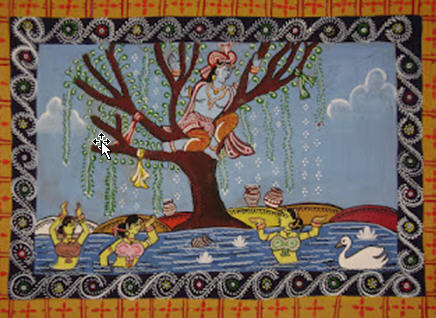
Krishna is stealing clothes of Gopis
In order to fulfill their desires to have Him as husband, Krishna very mercifully stole their clothes on one fine day when they were taking their baths at this Ghat, and brought them upon this very Holy Kadamba tree. Devotees of Vrindavan still worship this tree and even make offerings to this tree.
It is said that one can understand the pastimes of the Supreme Lord only by hearing from great souls who have realized the Absolute Truth. This pastime of Krishna stealing the clothes of the Gopis may seem to be some mundane affair between a young boy and some girls. But Radhanath Swami gives the real import of this pastime as being the epitome of the soul’s complete surrender to the Supreme Lord by giving up attachment for the clothes of gross outer covering of our subtle and gross bodies. The soul must be purified of all gross and subtle desires.
At this place one should make a prayer to Krishna that, “Krishna, here I offer my life, I offer my false ego, my body, my mind, my words, my thoughts, everything. Please take it all away, so that my true self can be given as an offering at your lotus feet.” One should be confident that if we offer our prayers sincerely, unto that Holy kalpavriksha tree, our prayers will be heard and answered.
2) Imli Tala
Imli Tala, in short, is the place which epitomizes the intense love in separation between Radha and Krishna. In simple english language, Imli Tala means tamarind tree. Imli Tala is the place, where Srimati Radharani left the Sharad Purnima rasa dance, leaving Krishna searching for Her in intense feelings of separation. Previously Imli Tala used to be near a ghat on the banks of the Yamuna but over the years, Yamuna has changed its course and is now flowing at a distance from Imli Tala.
Srila Prabhupada would often visit Imli Tala. In fact, Srila Bhaktisiddhanta Sarasvati Ṭhakura and his followers purchased this land at Imli Tala and built a beautiful Gaudiya Matha there. There is a yellow wall around Imli Tala and the Imli Tala tree can be seen through the gate of this wall. One of Prabhupada’s godbrother’s samadhi is there just beside this Holy Kalpavriksha tree. Prabhupada’s another very loving godbrother, Krishnadasa Babaji Maharaja, would come to Imli Tala practically each and every Ekadashi, around the time of sunset and would sit and chant japa of the Holy name until after sunrise under that Holy tree.
When Sri Radhika disappeared from the midst of the Sharad-purnima rasa dance, Krishna was searching for Her with intense feelings of separation. This mood of separation increased Their anticipation for meeting, and thus very much increased Their intensity of love.
Kalpavriksha Tree – Desire Tree, Imli tala:
Krishna, in this mood of separation sat down under this Kalpavriksha tamarind tree at Imli Tala and became completely absorbed in the thoughts of Srimati Radharani and chanting Her Holy names, assumed the color of Srimati Radharani. Just then Srimati Radharani appeared, relieving His separation. Subsequently, He again assumed His original form of Shyamasundara. At this very place, Krishna disclosed to Shri Radhika, “In My intense ecstasies of separation, I assumed Your form, Your complexion and Your ecstatic love. In the age of Kali, I will again appear like this, I will appear with Your complexion and with Your mood of ecstatic love and I will spread that love throughout the world, to all living beings, through the sankirtan movement – the loud congregational chanting of the Holy names: Hare Krishna Hare Krishna Krishna Krishna Hare Hare / Hare Rama Hare Rama Rama Rama Hare Hare.”
Lord Shri Krishna appeared in the age of kali, as Shri Caitanya Mahaprabhu, just 500 years ago, with the complexion and the mood of ecstatic love of Srimati Radharani. When Lord Chaitanya visited Vrindavan, He would come to Imli Tala everyday and for hours and hours with his japa-mala, He would deeply absorb Himself in chanting the Holy names, sitting under this Imli tree. In the mood of Srimati Radharani, He would become so deeply immersed in the ocean of separation from Shyamasundara that Lord Chaitanya’s golden form would be transformed into the complexion of a dark, newly formed monsoon rain-cloud. This is Imli Tala.
Tamarind Tree – Kalpavriksha Tree: Here one should pray at the lotus feet of Lord Chaitanya and Shri Shri Radha Gopinath to be able to become sincerely attached to chanting Their Holy names in pure love. This is the most potent place where Krishna Himself chanted Srimati Radharani’s Holy names and Mahaprabhu chanted Krishna’s Holy names in the mood of intense longing and separation and many of our previous acharyas have performed their bhajan here, so here we should pray for taste in chanting and pure devotional service unto Krishna.Tamarind tree – Kalpavriksha tree.
3) Kaliya Ghat

Kaliya Ghat: The Kadamba tree from which Krishna jumped to Yamuna:
Kaliya Ghat is the place where Krishna performed the celebrated pastime of Kaliya Daman or subduing the envious serpent, Kaliya. Kaliya Ghat is just at a three minutes walking distance from the famous Madanmohan temple of Srila Sanatana Goswami. The bhajan kutir and samadhi of Shrila Prabhodanand Sarasvati lies close to Kaliya Ghat. Bilvamangal Thakur’s bhajan place is also nearby. Kaliya was a thousand hooded serpent out of which 101 hoods were most prominent. He, alongwith his wives, the Nagapatnis were staying in a deep pond called the Kaliya Daha or the poisonous lake of the serpent Kaliya, at this place within the River Yamuna. Previously, Kaliya Ghat was one of the ghats (series of steps leading down to a water body) on the banks of River Yamuna but in due course of time, Yamuna changed its path and currently Kaliya Ghat lies at some distance from the Yamuna.
This is also the place where Shoubhri Muni was performing his meditation underneath the waters of Yamuna and out of pride he cursed Garuda (the bird carrier of Lord Vishnu who thrives on snakes and fishes) to die if he ever came here to eat fishes. In order to escape the wrath of Garuda, Kaliya later took shelter of this lake. Because of the deadly poison of Kaliya, all vegetation and life near this lake had died except one Kadamba tree which was showered with nectar by Garuda previously.
Krishna subdues Kaliya
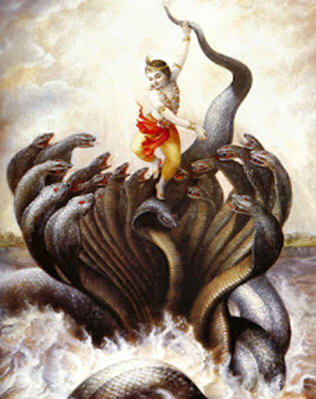
Krishna is dancing on the heads of the snake Kaliya
It is a graphic description of the poisoning of the Kaliya lake and the defeat of Kaliya in the hands of Krishna. Kaliya along with his wives was living inside a big lake within Yamuna.
This lake within Yamuna was bubbling, boiling and foaming with poisonous fumes, due to the poison of Kaliya. Any bird that flew overhead this lake or any vegetation that grew anywhere nearby would die immediately because of the deadly poisonous fumes, except a Kadamba tree, which survived because of the nectar drops showered upon it by Garuda. In fact, within 8 miles of Kaliya Daha nothing lived except this Kadamba tree. To this date pilgrims visit the Kaliya Ghat and worship this Holy tree which stands as a testimony of Krishna’s wonderful pastimes. Our heart is compared to a lake and due to Kaliya of envy within our hearts; the lake of our heart has become a very terrible place.
The tree which Krishna jumped off to fight the Kaliya serpent:
Once, while herding the cows, Krishna along with the Gopas (cowherd boys) were feeling very thirsty. They stopped by this lake to quench their thirst. As soon as the cows and the Gopas drank this poisonous water, they fell down unconscious as if dead. There was no movement or sign of life in their bodies. So when Krishna saw His friends dead, He just cast His merciful glance upon them and immediately they sprung back to life. It is explained in the Srimad Bhagvatam that just by the glance of Lord Vishnu all the living entities are impregnated into the material manifestation and so Krishna bringing back all His cows and cowherd friends back to life just by His glance is not an exaggeration.
All of us in the age of Kali Yuga are spiritually dead because of the poison of lust, anger, envy, greed, false pride and illusion that we have accumulated in our heart. We can come alive only when Krishna showers His merciful glance upon us in the form of mercy, the inspiration and the instructions of His devotees.
Krishna then decided to relieve the inhabitants of Vrindavana and river Yamuna from the burden of Kaliya. In a very playful mood, Krishna climbed to the top of this Kadamba tree on the banks of Kaliya Daha. First he pulled back His hair with both of His hands, then He retied His turban, then readjusted His belt and began to flap His arms like a wrestler in order to reassure the Gopas. He jumped from this Holy Kadamba tree in to the lake, thus causing the black hot burning waves foaming with poison to overflood the banks of the lake as if a tsunami has come. Krishna was very sportingly diving and swimming in those poisonous burning waves making loud sounds. Infuriated by the commotion created by Krishna in his lake, Kaliya immediately emerged out to face the intruder. Seeing the beauty of Krishna, he became even more envious and pounced upon Krishna, beat Krishna right in the chest and then coiled his body around the delicate form of Shyamsundar.
When Lord Krishna was in the coils of Kaliya, Kaliya began to expand his body to a monstrous size and began to squeeze with all of his strength, trying to crush little Gopal. He squeezed more and more but Gopal just continued to smile and remained motionless. When the cowherd boys and the cows saw Krishna in this condition, they began to weep and cry hideously. The cowherd boys fell to the ground rolling in the dust of Vrindavan suffering miserably. At that time inauspicious omens pervaded the whole Vrajabhumi.
Krishna remained in that condition for 2-3 hours. But then finally seeing the distress of the Vrajvasis, Krishna finally expanded His body and slipped out of the coils of Kaliya. Infuriated more than ever before, Kaliya started breathing horrible fires out of all of his mouths. There were sparks flying out of his red eyes. He raised all of his hoods and stared at Krishna with cruel angry eyes. Then Kaliya with his thousands hoods started attacking Krishna, but Krishna was going round in circles to dodge all of his attacks. Finally Kaliya became so dizzy that he was depleted of all of his strength. Then Krishna pushed down one of Kaliya’s hoods and jumped over it.
Eventually everyone has to bow down their head in front of the Supreme Personality of Godhead, Shri Krishna. A devotee bows his head to Krishna out of love and devotion whereas atheists and envious men like Kaliya have to bow down to Krishna who comes to them in the form of cruel death.
Krishna jumped upon the raised hood of Kaliya and began to dance. As Krishna was dancing, the demigods were struck with wonder. The demigods began to play kettle drums, mridangas, tablas, flutes, veenas and all other sorts of instruments. They were singing beautiful songs to accompany Krishna’s dancing. Krishna was moving His whole body, so gracefully with such exquisite artistry that the demigods with all of their instruments could not even keep up to Krishna’s beautiful dancing. He simply captivated all the fourteen worlds with His beautiful dance. It is here at Kaliya Ghat where Krishna is eternally performing the leela of dancing on the hoods of Kaliya.
Krishna danced on and on until Kaliya’s one thousand hoods collapsed, and were broken into pieces. If one hood fell aside then Krishna would jump to the next hood and thus danced on all the one thousand hoods of Kaliya bringing Kaliya on the verge of death. For the Vraja Gopis, Krishna’s feet are more tender than the petals of lotus flower but for Kaliya they were like thunderbolts crashing upon his head. Deadly black and red poison started oozing out of Kaliya’s mouths. After all of his poison was vomited out, blood started pouring from his mouth and then Kaliya understood that he was finished. At this time he remembered how his wives, the Nagapatnis, being great devotees had always pleaded him to surrender to Krishna and almost at the verge of death, Kaliya took shelter of the lotus feet of Krishna.
The uncontrolled tongue is like a snake like Kaliya, which is very venomous and envious. The uncontrolled tongue keeps on biting and spitting the venom of harsh words and unfavorable speech on others making everyone’s life difficult. However, when Krishna appears on this tongue in the form of His Holy names: HARE KRISHNA HARE KRISHNA KRISHNA KRISHNA HARE HARE HARE RAMA HARE RAMA RAMA RAMA HARE HARE, the tongue gets purified and all the poison of this snake like tongue gets removed. One should make a prayer to Krishna that, “Krishna, please subdue these propensities of Kaliya within my heart i.e. envy, lust and cruelty. Let me become humble and appreciate Your glories and the glories of Your devotees, let me become purified.”
Seeing that their husband had now become remorseful and humble, the Nagapatnis came around Krishna with folded palms and prayed to Krishna to forgive him and release him. Being pleased by the prayers of the Nagapatnis, Krishna forgave Kaliya and told him that he should no longer disturb the Vrajavasis and immediately leave for his home, Ramanaka, deep in the ocean. Thus the celebrated pastime of Kaliya Daman was performed at this place.
Keshi Ghat
Keshi Ghat
Keshi Ghat is the principal bathing place in the town of Vrindavan. It is little east of Chir-ghat on the banks of the Yamuna. Keshi Ghat is one of the most beautiful ghats of Yamuna with stone inlaid palaces on the banks and massive Madanmohan temple visible in the backdrop. Here the sacred river Yamuna flows very graciously and extends herself to everyone without discrimination. Anyone who touches, drinks, sees, smells and bathes in her waters become infinitely purified. This ghat (series of steps leading down to a water body) is named after the pastime of Lord Krishna killing the demon Keshi.
Keshi demon, a gigantic horse demon sent by Kamsa, was galloping towards Vrindavan to kill Krishna. He wanted to pulverize Krishna’s lotus like soft body with his legs but Krishna caught his legs, whirled him and threw him away. Keshi again attacked with his wide open mouth wanting to eat Krishna. But Krishna teasing Keshi with His thumb put His lotus hand inside Keshi’s dirty mouth and choked him up. Keshi, perspiring and suffocated, passed immense quantities of stool and finally his body just broke open like an over-ripe piece of melon.
After killing Keshi, Krishna came down to the ghat on the banks of the Yamuna to take His bath because His hand was stuck in Keshi’s dirty mouth. From then on, this ghat came to be known as Keshi Ghat. Jokingly, Shrila Rupa Goswami forbids wordly men to go to Keshi Ghat saying, “If you have even a slight desire to enjoy life with your wife, sons, relatives and friends, then listen to my advice: Never go to Keshi Ghat in Vrindavan, even by mistake. There, Shri Govindaji is standing in His charming threefold-bending form, smiling. A person who even once beholds this deity of Govinda never returns to his home, and his household life is ruined.” In other words, by having darshan of Govindaji at Keshi Ghat, one is freed from all material attachments and becomes mad after Him like all the residents of Vraja.
Keshi demon represents the anartha of pride in one’s own devotional practices and achievements. Keshi also represents the sense of vanity and ego. Keshi was a horse. Horses are controlled by pulling their mouth with ropes. So, Krishna put His hand right in the mouth of Keshi and controlled him. Proud people often boast about themselves with their own mouth and criticize others. So, one should curtail these demoniac tendencies by restricting one’s tongue from engaging in prajalpa (unnecessary gossip) and by chanting the Holy names of Krishna. Therefore the prayer that one should offer at Keshi Ghat is to become blessed by Krishna so as to be able to render more and more devotional service in the humble mood of being the servant of the servant of Krishna’s servants without becoming unnecessarily proud of one’s devotional practices and achievements.
Krishna is killing the demon Keshi:
Kamsa, maternal uncle of Lord Krishna, kept on sending many powerful mystic demons, the best of all in the universe like Putana, Shakatasura, Trinavrata, Aghasura, Bakasura, Vyomasura, Vatsasura etc., to murder little child Krishna. Both Krishna and Balarama effortlessly killed them to the surprise of Kamsa. Kamsa thus highly frustrated in his attempts to kill Krishna, sent a mighty powerful mystic demon named Keshi. Keshi assumed the form of a gigantic mad horse. He came galloping towards Vrindavan. He ran at the speed of mind. His hooves seemed to tear the earth apart and cause earthquakes. His tail reached so high in the sky that it was scattering the clouds.
Right there in Vrindavan, unaware of what is there in store for them, the cowherd boys were grazing the cows and playing blissfully with Lord Krishna. Madhumangala, one of the cowherd boys, who is fond of Laddus (delicious sweet), joked with Krishna saying, “Hey Krishna! My dear friend, you are so dear to inhabitants of Vrindavan, they all love you and please you by offering delicious food. Lend me your beautiful peacock feather, flute and effulgent and gorgeous yellow clothing. Thus dressed like you, I will procure Laddus and eat them to my heart’s content”. Out of affection for His friend, Krishna personally decorated His friend and sent him.
Meanwhile Keshi demon was searching in Vrindavan for the boy who wore peacock feather, playing flute and wearing yellow garments as per orders given by Kamsa. Seeing Madhumangala dressed as Krishna, Keshi furiously attacked him. Madhumangala was frightened to see this ghastly demon and immediately called out to Krishna for help. Just at that time Krishna came to the scene to rescue His friend and challenged Keshi for a duel with Him. Infuriated by the challenge, Keshi opened his mouth to devour Krishna. When he approached Krishna he began to kick Krishna with his front legs. Krishna grabbed those legs, whirled him around and threw him away to a long distance of more than 100 yards. Keshi fell to the ground unconscious. But he came back to the consciousness, madder than ever before.
Now Keshi’s eyes were blazing with anger. He charged towards Krishna with his gigantic mouth kept open to devour the Lord. Krishna with a big smile on His lotus face, effortlessly pushed His hand in Keshi’s mouth and broke all of his teeth. Keshi felt Krishna’s lotus hand stuck within his throat to be red-hot like fire. Krishna’s hand expanded, expanded and expanded until Keshi could no longer breathe. Finally he got choked up and suffocated and started kicking his legs. His eyeballs exploded out of the sockets. He passed stool and urine simultaneously, slipped over and fell to the ground dead. Shri Krishna Bhagvan ki Jay!!!
Cowherd boys were very happy. They cried out, “Well done Krishna! Well done!” And the demigods from heaven showered flowers upon His head. Because His hand was stuck in Keshi’s dirty mouth, Krishna came down to the ghat on the banks of the Yamuna to take His bath after killing Keshi. Since then, this ghat came to be known as Keshi Ghat. Since then, great devotees of the Lord have been reciting this wonderful pastime of Krishna killing Keshi at Keshi Ghat.
Vatas in Vrindavan Town
Desire Tree in Vrindavan:
Vata is a Sanskrit name for a banyan tree. There are several huge banyan trees in Vrindavan. It is said that trees in Vrindavan are not ordinary. They are all kalpavriksha trees i.e. desire fulfilling trees. Some of the most important Vatas in Vrindavan are:
- Advaita Vata
- Shringar Vata
- Vamshi Vata
1) Advaita Vata
Place where Advaita Acharya performed his bhajana:
This is the place where Shri Advaita Acharya resided when he came to Vrindavan. Advaita Acharya is the incarnation of Mahavishnu who appeared in this mortal world as one of the intimate associates of Shri Chaitanya Mahaprabhu. Advaita Vata is very close to the historic Madanmohan temple built by Shrila Sanatan Goswami. Advaita Acharya stayed under the banyan tree at this place for several days. Under this tree, He served the deity of MadanGopal with great love and devotion. Shri Chaitanya Mahaprabhu also resided here for some time during His visit to Vrindavan. There is a monument erected at this place in remembrance of Shri Chaitanya Mahaprabhu’s stay at Advaita Vata.

As a young boy, Advaita Acharya became a great scholar of all Vedic literatures and came to the conclusion of pure Bhakti. When He was still young, His mother and father both disappeared from this world and He went to Gaya to perform their Shraddha ceremony. On His pilgrimage to Gaya, He met Shrila Madhavendra Puri who initiated Him in the Madhva Sampradaya. Shrila Madhavendra Puri instructed Him in all the nuances of the sweet leela of Vrindavan especially Madhurya rasa. He told Him that one can gain entrance into the sweet leela of Vrindavan by always remembering Krishna, by hearing and chanting His pastimes and by constantly chanting His Holy Names.
After that Advaita Acharya began to travel to all the holy places throughout India and at last he came to Vrindavan. He travelled through all the twelve forests of Vrindavan and then he came to this place. He lived under this banyan tree at Advaita Vata. It was at this place He worshipped the beautiful deity of Madan Gopal under this banyan tree. He stayed here waiting for the indication of the Lord for Him to go back to Navadwip Dham for calling out to Lord Chaitanya to appear in this world.
Sri Advaita Vat:
2) Shringar Vat
Krishna is grooming Radharani’s hair, Shringar Vat:
During the Rasa dance, Krishna left the assembly of all the gopis (cowherd girls) and came here to this place, so as to be alone with Srimati Radharani. With His own hands, Krishna picked beli, chameli and other beautiful flowers that grew in the groves of Shringar Vata and personally decorated Srimati Radharani’s hairs. There is a beautiful painting in the temple at this place depicting this historical, treasurable and worshipable pastime. This place signifies that the Supreme Absolute Truth, The Cause of all causes, appears in Vrindavan as a simple cowherd boy and becomes a servant to please Srimati Radharani. Krishna is only conquered by the love of His devotee.
Shringar Vata is also a very favorite pastime place of Shri Balaramaji. When Krishna and the gopas (cowherd boys) would herd cows along the Yamuna; Subala, Stoka-krishna, Shridama, Madhumangala, Arjuna, Ujjvala, Gandharva, all of these gopas would bring Krishna here and decorate His hair and His body with beautiful flowers, minerals, peacock feathers, gunja malas and other beautiful ornaments of the forest.
During His stay here in Vrindavan, Shri Nityananda Prabhu spent few days here at Shringar Vata. Therefore, this place is also known as Nityananda Vata. Nityananda Prabhu performed His pastimes here as a cowherd boy in the mood of Balaramji. He would bathe, play games and splash waters in the waters of Yamuna at this place in the mood of a small child with the cowherd boys who were residing here at that time.
3) Vamshi Vat
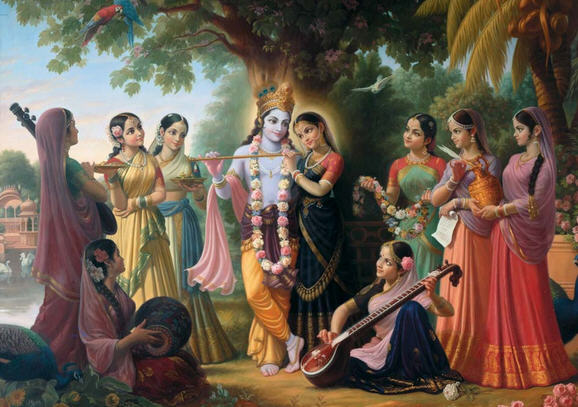
Krishna and Gopis:
Krishna has a variety of flutes which He plays in order to attract the hearts of His devotees. Based on the length and the number of holes in the flute it is called Vamshi, Venu or Murali. Vata is the Sanskrit word for a banyan tree. So Vamshi Vata is the celebrated banyan tree in Vrindavan where Krishna plays His Vamshi to attract the heart of His devotees especially the Vraja Gopis. This is the place where Krishna as Gopinath, the Lord of the Gopis, performs the rasa dance with the Gopis of Vrindavan.
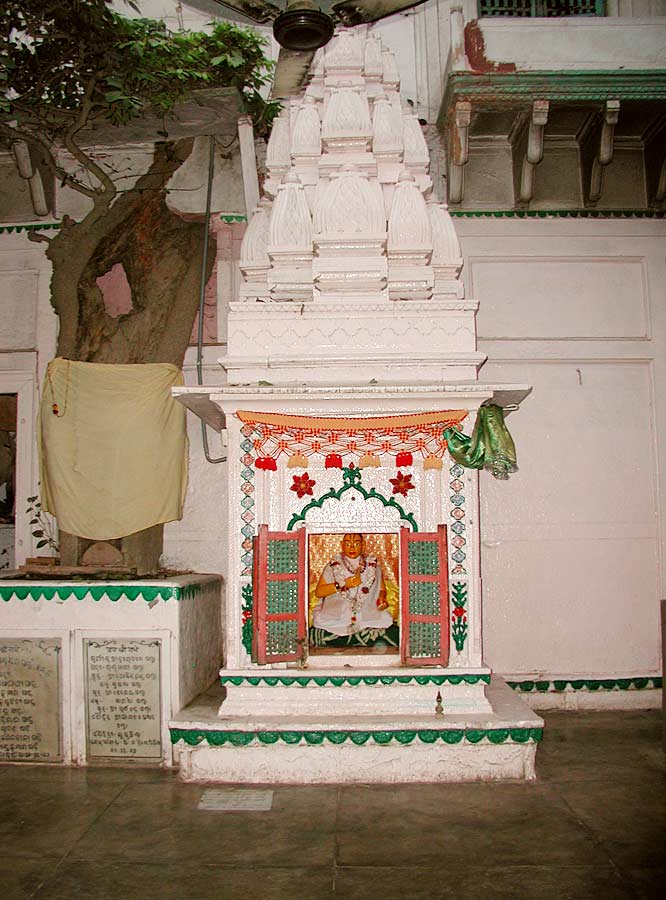
Gopeshvar Mahadev in Vamshi Vat:
Renunciation of Gopis: When Lord Shyamsundar played on His Vamshi in the fifth note, at this place on the full moon night of the Sharad season, the ambrosial nectar of the sound vibration of Krishna’s flute filled the entire atmosphere. When this nectar entered into the ears of the Vraja Gopis, it penetrated their loving hearts. Charmed by the sweetness of Krishna’s love, they exhibited the perfection and essence of renunciation held supreme in the Gaudiya Vasihnava siddhanta. For the pleasure of Krishna, they at once left their home and all of their security. Some of them were milking cows but on hearing the music of Krishna’s flute, they left the pots under the cow’s udders and immediately ran to Vamshi Vata tree to meet Krishna. Some were feeding their baby children. Renouncing even the attachment towards their children, the Gopis left their children behind for the pleasure of Krishna. In the dead of the night they were fearlessly following the music of Krishna’s flute in a dangerous forest because they had complete faith that if they please Krishna their lives would become perfect. They were willing to risk their good names and their chastity even at the risk of never being allowed to return home again. Their only ambition was to lay themselves at the feet of Krishna, completely at His disposal, willing to mould according to His desire for His pleasure.
Tree under which Krishna used to play His flute:
Qualification to approach Rasa Lila: All the fortunate Gopis came to this Holy place of Vamshi Vata and here rasa lila began. The most perfect and pure of all manifestations of God’s pastimes is rasa lila. It is so elevated in nature that only great souls like Shukadev Goswami, Rupa Goswami, Sanatana Goswami, Shri Chaitanya Mahaprabhu, Shri Ramananda Raya who have given up everything of this world and placed their hearts in the exclusive service of Krishna can truly understand the divine significance of rasa lila.
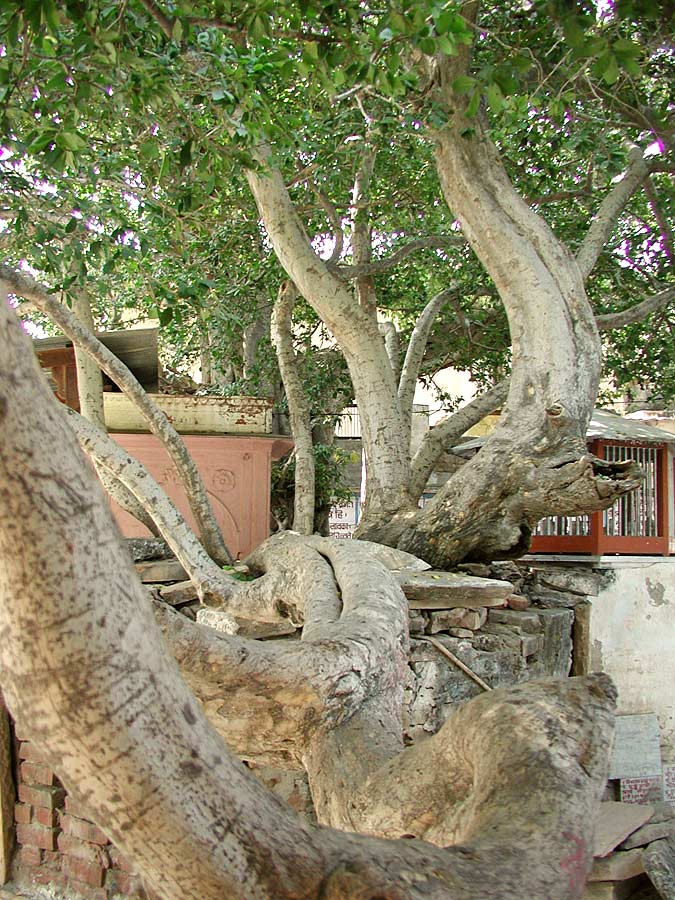
Vamshi Vat:
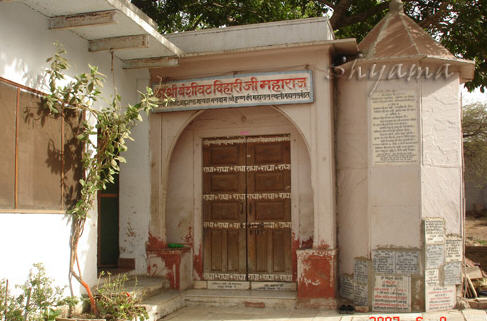
Vamshi Vat:
Vamshi Vat:
Vamshi Vat:
Prayer: Under this Vamshi Vata tree many great acharyas have offered their prayers and bhajans to the lotus feet of Shri Shri Radha and Krishna. This place is certainly beyond the farthest reaches of a conditioned soul’s power of understanding and realizations. But if one offers one’s sincere and humble prayers to Guru and Vaishnavas petitioning them to carry those prayers through disciplic succession to Shri Shri Radha and Krishna, then the Lord will be pleased and with His pleasure, His grace will descend. One day by the mercy of the Lord, we can also gain entrance into this mood of pure renunciation of the Gopis. So we should earnestly pray here at the lotus feet of the great Vaishnavas who are the servants of the Gopis of Vrindavan that we could also exclusively dedicate our body, mind, words and very life at all risk and at all cost for the pleasure of Shri Shri Radha and Krishna.
Kunjas
Kunjas are beautiful garden groves where different varieties of flower and fruit bearing Kalpavriksha trees such as Kadamba, Tamal, Mallika etc. create a wonderful environment for the pleasure pastimes of Shri Shri Radha Krishna. There are several kunjas in Vrindavan which are maintained by different Gopis and Gopas for the pleasure of Shri Shri Radha Krishna.
Dheera-Sameera Kunja:
This is one of the favorite meeting places of Shri Shri Radha and Krishna. One can find its mention in many of the literatures of the six Goswamis. Dheera means gentle and Sameera means wind or breeze. Dheera-Sameera, as the name suggests, means the place where the flow of the wind became very slow being intoxicated by the charming sound of Shyamsundar’s flute. Also here is the pushpa samadhi of Shrila Gauri Das Pandit, one of the most intimate associates of both Nityananda Prabhu and Lord Shri Chaitanya Mahaprabhu.
One time Radha and Krishna were sitting together in this Dheera-Sameera Kunja and Krishna began to blow beautiful and sweet melodies through His flute. The nectarine sound vibration that emanated from Lord Shri Krishna’s flute was so pleasing that it captivated and intoxicated the hearts and the minds of all living entities of Vrindavan. On that particular day, the wind was blowing very hard. But when it came to this place, hearing the sound of Krishna’s flute, the wind became very slow and graceful as it did not want to get separated from the beautiful sound of the flute of Shyamsundar. The wind just wanted to gracefully float at this place so as to serve as a host and an accompaniment to the sweet music of Krishna’s flute.
At this place one can just sit and absorb oneself in the sweetness and the mood of Vrindavan by hearing the beautiful sound of the singing of parrots and being surrounded with wonderful kalpavriksha trees with slow cooling breezes touching one’s body. This is Vrindavan, where the entire atmosphere simply brings our heart closer to the remembrance of Radha and Krishna.
Places of parikrama around Vrindavan – Detailed map of Vrindavan with most interesting places can be found at the end of this page.
Vrindavan-parikram – Circumambulating Vrindavan by foot can be made in two or three hours, provided on does not stop in many places.
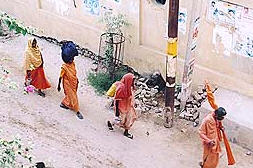
Parikram of course, can be made in many ways – for instance as a reverential tapasya.
Vrindavan-parikrama can be started at any place on parikram road going clockwise.
We start our journey at Ramana-reti where Krishna and Balaram performed Their pastimes, just next to Radha-tila where Radharani’s parrots gather every evening in numbers.
Our first stop is Krishna-Balaram tree. Balaram (with white complexion) sits on Krishna’s (blackish) neck, as the white tree grows from the dark tree.
But the whitish tree is drying up since 2004.
Varaha-ghat: Formerly Yamuna river used to flow here.
At this place, Krishna showed His Varaha form to the gopis.
Beautiful Varaha Deity at Varaha-ghat.
Gautama Muni asram is just opposite to Varaha-ghat on parikram path.
Here great sage Gautama Muni performed austerities many thousands years ago.
Few plots of land are cultivated attempting to restore some of the former beauty of Vrindavan of Krishna’s times.
Go-ghat: At Go-ghat Nanda Maharaja gave cows in charity to the brahmanas.
ISKCON Gosala is situated just next to it.
Still further is a place called Kaliya-hrada. In times of Krishna’s pastimes, a serpent named Kaliya lived in Yamuna river. Due to poisonous vapour, the tree and grass near the bank of Yamuna had all dried up.
Lord Krishna saw the effect of the great serpent’s poison: the whole river that ran before Vrindavan was deadly. Krishna climbed up in a big Kadamba tree, tightened His belt cloth and flapping His arms just like a wrestler, jumped into the poisonous river.
Krishna and Kaliya serpent fought within the Yamuna river. The Lord danced upon Kaliya’s hoods and defeated him, but spared his life because of the sincere prayers of the naga-patnis, the serpent’s wives. The kadamba tree from which Krishna had jumped was the only tree, which was not dead. Some say that due to touching the lotus feet of the Lord, the tree became immediately alive.
But in some puranas, it is stated that Garuda, the eternal carrier of Visnu, knew that Krishna would take this action in future, so he put some nectar on this tree to preserve it. In either case the same tree is still standing at Kaliya-ghat and nice Deity of Krishna’s dancing on Kaliya’s hoods can be seen there.
Nearby Kaliya-mardana temple:
where 5000 years old Deity installed by Vajranabha is worshiped by friendly pujaris.
Beginning in the year 1511, Sri Caitanya Mahaprabhu made a journey of the places in South India. On Sukla Ekadasi, He arrived at Ranga-ksetra, where He decided to stay and practice austerities during the four months of Caturmasya. At that time, Lord Caitanya stayed at the home of three brothers: Tirumala, Vyenkata (whose son was Gopal Bhatta Goswami) and Gopal Guru (Prabhodananda Sarasvati) In his youth Gopal Bhatta was instructed by Prabhodananda Sarasvati.
They were Sri Vaisnavas, followers of Ramanujacarya and devoted to the worship of Laksmi-Narayan. Lord Caitanya explained superiority of Lord Krishna’s lila to His hosts. According to Caitanya-caritamrita (Madhya, 9) later they became great devotees of Lord Caitanya.
Prabhodananda Sarasvati became follower of Sri Caitanya Mahaprabhu and is considered one of the great acaryas in the gaudiya-vaisnava sampradaya. Actually he is one of the great eternal associates of the Lord. When the Lord appeared in His original form of Sri Krishna, Prabhodananda Sarasvati was one of the important gopis, Tungavidya devi. After Sri Caitanya left South India, he meditated about his Lord and left his home at Ranga-ksetra and travelled to Vrindavan, where he stayed in the forest of Kamyavan and where he was soon met by his nephew, Gopal Bhatta Goswami.
Samadhi tomb of Prabhodananda Sarasvati is located on what was previously the bank of Yamuna river near Kaliya-ghat.
Prashkananda-ghat: It is the place where Krishna’s prashkananda (perspiration) caused a small lake to appear which is no longer visible.
Suraj-ghat: Where Surya performed great austerities so that he could achieve darsan of Lord Krishna. Srimati Radharani also prayed here to Sun god to appear and warm Lord Krishna who felt very cold after spending a long time in the water chastising Kaliya.
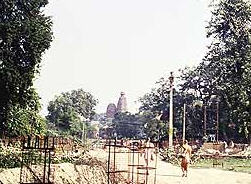
Walking on the old river bed bring us to a place where one of the Yamuna branches flows today.
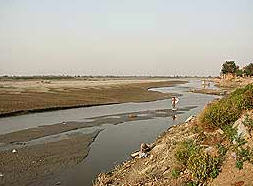
Imli-tala “Imli” means “tamarind” and this tamarind tree dates back as far as Lord Krishna’s times, five thousands years ago. Krishna would come here on the bank of the Yamuna and because of His ecstatic feelings of separation from Radharani, His blackish body would turn golden.
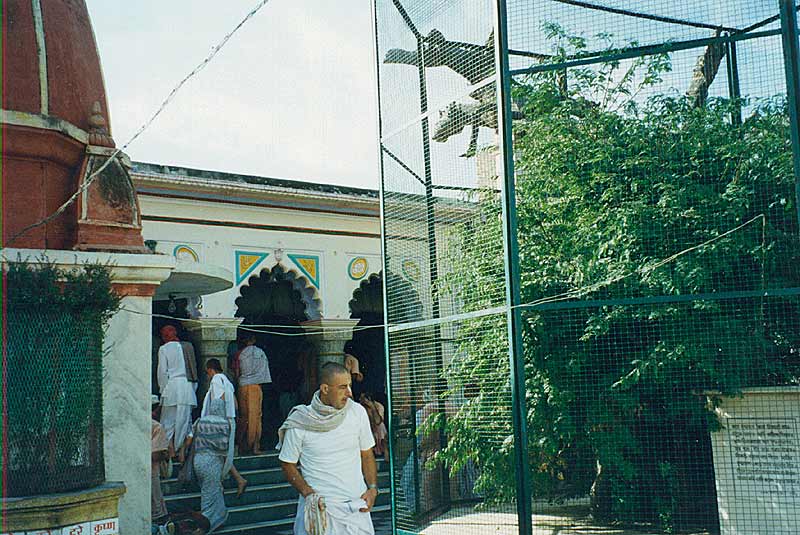
Gauranga Mahaprabhu also came here and meditated upon Krishna. Due to ecstatic love, His golden body would turn blackish.
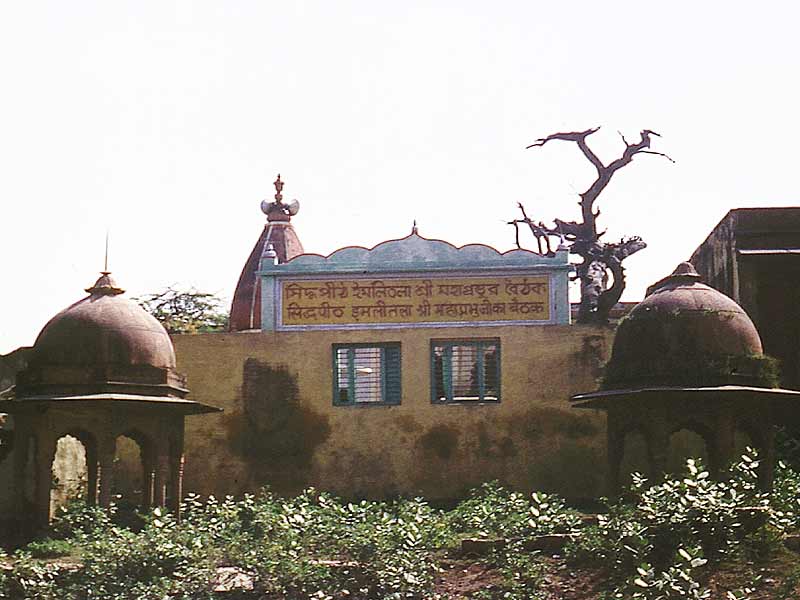
The old tree is said to be cut by neighbours and blood was flowing from the tree instead of sap. Tree dried up, but another tree is growing there from its offshoot.
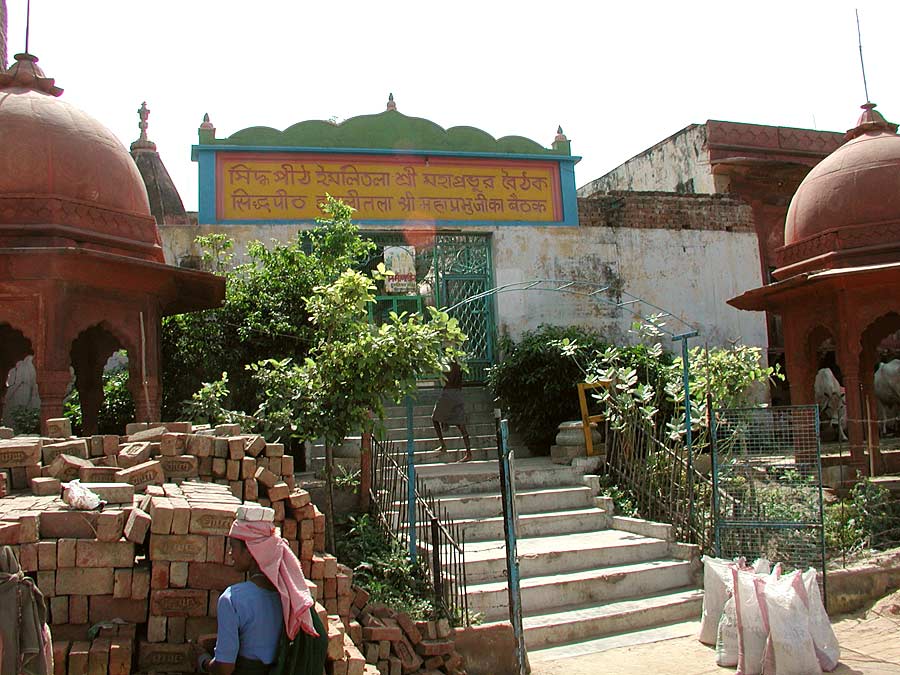

Beautiful Deities at Imli tala
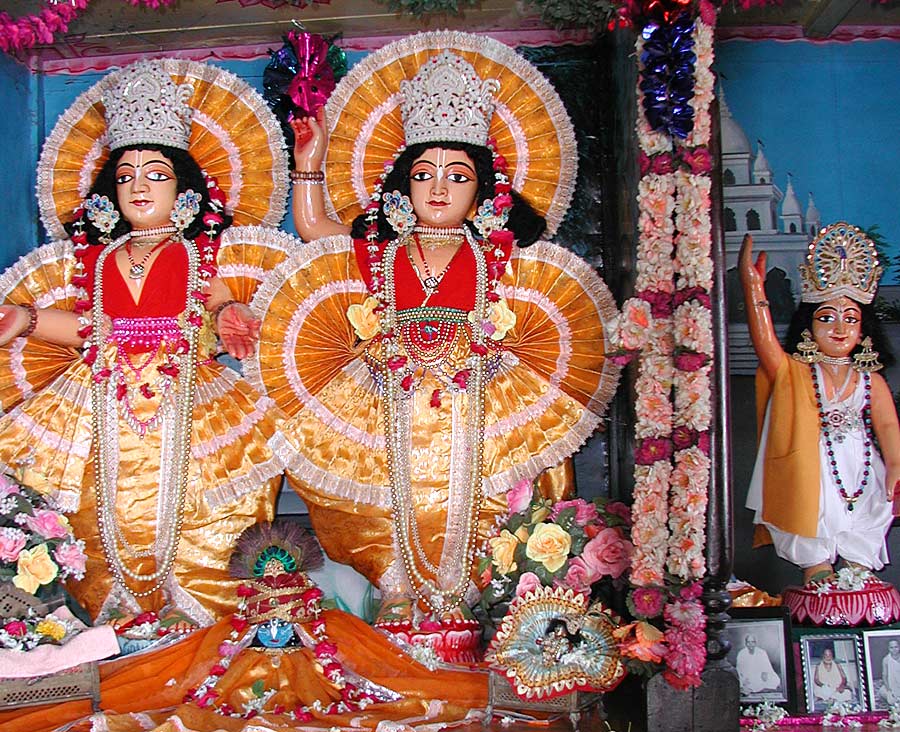
Gaudiya Math founded by Bhaktisaranga Maharaja (disciple of Bhaktisiddhanta Sarasvati) is present there today. His samadhi is just next to tamarind tree.
Sringar-vat (Nityananda-vat): During rasa-lila, when Srimati Radhika saw Sri Krishna dance with other gopis, She left rasa with mana. Wishing to hide Herself, She sat down in this solitary place.

Here Krishna personally decorated Srimatiji with beli, cameli and other flowers.
When the other sakhis searched for Krishna, one sakhi said: “Look! Krishna picked flowers here for His beloved, standing on His toes. The ground is marked with only the front portion of His feet!”

Krishna requested Radharani to quickly leave this place with Him, but She refused, saying She is tired. Krishna than requested Her to sit on His shoulder, but just as She was about to do so, He disappeared.
Distressed in separation, Srimati Radharani cried: “O master! My lover! O dearest, where are You? where are You? Please, mighty armed One! O friend, show Yourself to Me, Your maidservant who is very much aggrieved by Your absence.”Srimad-Bhagavatam 10.30.39
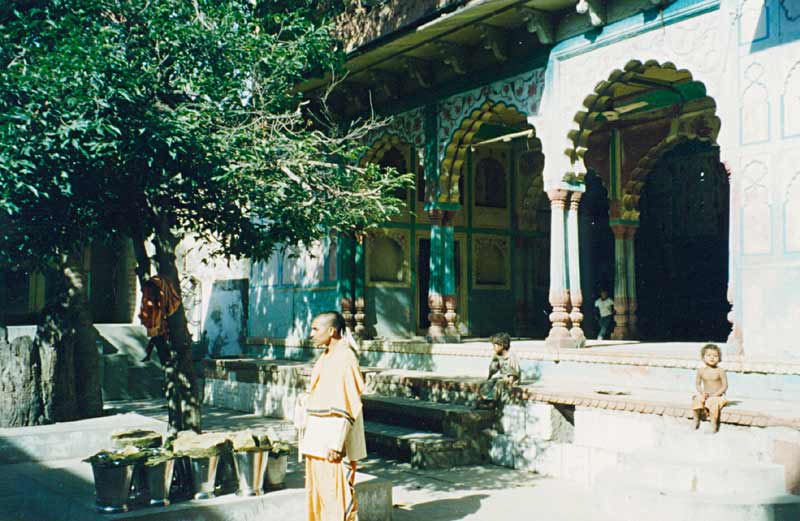
The original banyan (vat or vata) tree under which the Divine Couple sat has now almost vanished, as it was broken during the flood. A branch from the original tree were found on its way and planted here where it has grown into large tree.
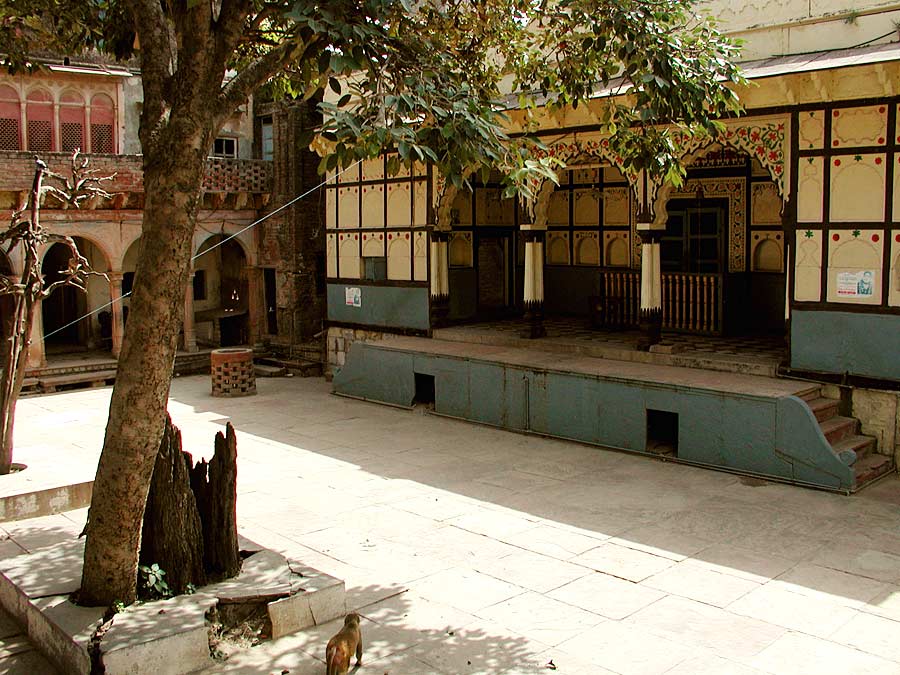
Nityananda Prabhu, while wandering throughout Braj, stayed near Sringar-vat absorbed in bhava. As Avadhuta, He was holding neck of cows and asked them: “Where is Kanhaiya? Where is He? One day, He heard a voice from the sky announced: “Your Kanhaiya is waiting for you in Nadia where He appeared as Sacinandana Gaurahari”. Sringar-vat is therefore also known as Nityananda-vat.
Jaru-mandala (Jhadu-mandala): Jaru-mandala means the area (mandala) swept with the broom (jaru) so that devotees could sit down and hear the stories.Long time ago, an old woman lived here. She made her living by grinding grains on the mortar. Because she was blind, she was doing it sometimes in day, sometime at night, since she could hardly tell what time it was. The gharr-gharr sound disturbed devotees.
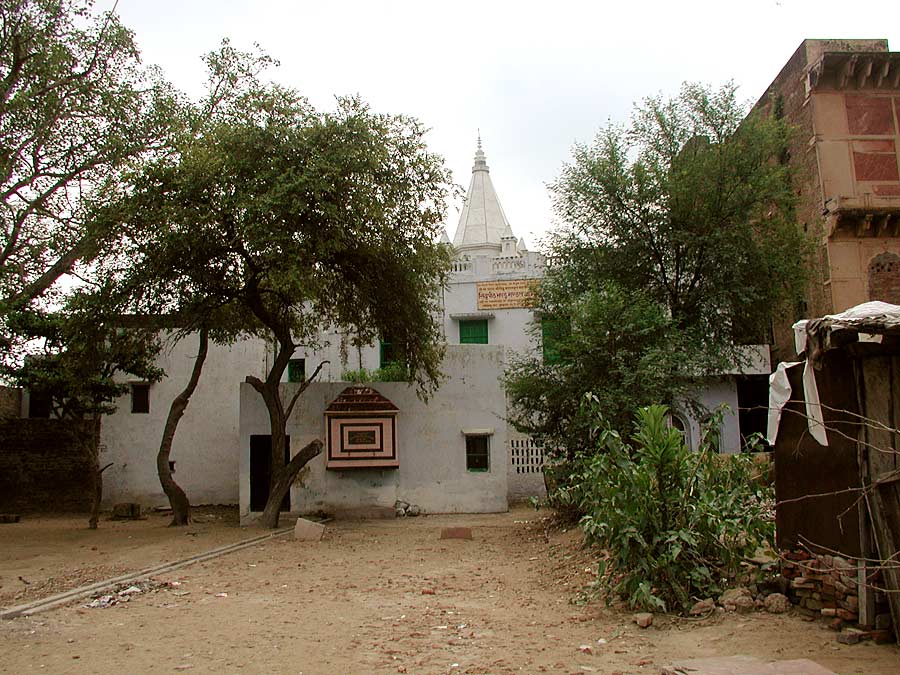
One day as she was grinding during brahma-muhurta, absorbed in singing the sweet names of Krishna, a beautiful dark-complexioned boy appeared and put one foot at her grindstone. “Mayya! Why are you constantly turning the grindstone and making this disturbing sounds?”
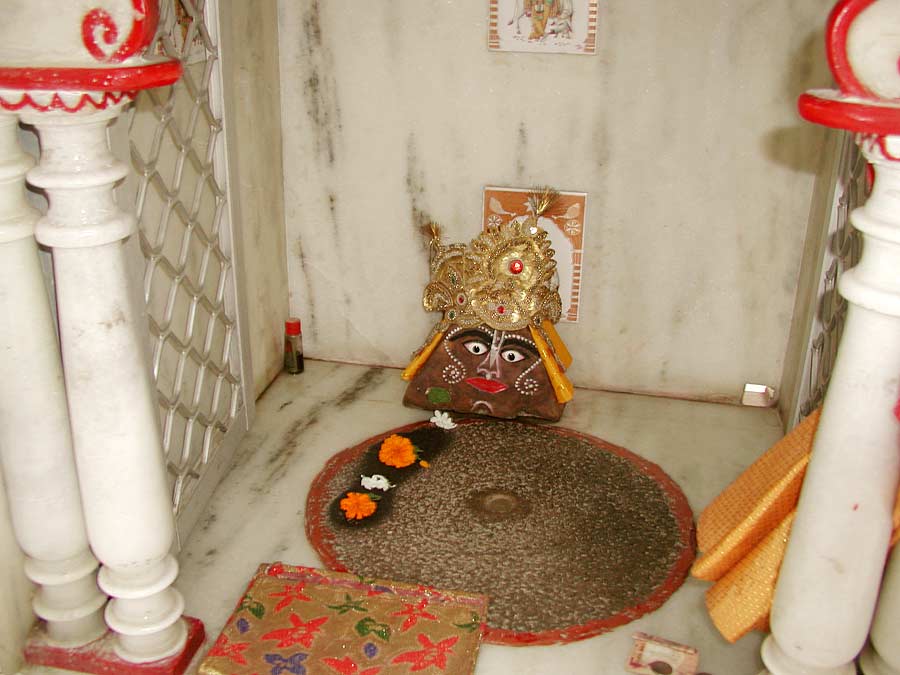
“My dear son, if I don’t work with the grindstone, then how will I maintain myself?”
The boy replied “I will put My footprint on your grindstone. People will come to take the darsan of this footprint and give generous donations.”
When she woke up, she understood that the boy’s footprint had appeared on her grindstone. She was able to maintain herself by donations from visiting people and she always remained intoxicated remembering this lila.
It is said that Jaru-mandala is the actual spot where Syamananda received a tilak mark from Srimati Radharani. Old Jamun tree mark this spot today.

Govinda-ghat: Here just next to Jaru-mandala, Sri Krishna disappeared from Radharani during rasa-lila.
. 
There is also an old Krishna Baladev temple on the opposite side of the road. With Nanda, Yasoda, Balaram and Krishna on the altar.
Cir-ghat (Cira-ghat)

According to Srila Jiva Goswami, the actual Cir-ghat is 10 km north of Vrindavan. But there is no harm remembering this intimate pastime in any place. At Cira-ghat there is ancient kadamba tree (Cir-kadamba).
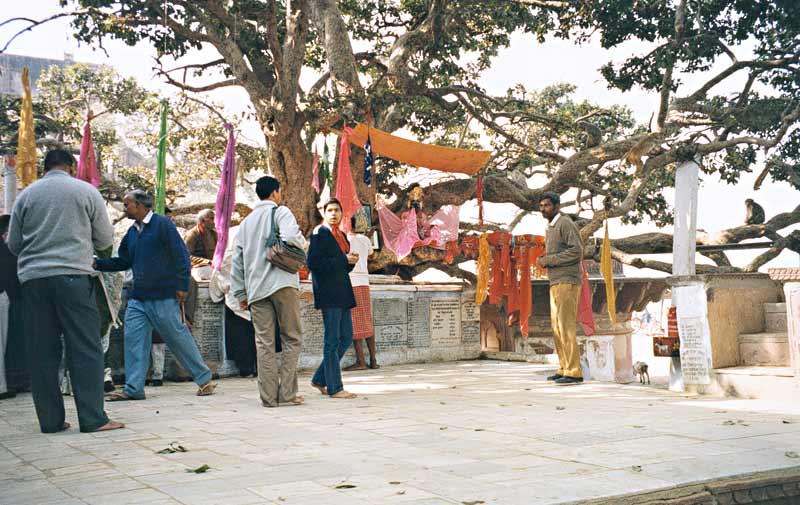 .
.
Krishna would climb on this tree and tied gopi’s dress on its branches. Pujari keeps remembering this lila until now and one can see Krishna’s Deity on the tree and gopi’s garments.

Gopis performed worship of Goddess Katyayani (Katyayani-vrata) to get Krishna as their husband and Katyayani gave them blessing that their desire will soon be fulfilled.
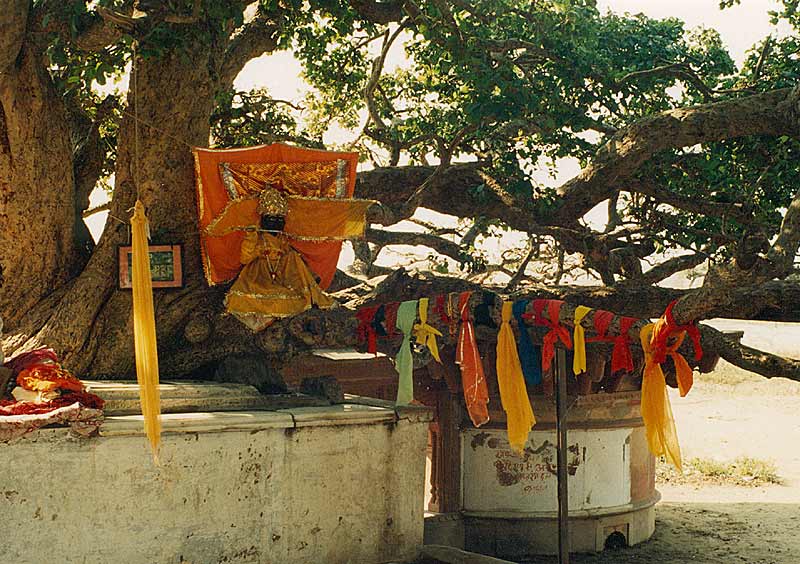
Nobody except one’s husband can see woman naked. Gopis were taking bath in Yamuna and Krishna stole their garments. They wanted them back but He demanded they came out of water and claim them. Since He saw them naked, it was as if gopis became Krishna’s wives.
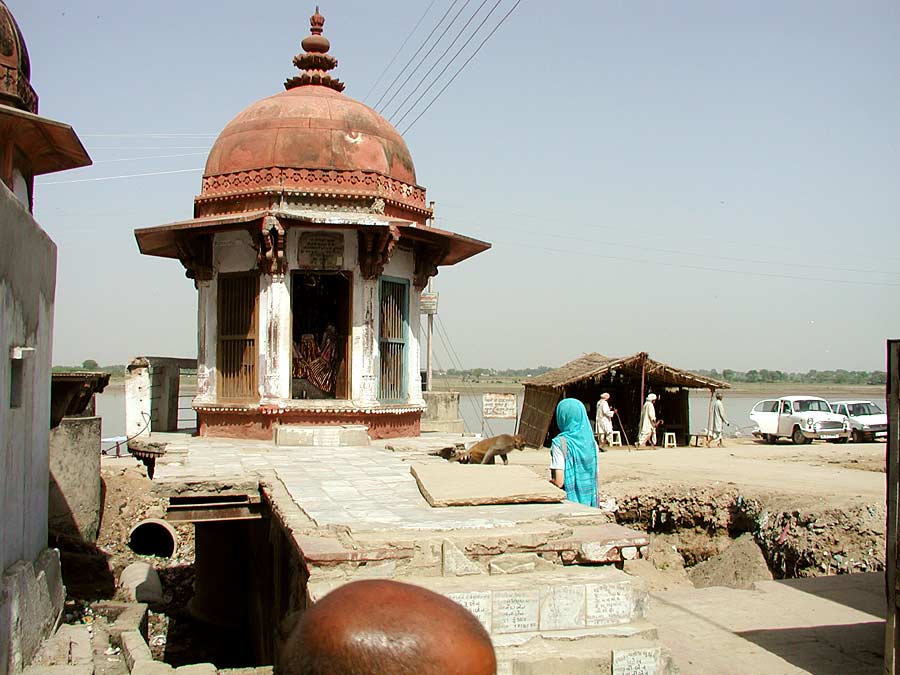
The Deity of Krishna and gopi’s garments on the branches commemorate this pastime today.
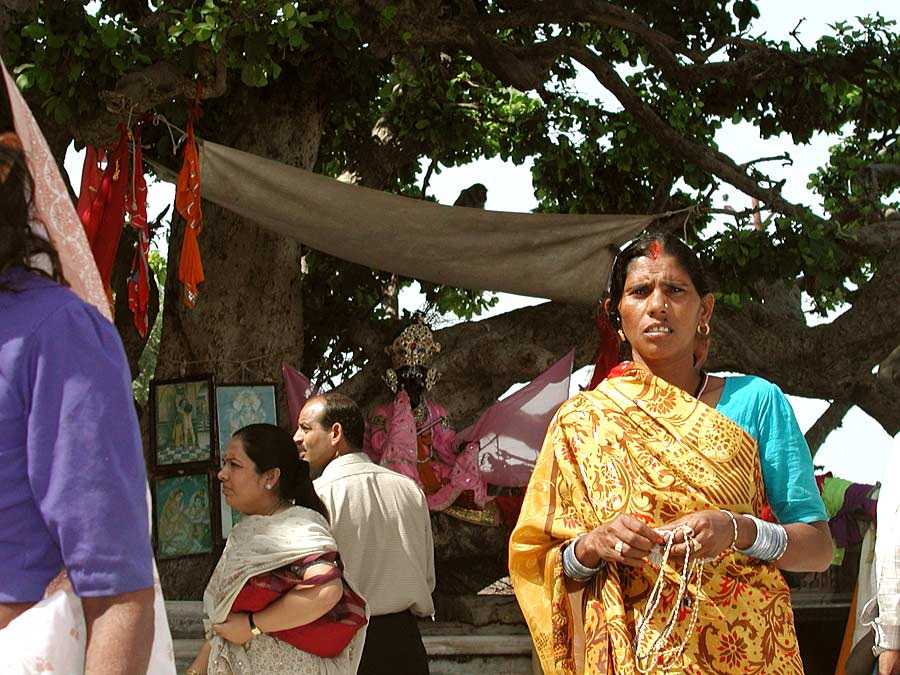
Yamunadevi
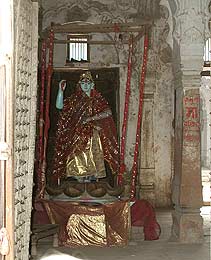
Yamuna Maharani is sri-krsna-svarupini, meaning that she is a manifestation of Visakha. She is bhagavati because she is dear to Krishna and she is krishna because she is blackish in complexion. Yamuna river is the most sacred river in India. The main reason for being sacred is because it flows through Vrindavan and Mathura, and was thus intimately connected to Lord Krishna’s pastimes.
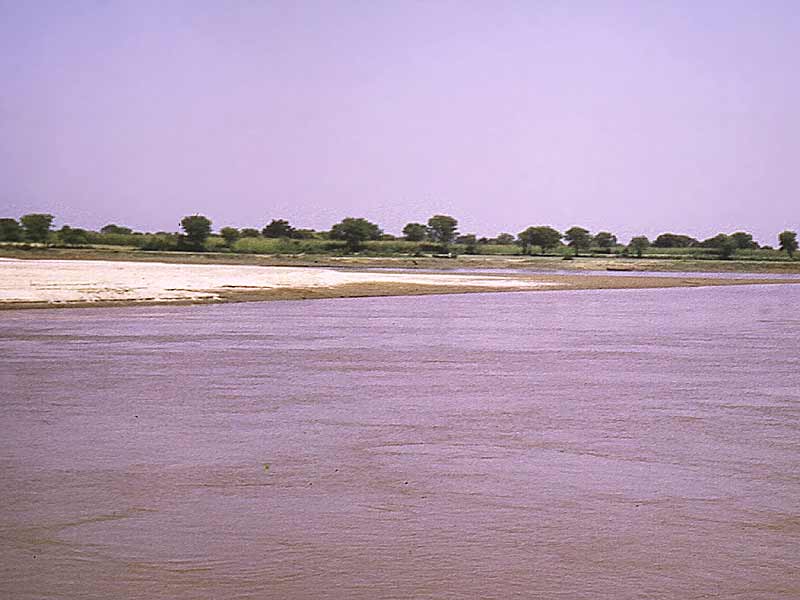
River Yamuna, Govardhan Hill and dust of Vrindavan are three things that remained unchanged from Krishna’s Vrindavan to these days.One who bathes in Yamuna can be purified of all sinful reactions and attain love of Godhead. Yamuna-devi assists the amorous pastimes of Radha- Krishna Yugala (keli-vilas). She flows on three sides of Vrindavan. She creates countless beautiful nikunjas with trees, creepers, flowers and fruits. Radha-Krishna performs jat-keli – water pastimes and nauka-vihara boat pastimes with sakhis. “I repeatedly offer prayers to Sri Yamuna, the daughter of the Sungod, who is the bestower of unnatojjvala-prema for cidananda-surya-svarupa Nandanandan Sri Krishna. She embodies transcendental bliss and directly personifies the melted form of Parambrahma.Simply remembering her destroys all types of wickedness and great sins, thus purifying heart. She bestows all auspiciousness upon the world and can bestow braja-rasa into dry, desert-like hearts. May that Yamuna-devi purify us.” Yamuna-pranama, verse 1. The temple tower resembling Madanmohan temple is abandoned Jugal-Kisor temple, sometimes called Kesi-ghat temple, as it is located next to this ghat.
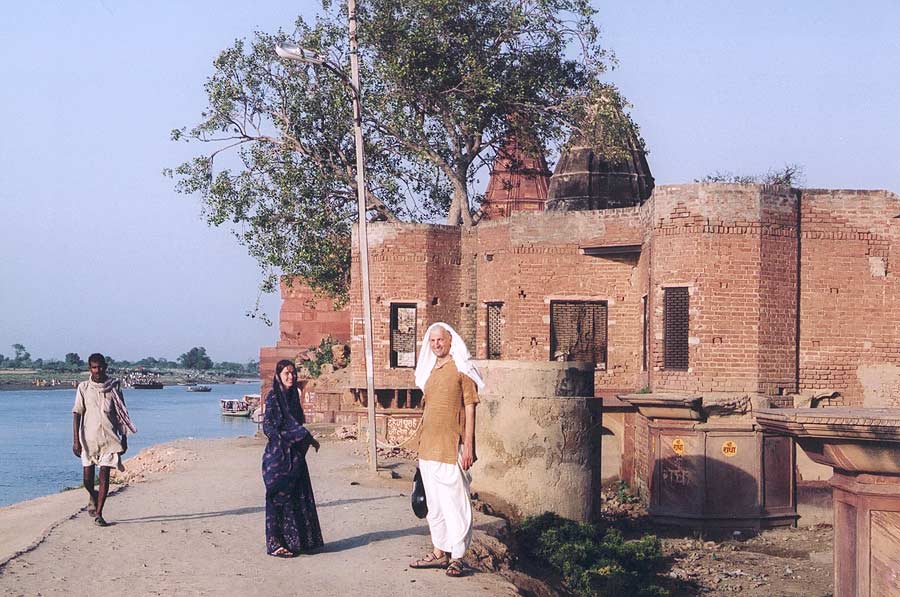
Kesi-ghat: Krishna and His sakhas were grazing the cows there. Madhumangal joked with Him, “Dear Sakha, if You give me Your peacock feather, sweet flute and yellow garments, then all the gopas and gopis will love me and feed me delicious laddu.
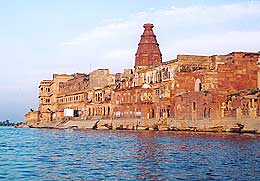
Nobody will even ask You if you would like some.” Smilingly, Krishna personally dressed Madhumangal up in His peacock feather and yellow garments and handed him His flute and staff
Now after dressed up, Madhumangal began to walk about here and there. Meanwhile Kamsa asked powerful demon Kesi to assume the form of huge horse and told him: “Whomever you see wearing a peacock feather on his head and yellow garments, and holding a flute in his hand, know that person to be Krishna for certain and kill Him”. Upon seeing Madhumangal dressed as Krishna, Kesi attacked him with his two hind legs.
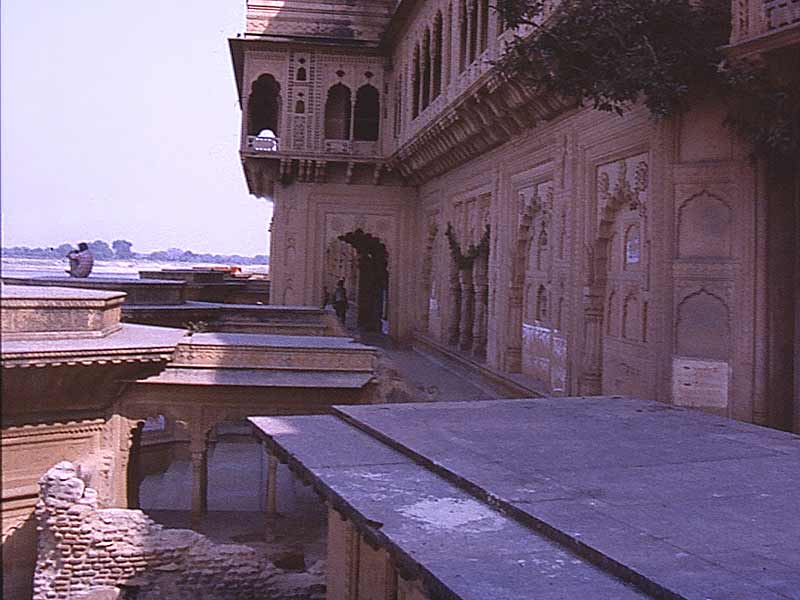
Krishna quickly came to save Madhumangal and killed Kesi demon. Although the demon’s legs didn’t touch Madhumangal, the brahmana boy lost consciousness just by the breeze created by the movement of Kesi’s legs. After Krishna killed Kesi, however, Madhumangal became embarrassed. He went to Krishna and handed back His flute, peacock feather and yellow cloth. He told Him, “I don’t want any laddus. My life is worth of lakhs of laddus.” The cowherd boys began to laugh.
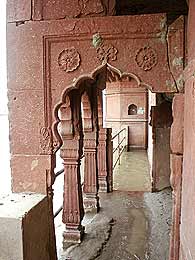
All devotees and saints performing Vrindavan-parikram had to go through narrow passage on Kesi-ghat. It is really heart touching to walk on the same path taken by great Vaisnavas.

There is Yamuna arati performed here every day at sunset.

River bed is sometimes full of water, but in other times it may look quite different.
. 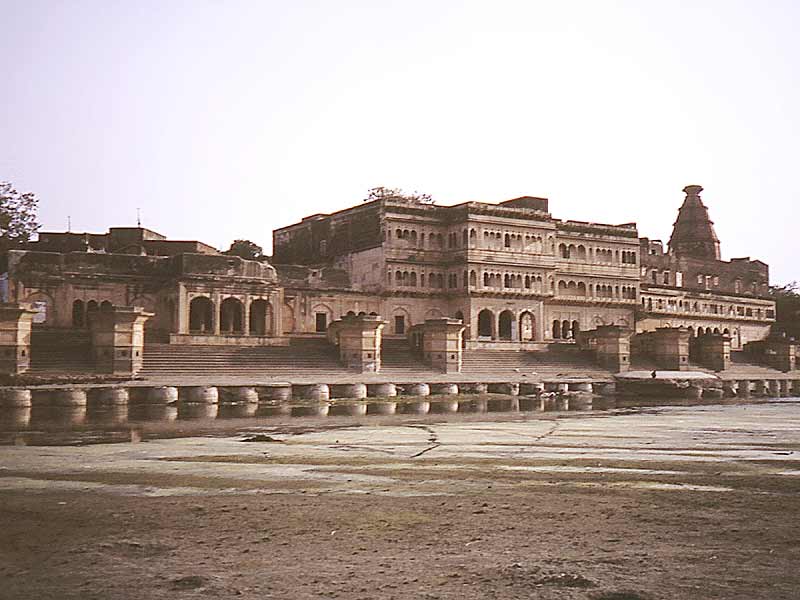
Kesi-ghat from the other bank

If you bathe here, you get the benediction of bathing in all of the holy places.

No bridge is nearby. One has to take boat to get to other side.
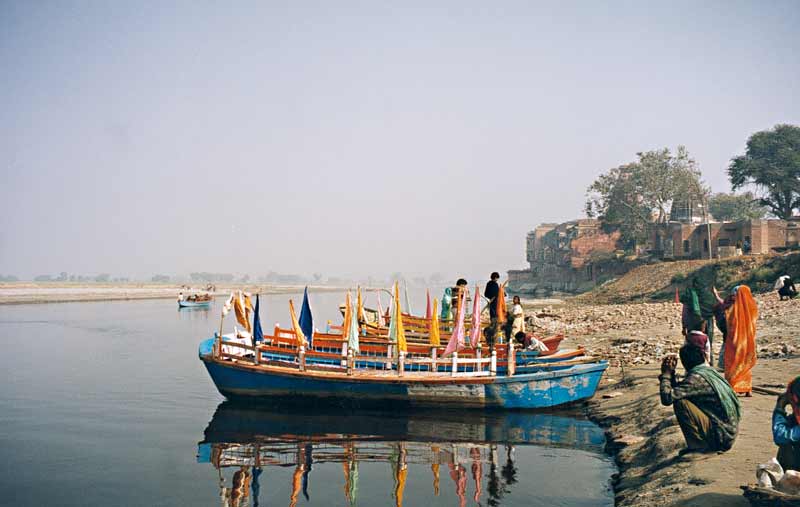
Jagannath temple:
Haridas, a Ramanandi-vaisnava, devoted to Lord Krishna, used to meditate on the bank of Yamuna near Vamsi-vat. In a dream, Lord Jagannath appeared to him and told him his desire to be worshipped in Vrindavan. He told Haridas to go to Jagannath Puri and bring the old Jagannath Deity that was this year to be replaced during rejuvenating ceremony.

Haridas gathered disciples and with loud sankirtan headed towards Puri. When he arrived, he went straight to main Jagannath temple and requested pujaris to allow him to take replaced murti back to Vrindavan. The priests refused and send him directly to the king who was in charge of the temple. But even the king refused his request, saying that the murti must be buried in the ground.
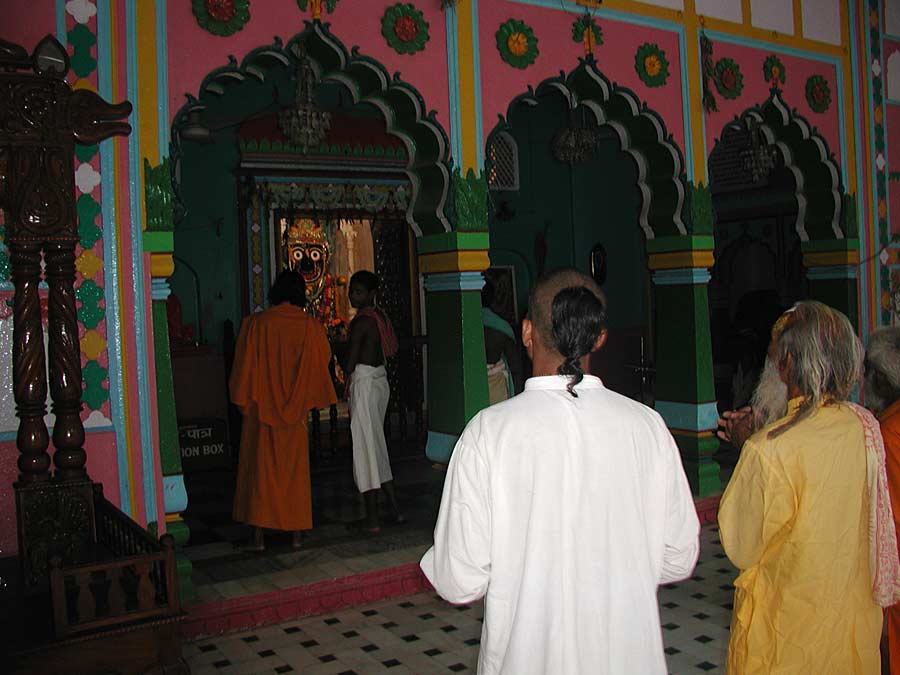
Haridas became hopeless and decided to stay at the beach and fast until death. That night Jagannath appeared to the king and angrily asked the king why he refused to Haridas’ request which was His order.
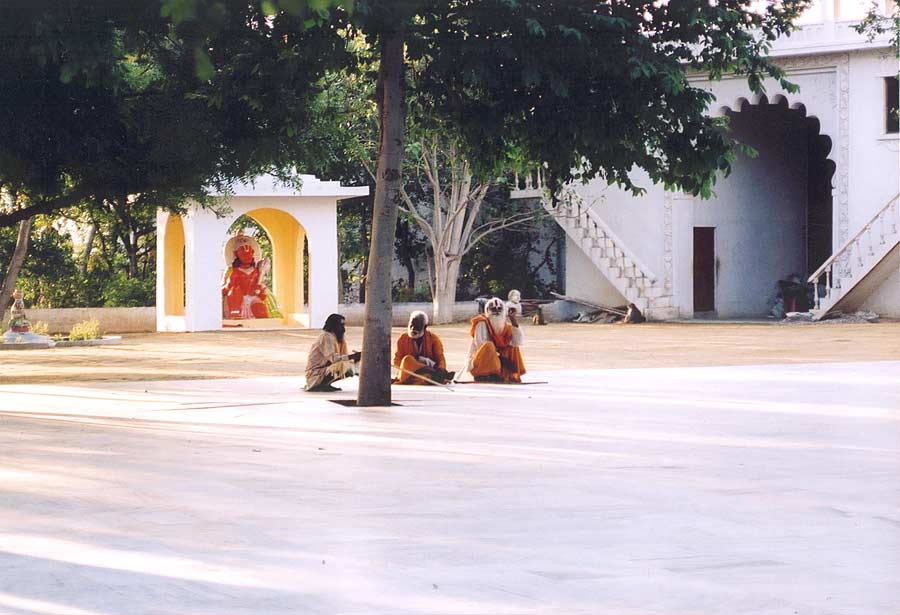
Upon waking, the king immediately called for Haridas and granted him the permission to take old Jagannath’s Deity back to Vrindavan. Jagannath, Baladev and Subhadra with the contingent of soldiers and priests were on the chariot brought to Vrindavan and installed on the bank of Yamuna at this place, which became as Jagannath ghat.
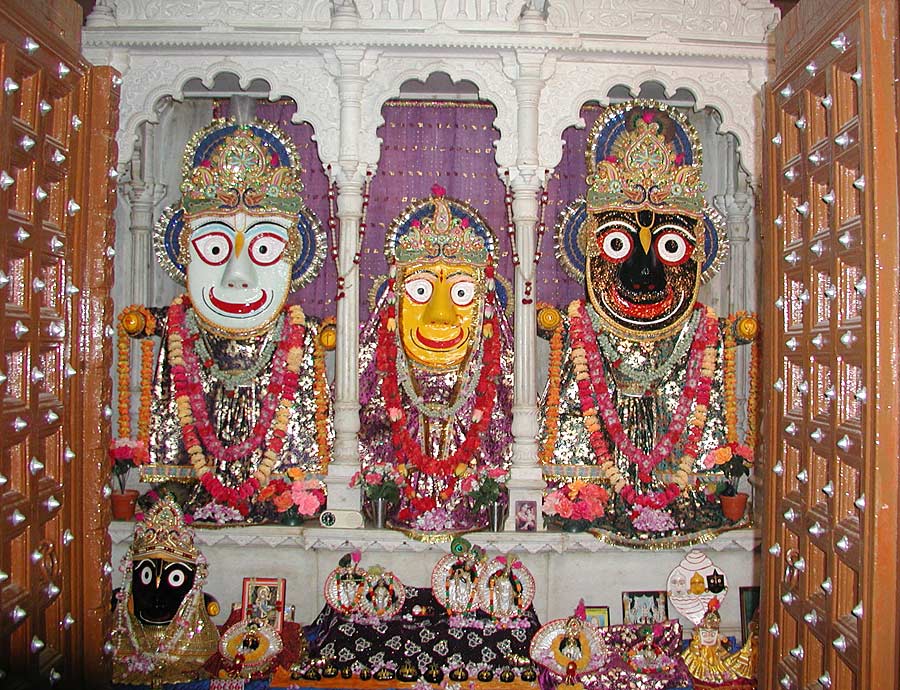
Pani-ghat: At the time of Krishna’s pastimes, Maharisi Durvasa had his asram on the opposite side of Yamuna near Pani-gaon. Gopis of Vrindavan wanted to please him by delicious food. Yamuna was in flood due to the monsoon and nobody had the courage to take them to the other side. Suddenly, Krishna appeared and smilingly asked them what troubles their mind?
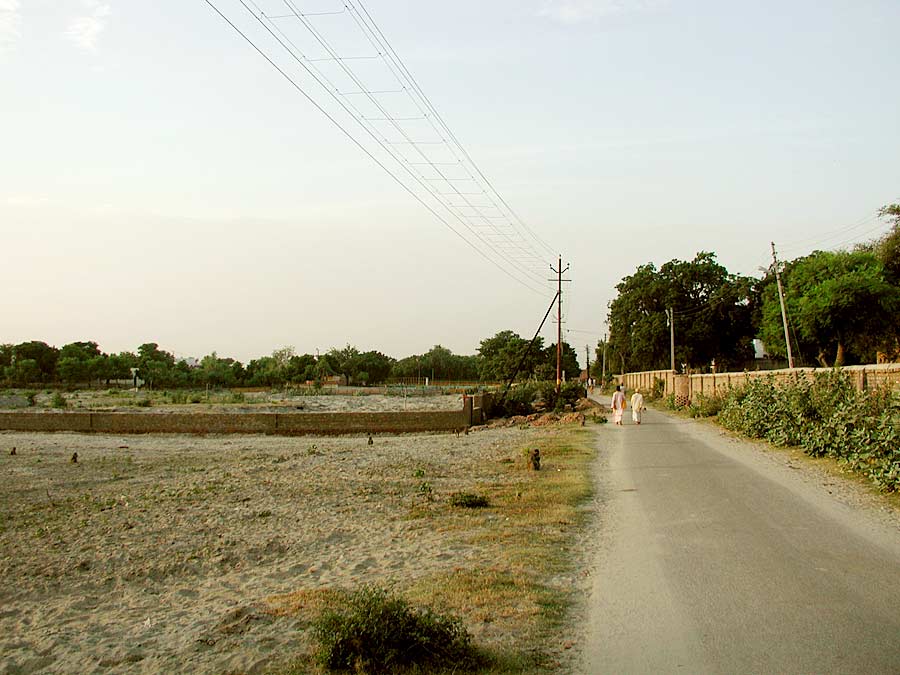
They told him about the flooded river. He replied: “Go to Yamuna and declare ‘If Krishna has not seen the face of any woman, then on the strength of his being brahmacari (celibate), you may cross the river on foot”. The gopis did as Krishna told them and to their surprise, Yamunadevi immediately parted her waters and allowed the gopis to cross on foot.
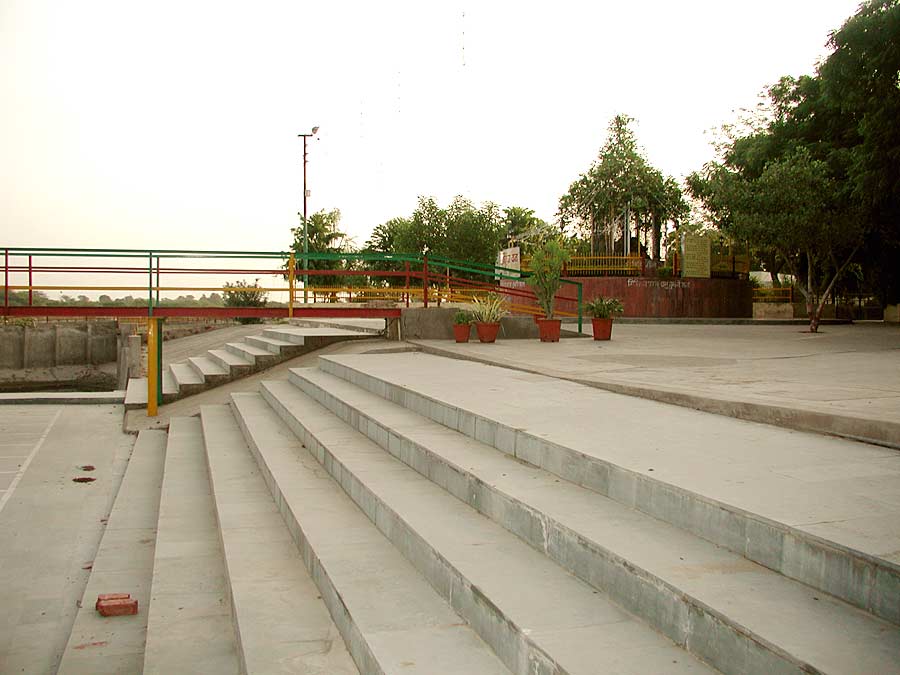
They have satisfied the sage with huge quantities of delicious food. Durvasa Muni blessed all the gopis and gave Radharani special benediction that whatever She cooks will taste like nectar and whoever eats Her food will achieve a long life and will never get sick. This is the reason why Mother Yasoda would ask Radharani to cook daily for her son Sri Krishna.

When they were ready to return, Durvasa Muni sensed their worries and said: “Tell Yamunaji – ‘If Durvasa has not eaten any food, then on the strength of his austerities, may we cross over your waters”. And again Yamuna granted them the passage.

They inquired Krishna about this mystery and He replied that, “Because I do not possess bhokta-abhimana (identity of being enjoyer) my brahmacarya remains intact even though since My birth, I was surrounded by women and stay with you every night. Similarly Durvasa is free from bhokta-abhimana and although he ate everything it was as if he has eaten nothing.
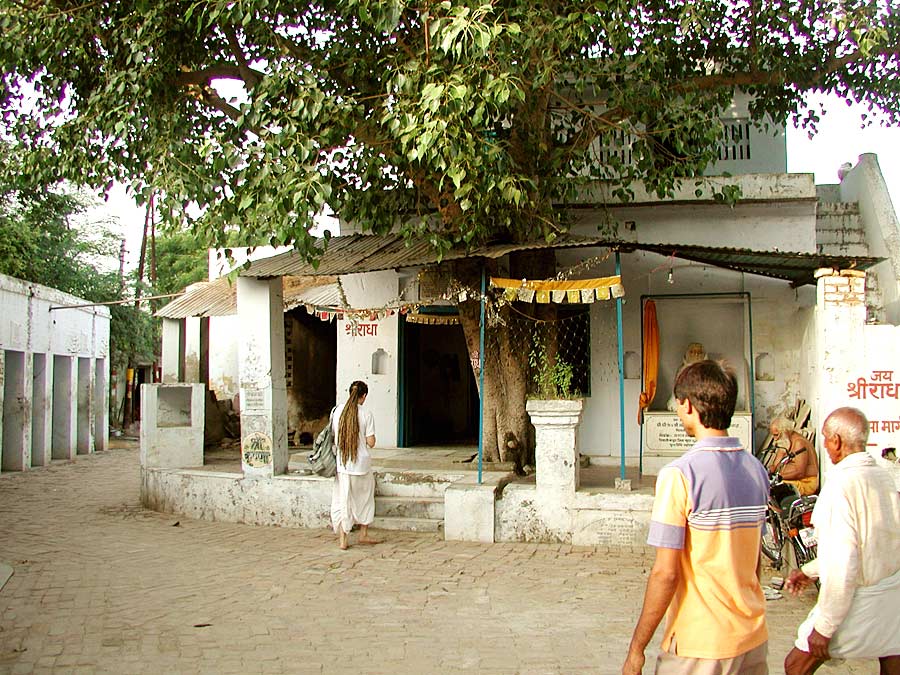
Passing Adi badri ghat where Vyasadev wrote the tenth canto of Srimad-Bhagavatam. Raj-ghat is the place where Krishna disguised Himself as a boatman. He was demanded to wash Radharani’s feet and then wanted to be fed by all the sweets they were carrying.
Sri Caitanya-visram-sthali
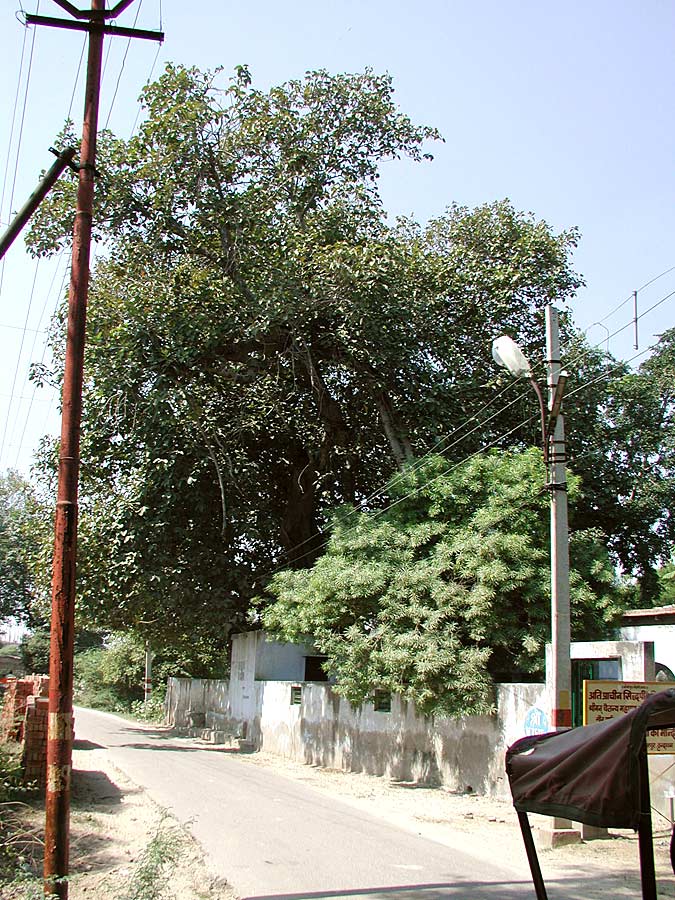
Lord Caitanya used to sit beneath this banyan tree at Raja ghat.
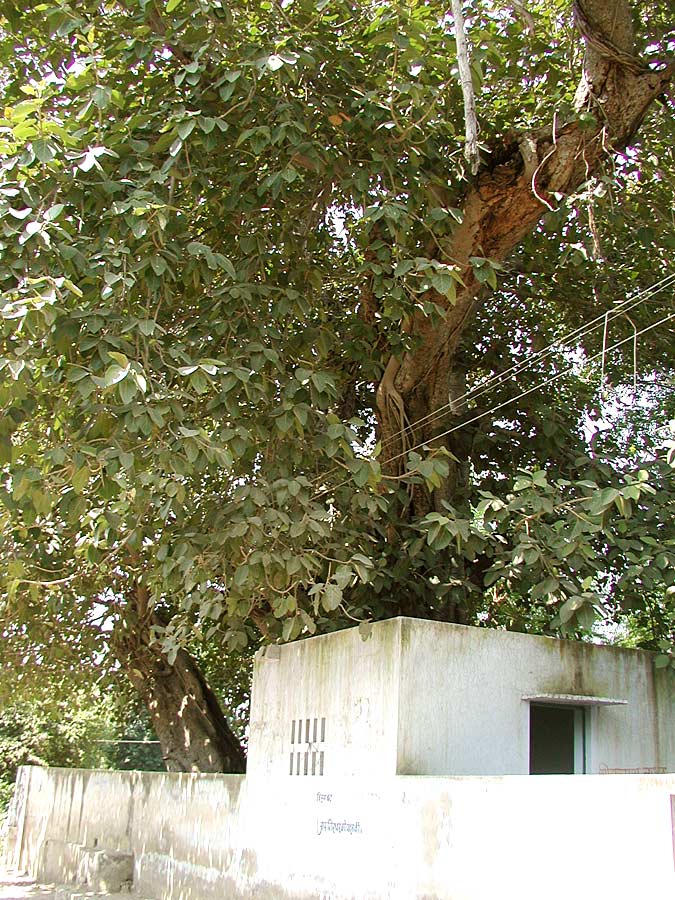
In small kutir, there is a Deity of Sri Caitanya

Nearby, the temple of Lord Jagannath.
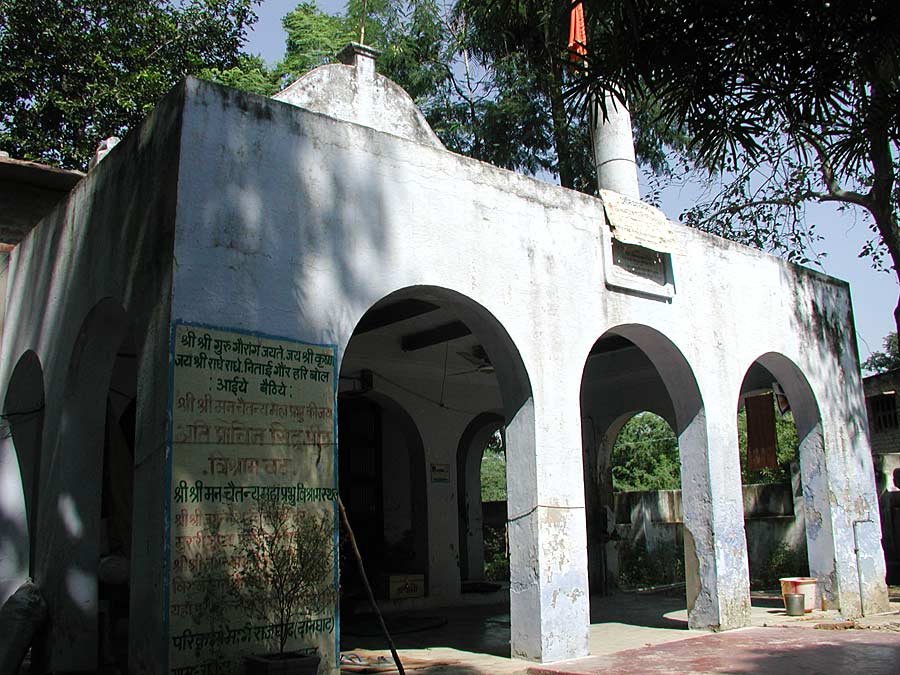
It is believed that the Jagannath Deity was worshipped by Murari Gupta.

When Sri Caitanya Mahaprabhu came to Vrindavan via Jharikhanda path, there was no village, it was only a deep forest.

At night, He resided at Akrura-ghat and at dawn, He would sit at Imli-tala on the bank of Yamuna.
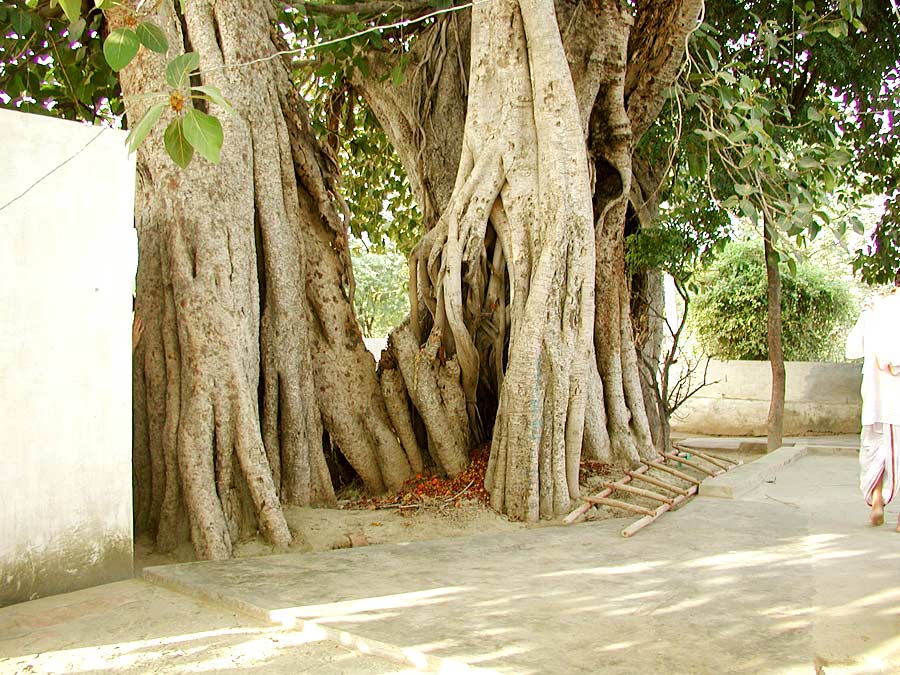
Mahaprabhu would chant harinam until the third praharain afternoon.
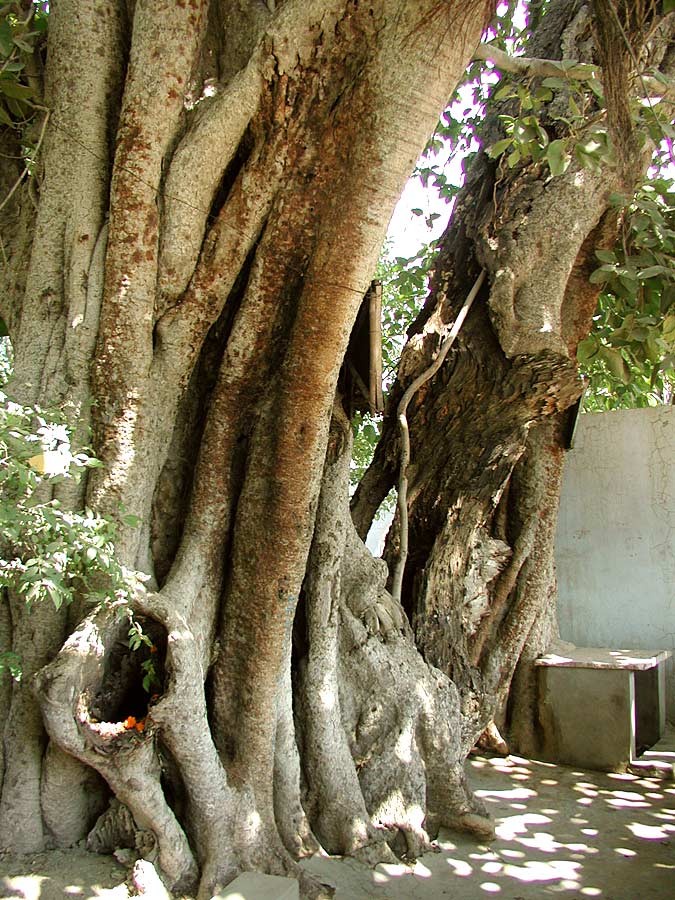
Sri Balabhadra Bhattacarya was the only person with Him at this time.
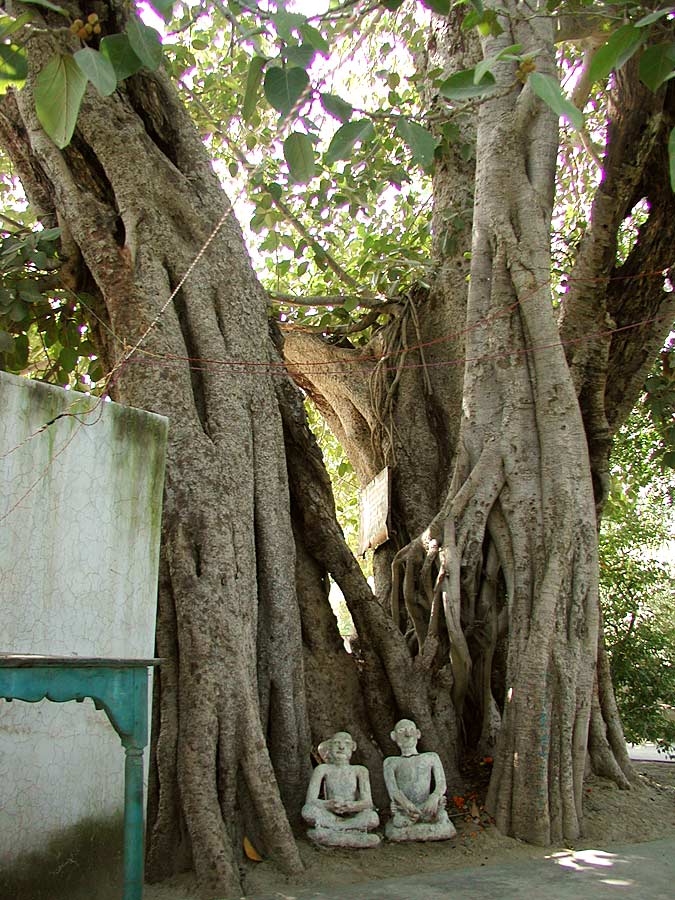
Radha-kupa: Radharani’s well where pilgrims loudly call Radha’s name that comes back with echo.
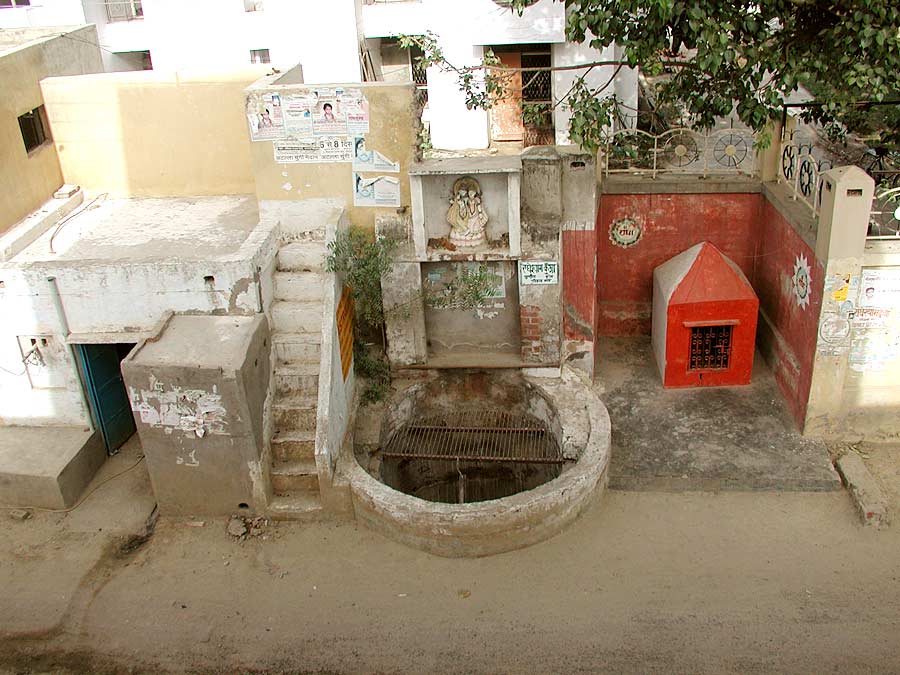
Parikram is completed. By circumambulating the temple of the Lord, one becomes freed from innumerable sins. By circumambulating Vrindavan one automatically circumambulate 5000 temples at once. Brajbasis usually go on parikram on Ekadasi. As they say the benefit of circumambulating Vrindavan is much greater. It is believed that offences committed knowingly or unknowingly are washed away by circumambulating Vrindavan.

After Vrindavan-parikram, we will go to see other places inside the town area. Bhaktivedanta Swami Gate at the entrance of the town from Cattikara road welcomes you in.
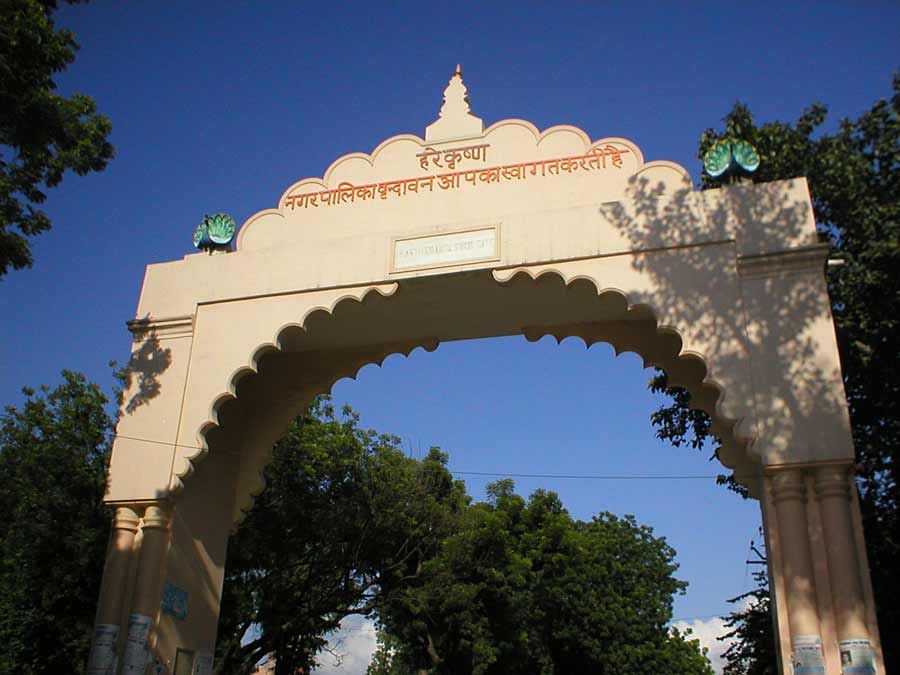
The first temple to your left is Krishna-Balaram Mandir founded by A.C. Bhaktivedanta Swami Prabhupada.
Vrindavan Research Institute and Library stores some of the original manuscripts as well as historical documents and records.

Handwriting of Sanatan Goswami:

Handwriting of Rupa Goswami
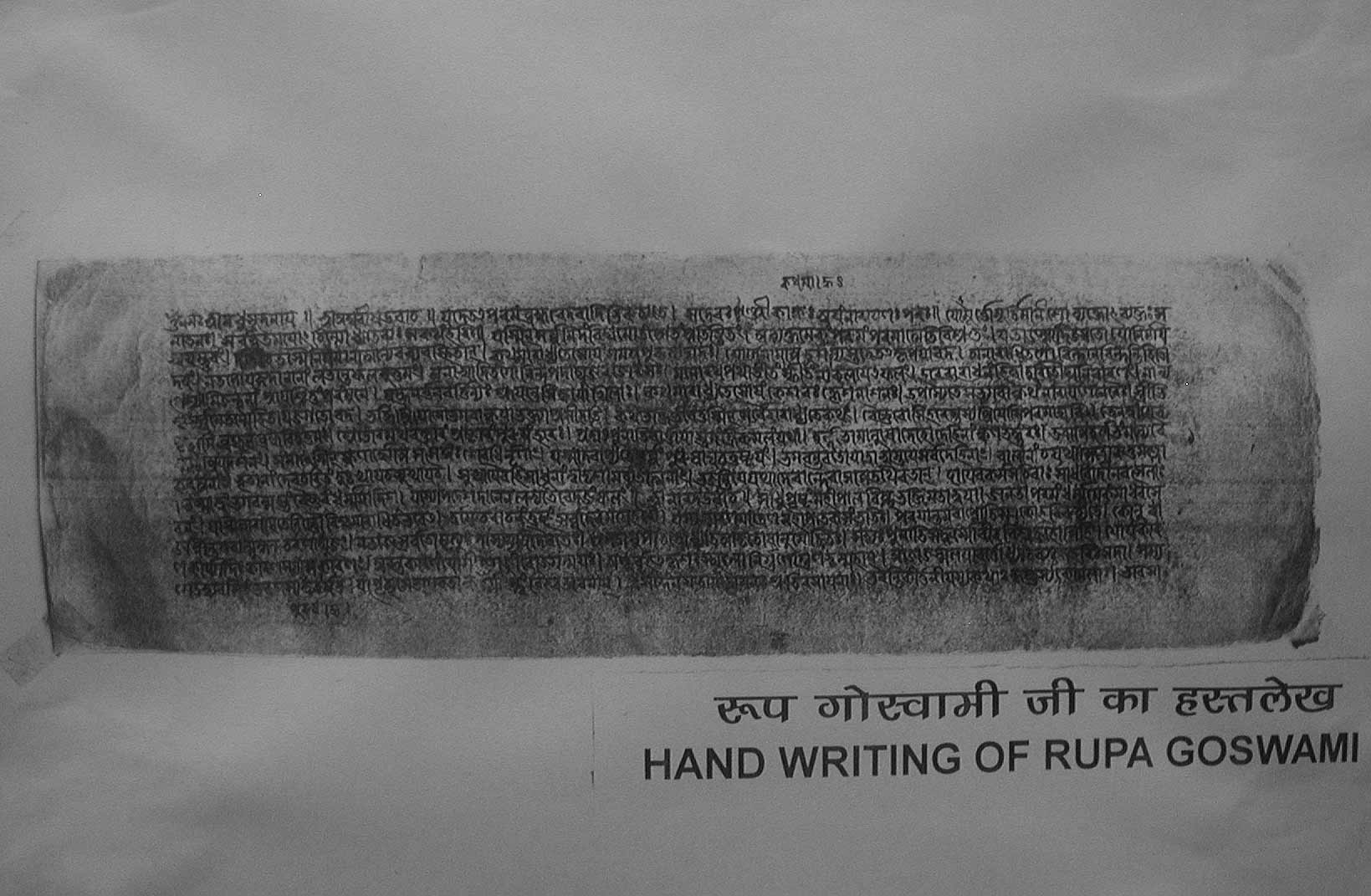
Handwriting of Jiva Goswami

Davanala-kund: On the day Krishna subdued Kaliya, cowherd boys could not return to their residences at Cattikara as night was approaching and they had moved from the poisoned Kaliya-daha to a sarovara further to the east. The servant of wicked Kamsa set surrounding forest ablaze in all directions. Fire was overwhelming and Krishna told everyone to close their eyes.
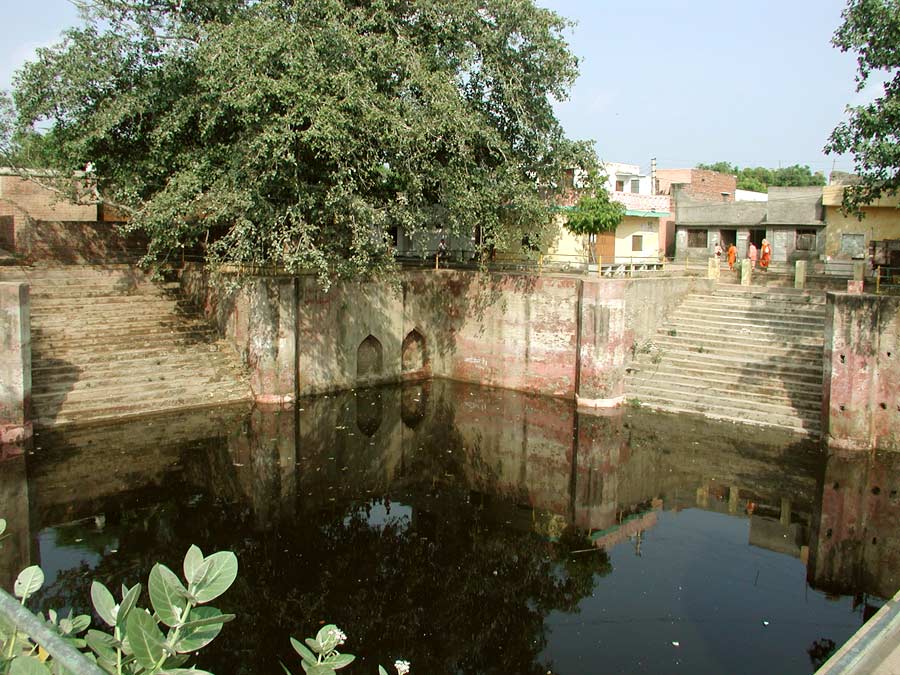
He also closed His eyes and at once swallowed the devastating forest fire as if it was cool water. The sarovara (lake) where this lila took place is called Davana-kund. “Davanala” means “forest fire”,

After extinguishing the forest fire, Sri Krishna rested at nearby Vishram-kund.
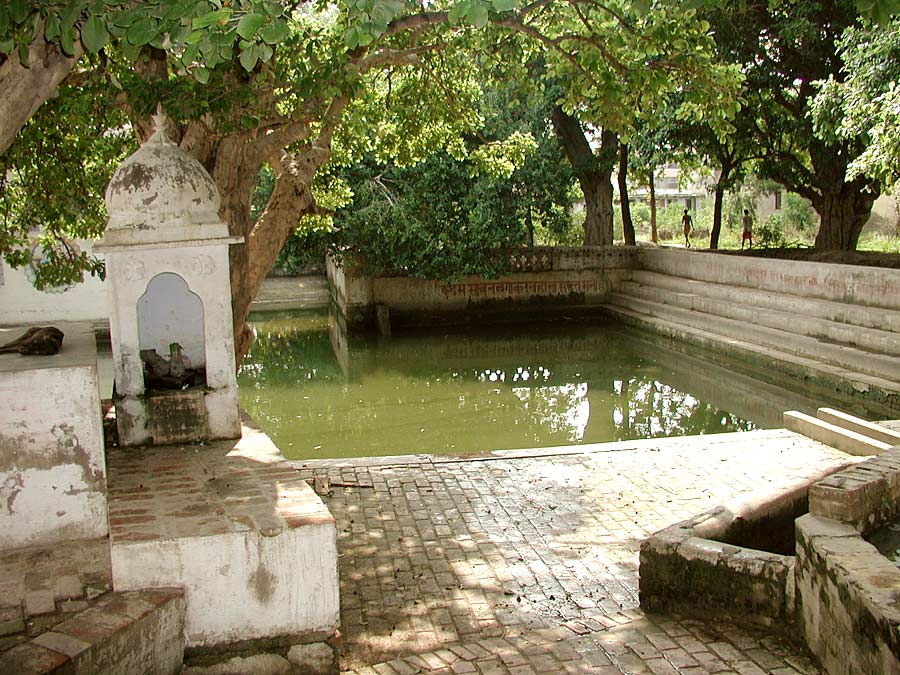
Govinda-kund: Krishna and Balaram used to rest at the banks of Govinda-kund in the middle of the day. The boys and their cows would drink clear water of this kund. Krishna’s sakhas would massage Krishna’s and Balaram’s feet while They rested.

It is the largest kund in Vrindavan and both Rupa and Sanatan stayed here for some time doing bhajans. It is usually dry and fills with water only during rainy season. Ghats were built by Bengal princes Candharani Kali-sundari from East Bengal.
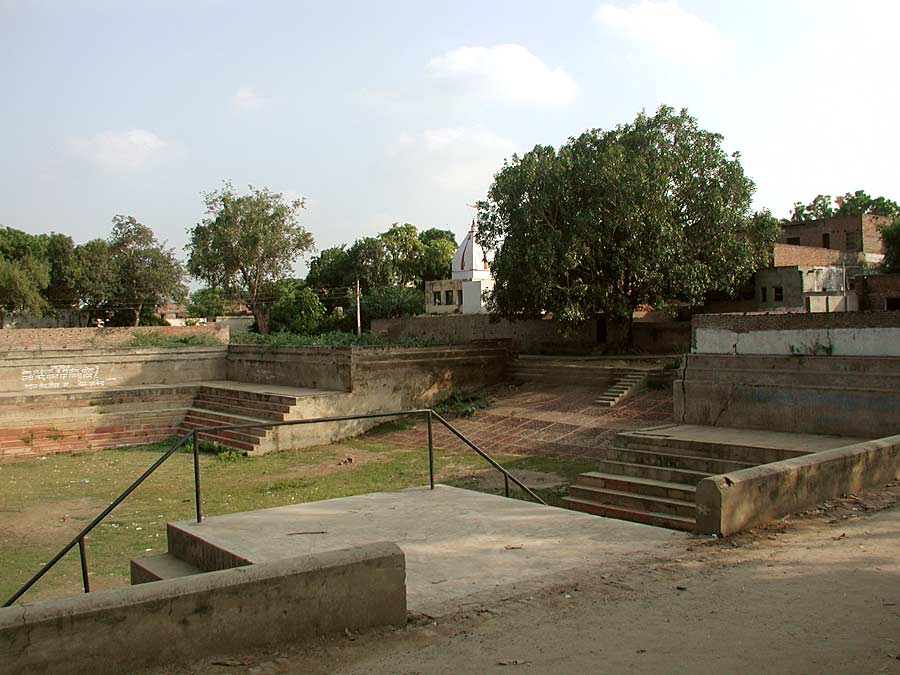
Katyayani Temple It is said that here the hair (katya) of Goddess Kali fell from the sky. Gopis used to make a Deity of Goddess Katyayani from sand on the shore of Yamuna, which is the local tradition during Katyayani-vrata, and worship her to get Krishna as their husband. The actual place where gopis used to worship Katyayani is Tapovan, 10 km north of Vrindavan near Cir-ghat.

Venu-kupa: In the corner of this garden, there used to be a pond. Krishna once dig with his flute (venu) in the ground and created a water spring so that thirsty cowherd boys and cows could drink it.
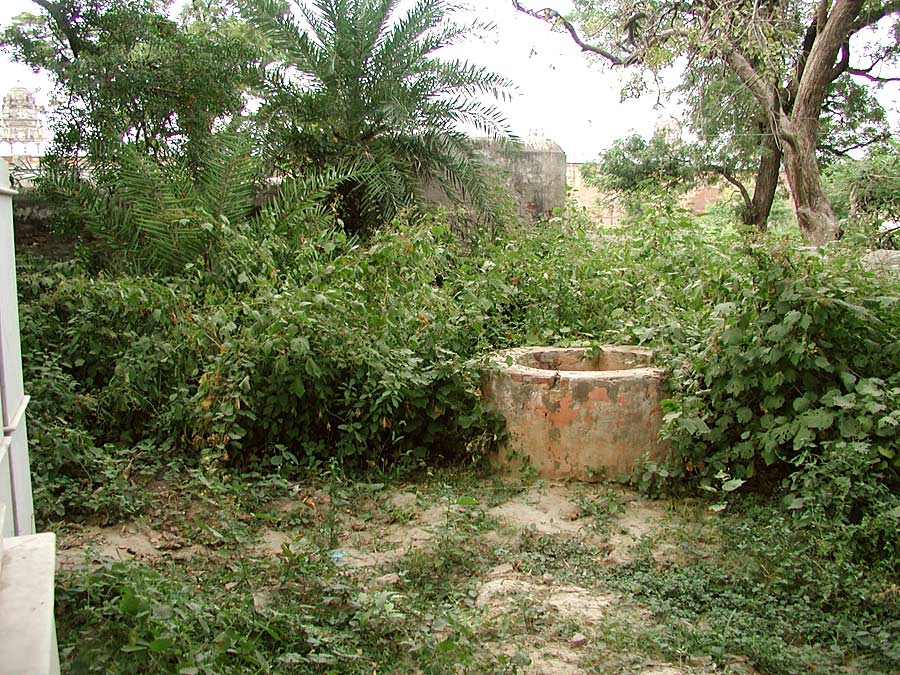
64 samadhis – Samadhi of Raghunath Bhatta Goswami: When Sri Caitanya stayed at Benares in the house of Candrasekhar, Raghunath Bhatta as a small child could serve the Lord by massaging His feet. Later, when Sri Caitanya met him in Puri. He was pleased to see him and ordered him to study and remain lifelong brahmacari. Raghunath Bhatta was an expert cook and sometimes he would cook for Sri Caitanya.
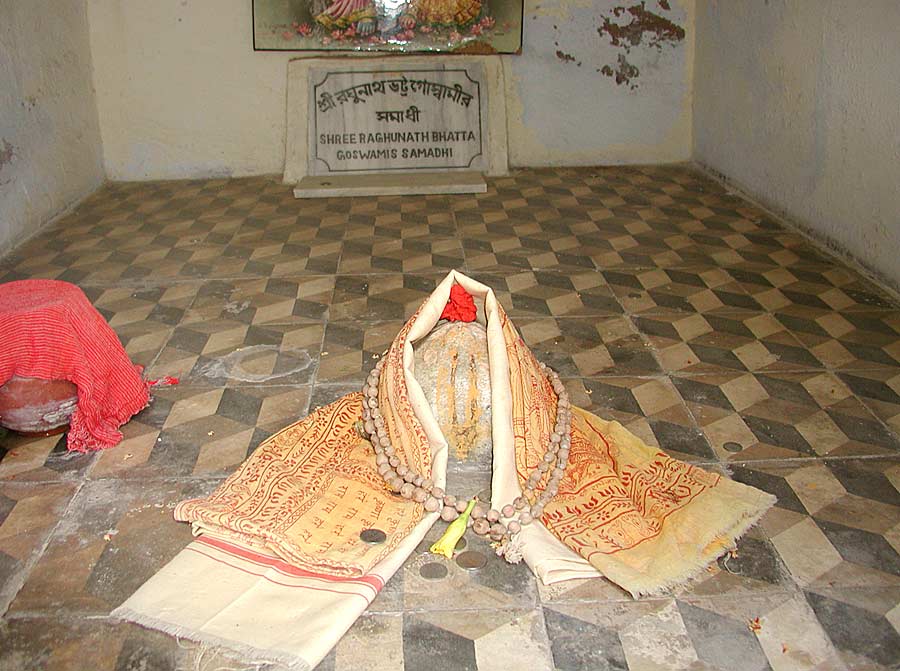
Raghunath Bhatta used to do bhajan in this very same garden and among Vaisnavas, he is very famous for his wonderful recitation of Srimad-Bhagavatam. He used to sing it in three different ragas (tunes). His fame spread wide and attracted Jaipur king Raj Man Singh to become his disciple. Maharaj not only constructed gorgeous Govindaji temple but many other temples and ghat’s as well.

Entombed here are the sacred ashes of Raghunath Bhatta’s body. Devotees have decided to cremate his body similarly as Raghunath dasa’s because they have feared desecrating by Mughals. Raghunath Bhatta is an incarnation of Raga-manjari, one of the eight intimate maidservants of Srimati Radharani.
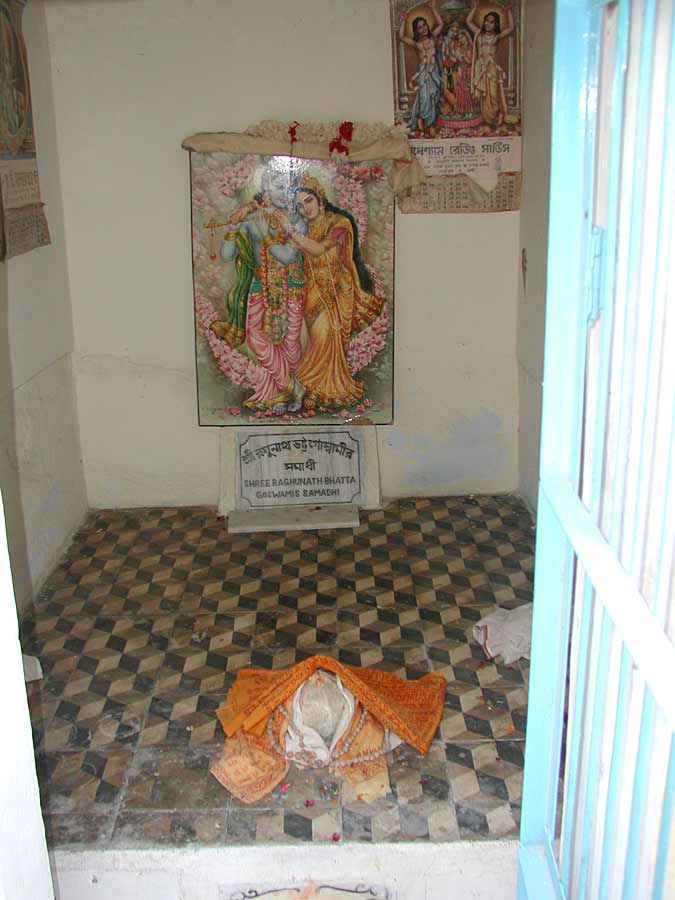
Raghunath Bhatta often recited Bhagavatam in front of Rupa and Sanatan and their samadhis are just next to his. His personal Bhagavatam can be seen in Bhattaji Mandir near Radha-Vallabha temple in Vrindavan. Raghunath Bhatta was also known for his aversion towards criticism of Vaisnavas. Even there were right reasons for criticisms, Raghunath was disinclined to hear even that saying that those who are engaged in devotional service will soon be purified.
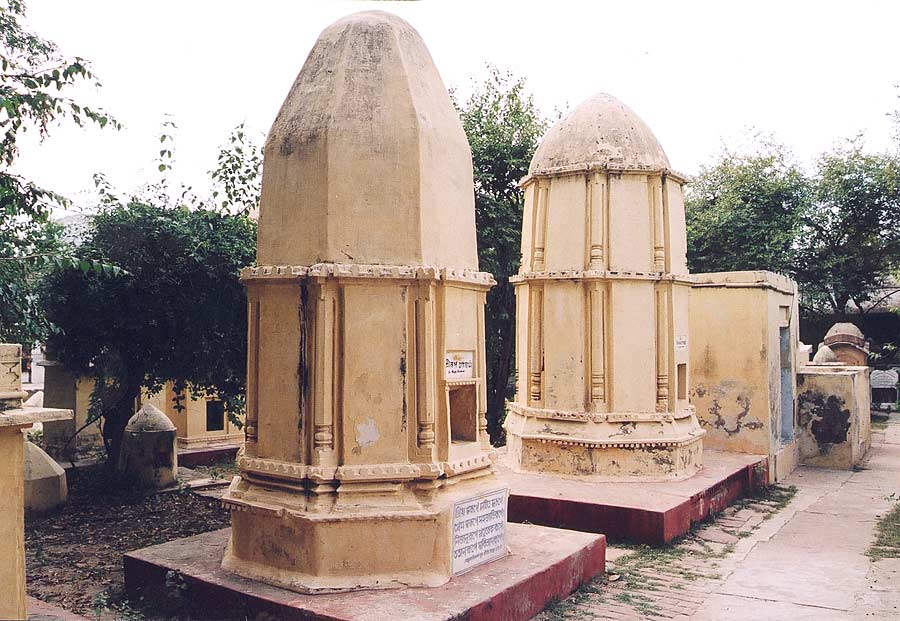
Samadhi of Kasisvar Pandit: Kasisvar was a disciple of Isvara Puri and as such a godbrother of Sri Caitanya. Isvara Puri sent him to serve Lord Caitanya to Jagannath Puri. Kasisvar was very tall and strong and his service was to pull away crowds in front of Sri Caitanya so that He could proceed further. With his hands he would protect the Lord like a bodyguard.
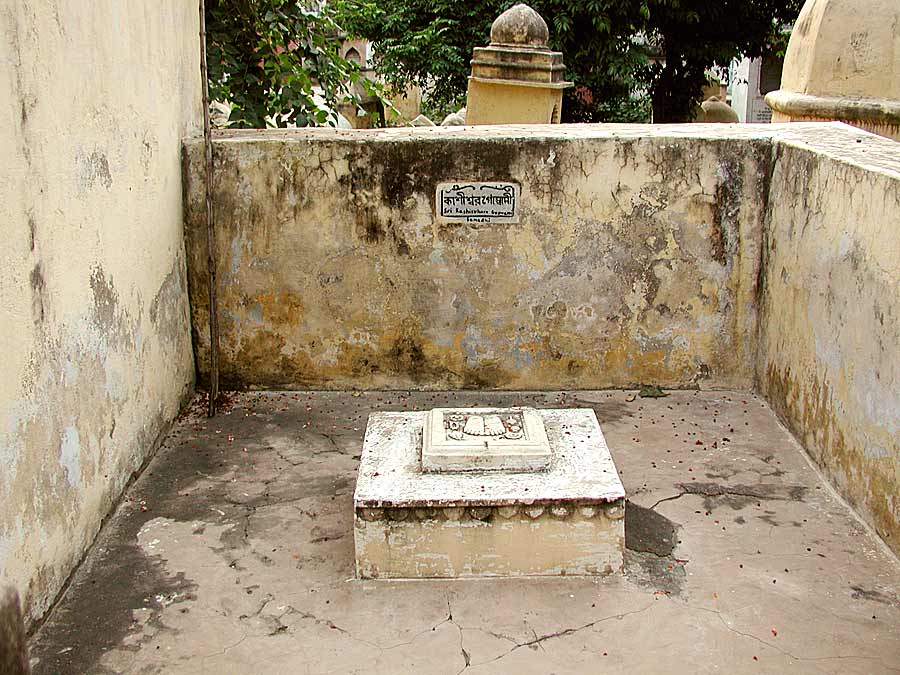
Kasisvar also liked to distribute prasadam to the devotees after kirtans and later Sri Caitanya sent him to Vrindavan to serve Govindaji Deity. He was an incarnation of Bhringara, Lord’s personal servant.
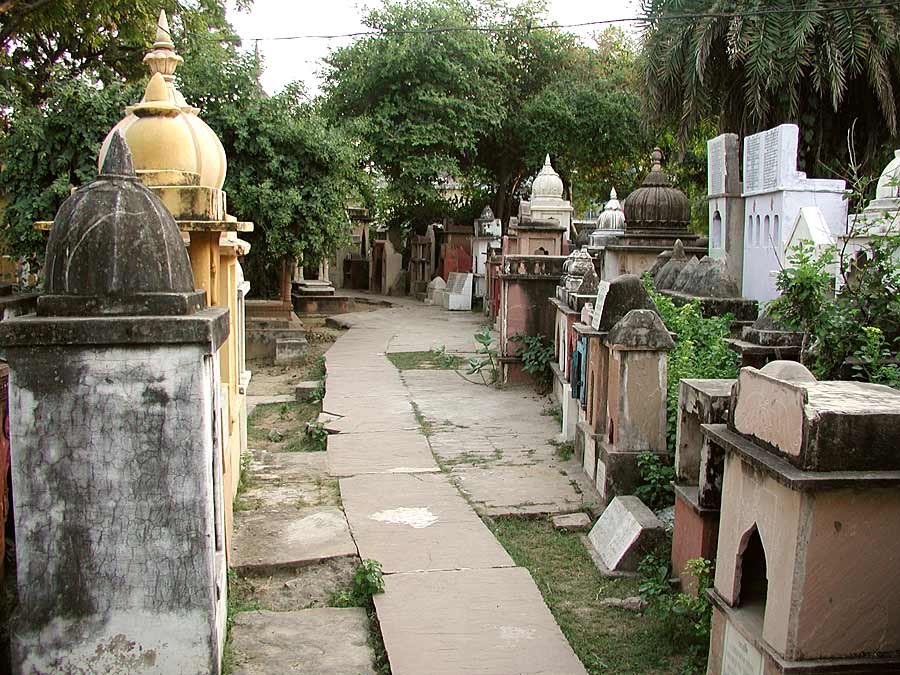
Samadhi of Subuddhi Raj: Subuddhi Raj was a landlord of Bengal. Once he punished Hussain Khan, a man responsible for construction, by a whip. After some time, this man was appointed as Nawab of Bengal by Muslim Emperor. His wife once noticed scars on his back.Upon hearing that this was due to punishment by Subuddhi Raj, she demanded his death.
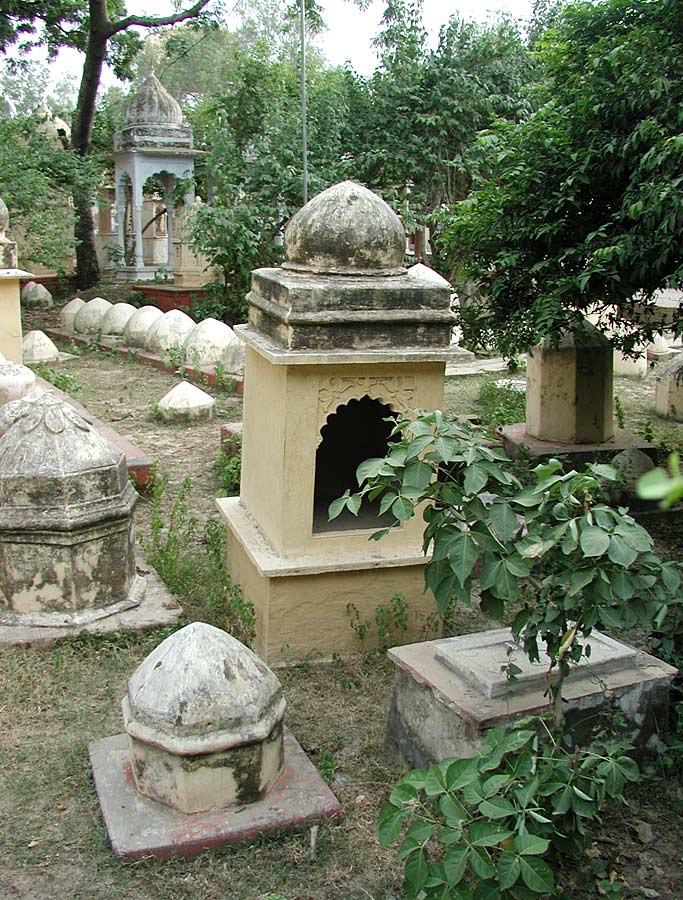
Hussain Khan found this situation very difficult, since Subuddhi Raj raised him from childhood and was almost like a father to him. He decided to sprinkle the water from his water-pot on his head and thus convert him to a Muslim. In those days, just by sprinkling water from a Muslim’s water-pot was sufficient to convert anyone from Hindu to Muslim and in the eyes of orthodox brahmanas he was socially ostracized.
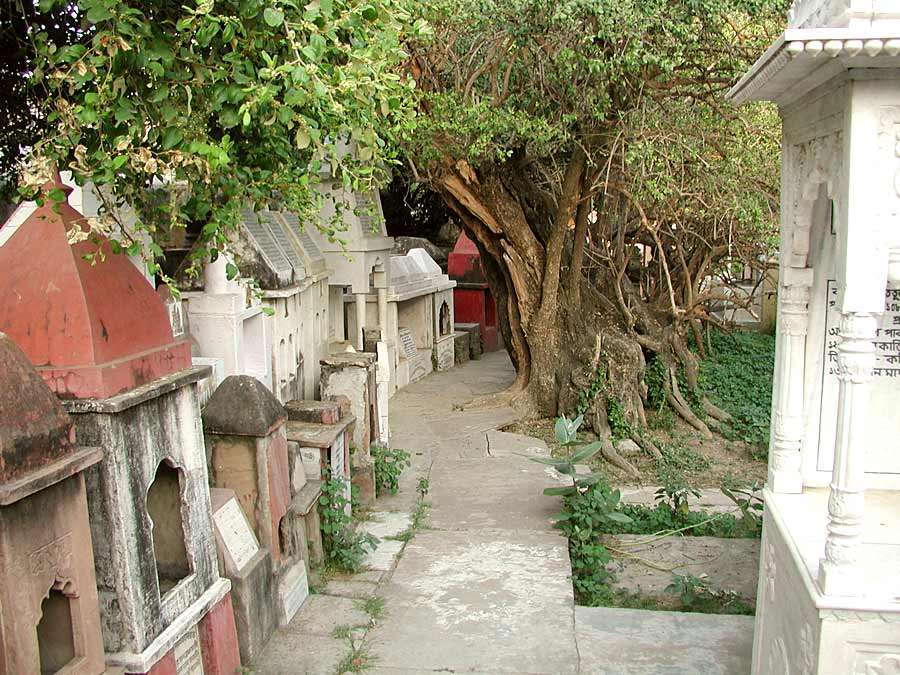
Subuddhi Raj left home and travelled to the holy places. In Benares, he was told by local brahmanas to commit suicide. At this time Lord Caitanya was also present there and met Subuddhi Raj. He told him not to commit suicide but to constantly chant Holy name instead and go to Vrindavan. Subuddhi Raj spent the rest of his life in Vrindavan and become a close friend of Raghunath Bhatta Goswami. His samadhi is near the samadhi of his dearmost friend, Raghunath Bhatta.

Lord Ranganath’s temple resembles famous temple in Sri Rangam in Tamil Nadu. Rangaji is a form of Lord Visnu lying on the Sesa Naga.

It is constructed in the South Indian Dravidian style and has an impressive gopuram tower over the main entrance. It is the biggest temple in Vrindavan. It was built in 1851 by Laksmicanda Seha at the expense of 4.5 million rupees.
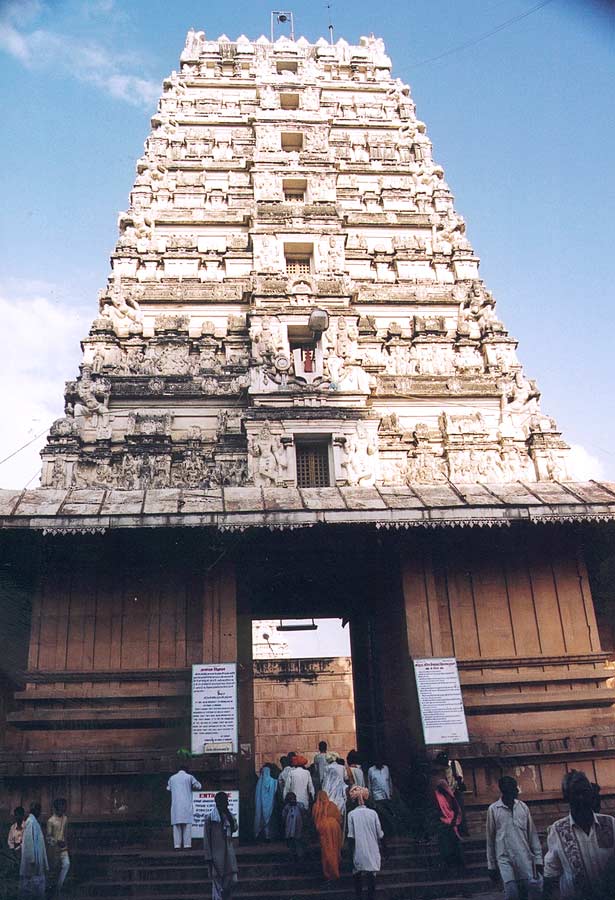


The temple is surrounded by high walls.

It has traditional gates.
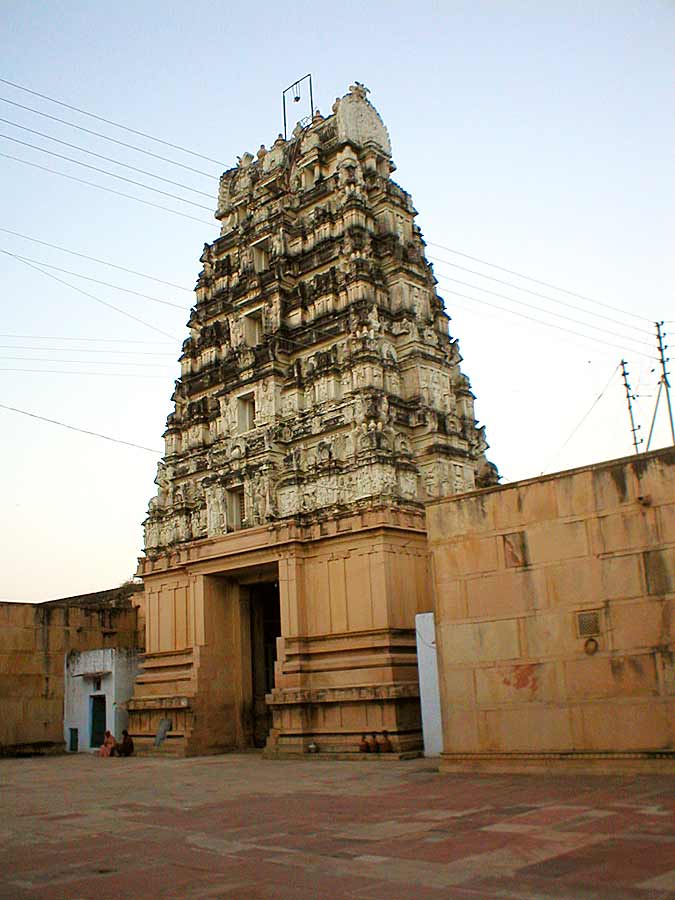
Mandapam providing shade for rest and of course temple-sarovar (pond) and as any temple built in South Indian style should have.


Near the Western door is a chariot, upon which Sri Rangaji rides on special occasions. Once a year, a Ratha-yatra for Lord Ranganath is held. The Lord’s cart is pulled to nearby Rangaji garden.
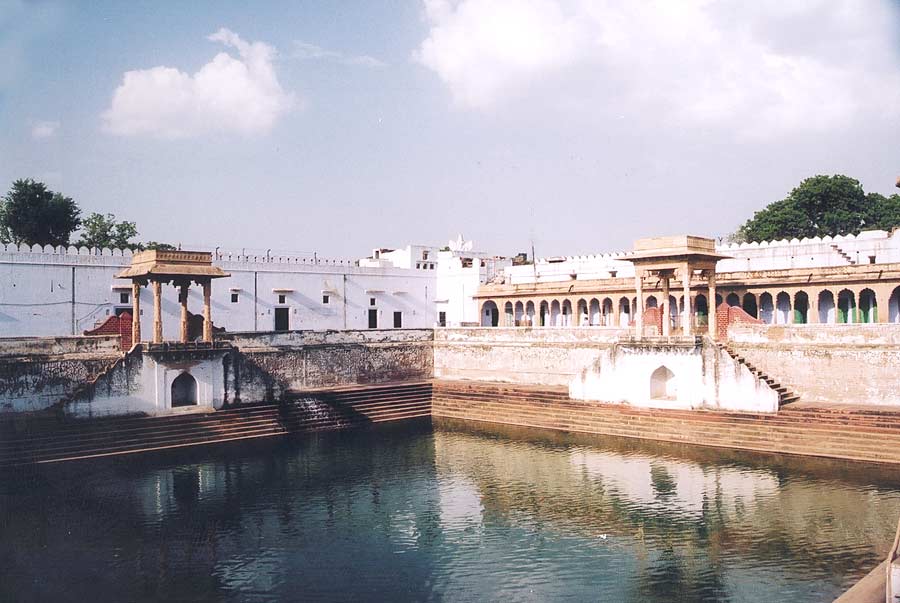
The carts are smaller than in Puri, but sentiments of devotees can be the same.
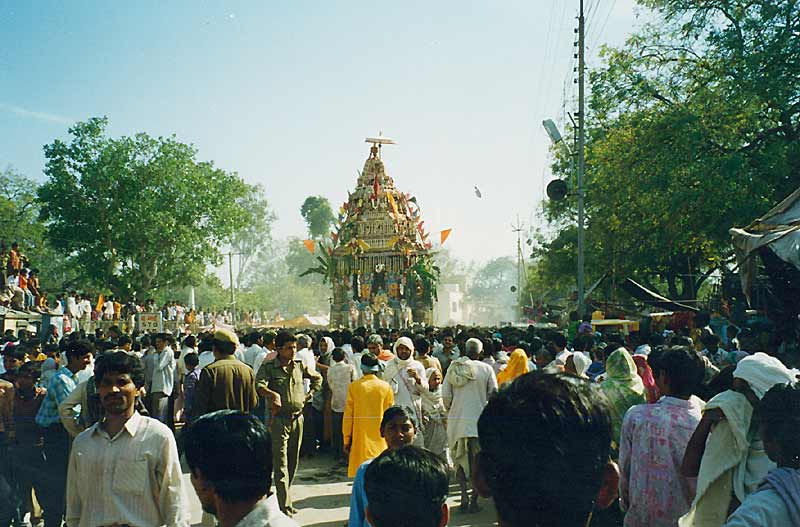
At the entrance of the Rangaji Mandir are moving dioramas depicting different lilas of the Lord – killing of Ravana.

Waking up of Kumbhakarna from Rama-lila

Rasa-lila
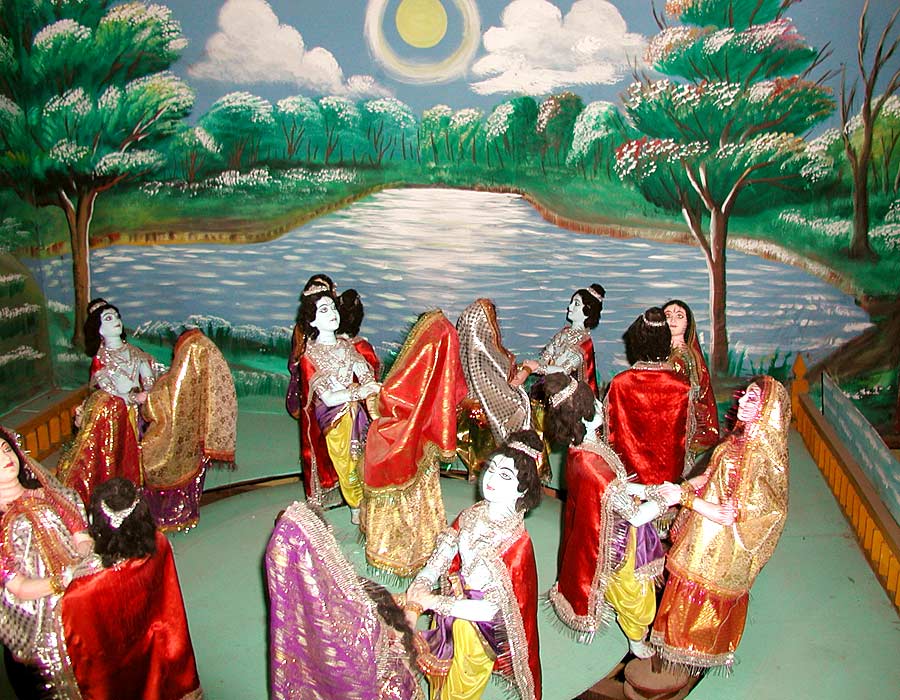
Govardhan-lila and others from Krishna-lila
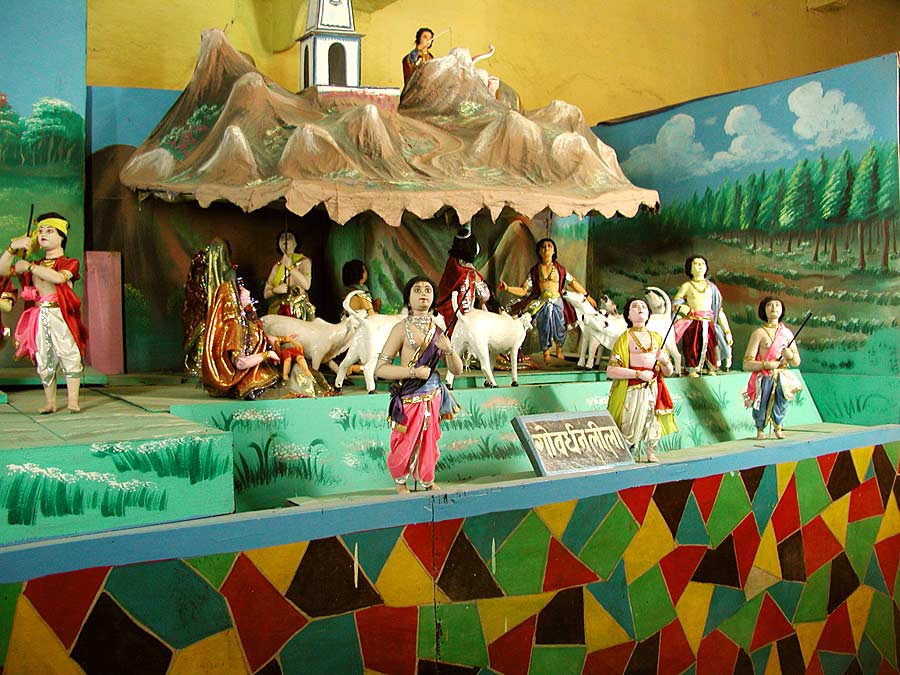
Brahma-kund: Brahma-kund was originally created by tears of Lord Brahma, when he was regretfully crying after stealing cowherd boys from Krishna. Yogamaya Paurnamasi gave a gopi form to Mahadev Sankara by dipping him in this kund. Vrindadevi also gave Narada the form of Naradi-gopi by bathing him here, thus fulfilling his desire to take darsan of rasa-lila.
. 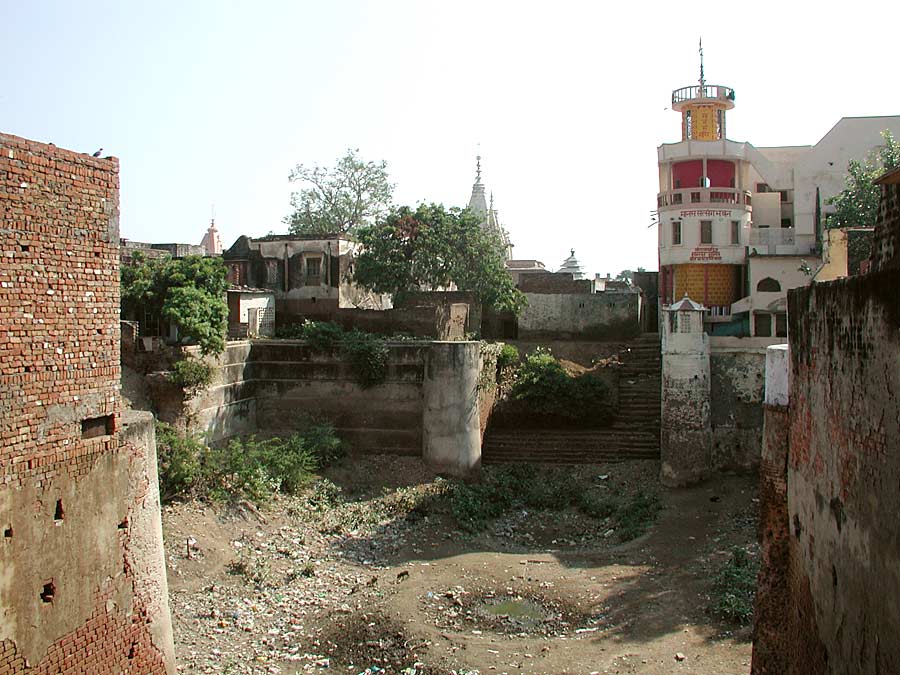
Until recently the kund which was dried was nicely renovated and now is full of water.
Lal-Babu Mandir: Lal-Babu was wealthy landlord from East Bengal. He liked to go for walks from his mansion to the other side of the river. One day he heard boatman saying: “Brother! Day is over. Go across!” Those words inspired his thought about his own mortality and in his heart he actually heard: “Life is reaching its close. Quickly cross over this material existence!”

Next day during his walk, he heard washerman addressing his wife: “The day is over. Go and burn the vasana!” The bark of banana is called “vasana” in Bengali, but it also means “passion” or “desire”. Boatman’s words sounded in his head like: “The days of your life is over! Burn your lusty desires!” It made a great impression on him and shortly afterwards, he abandoned his luxurious living and came to Vrindavan.

As a young man he become vairagi (renounced saint) and constructed this magnificent stone temple. In 1810 he installed the Deity of Sri Krishnacandra. Lal-Babu also constructed ghats surrounding Radha-kund.
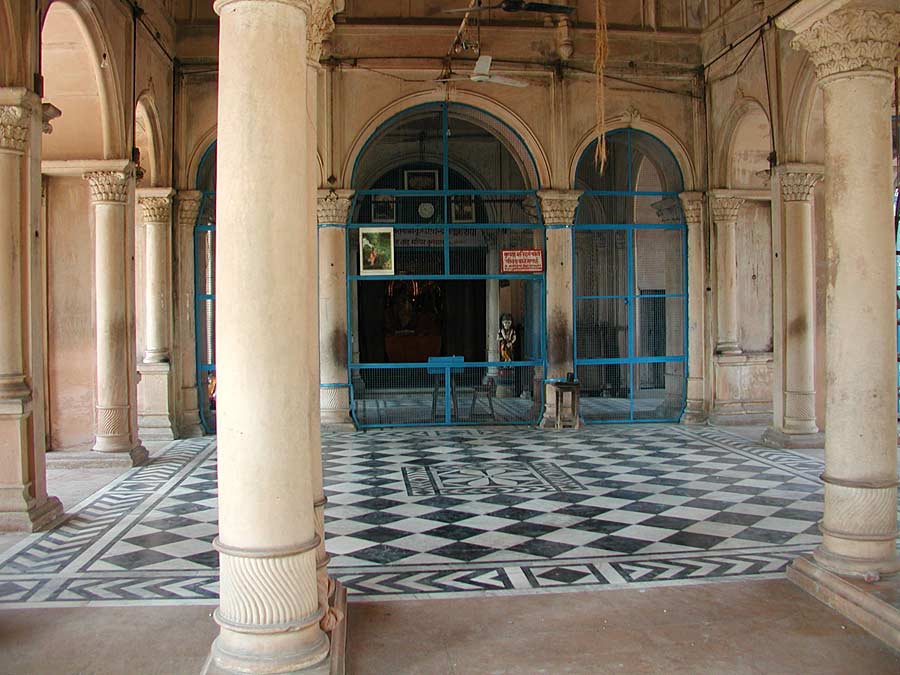
Braja-Mohan Temple The Deity of Braj-Mohan was installed by Narottam das Thakur during the Khethuri festival in Bengal. Khethuri festival was the first festival celebrating the appearance of Sri Caitanya Mahaprabhu. It was actually the first Gaura-purnima as we know it today and all the prominent Vaisnavas of those times attended it.
. 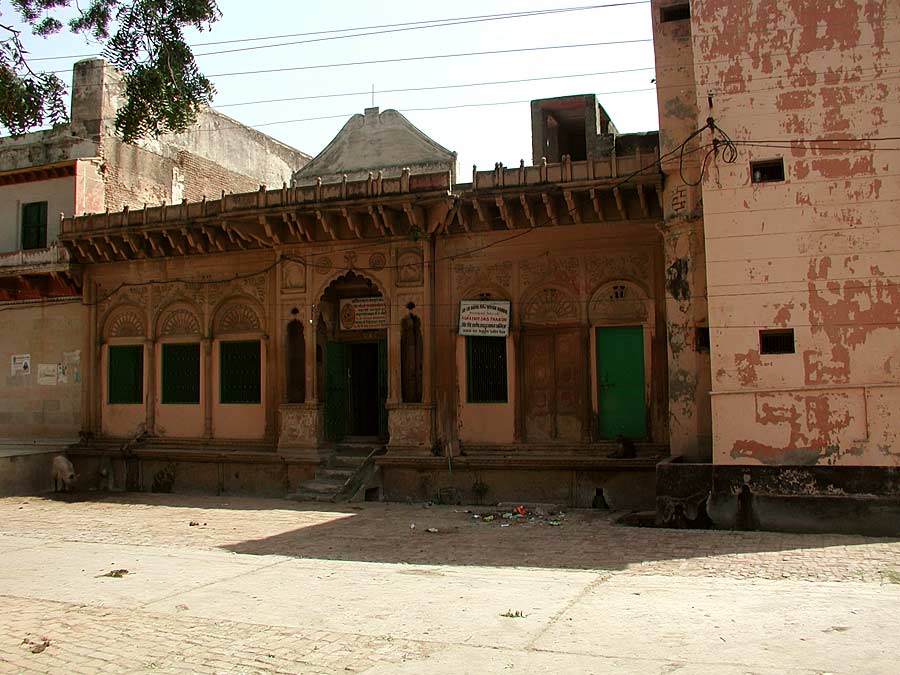
Srinivas Acharya personally performed abhisek for Braja-Mohan and other five Deities. Out of them, only Braja-Mohan was brought to Vrindavan for worship.
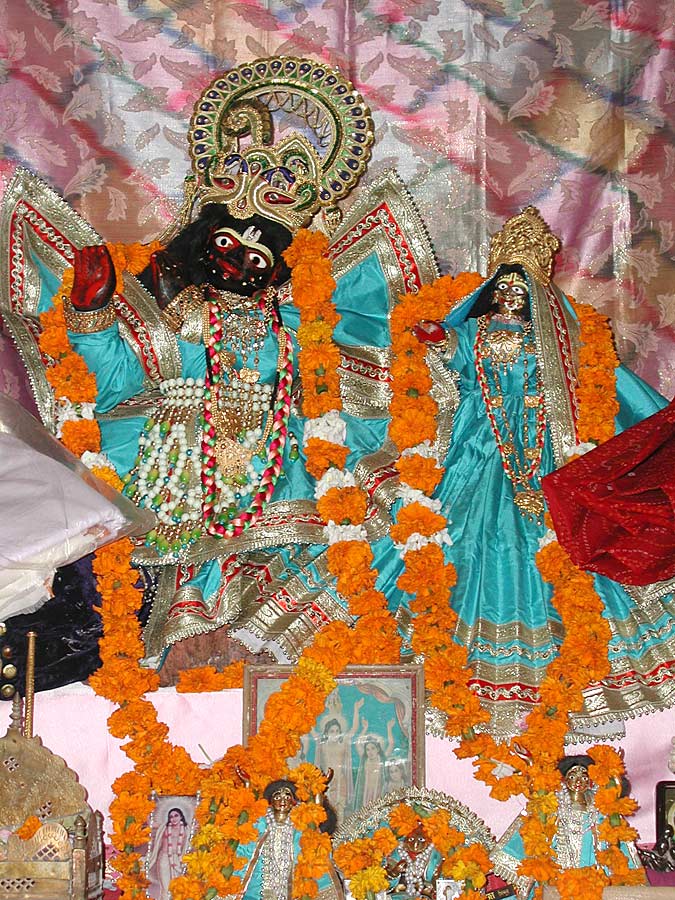
Devotees and pujaris are very friendly and Narottam’s Deities of Braja-Mohan are very sweet. H.H Indradyumna maharaj has kindly sponsored seva for the Deities.

Jnana-Gudri (Jnana-Gudadi) Sri Narada once said to Prayag: “Bhagavan has given you the name Tirtharaj – the king of Holy places. But I doubt it is true. Does Vrindavan ever come to make an offering to you along with the other tirthas?” “No,” said Prayag. “Then what kind of Tirtharaj are you?”
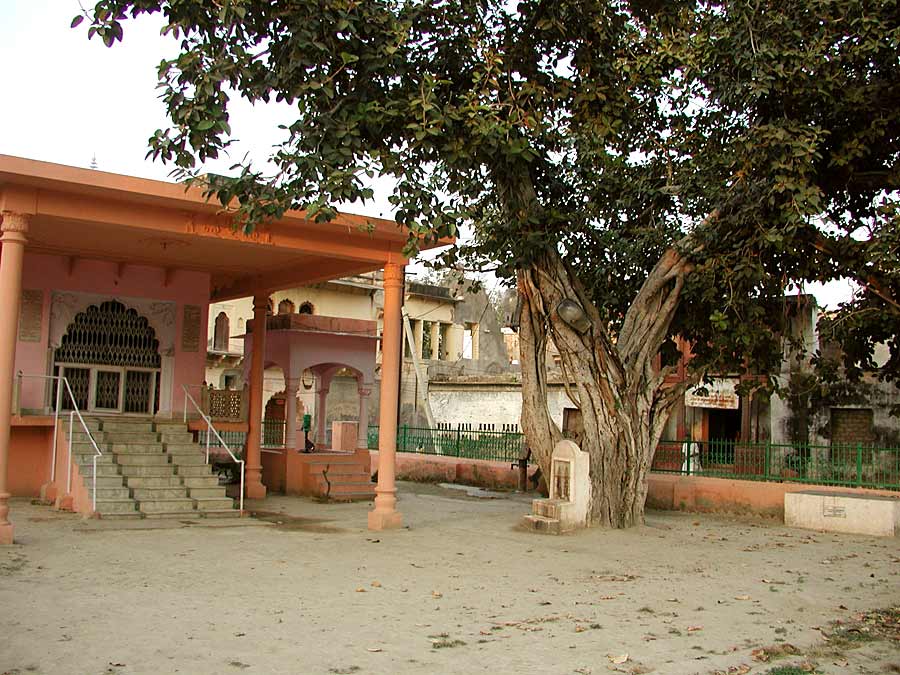
“Seeing Tirtharaj approaching, Bhagavan honored him appropriately and asked him why he has come in such sad mood. “My master, You have appointed me as Tirtharaj and all the Holy places come to me with their offering, but the tirtha Vrindavan never comes to me. If small tirtha like Vrindavan does not accept my jurisdiction, than why should I have the title of Tirtharaj?” Bhagavan became silent for a moment, His eyes brimmed with tears as He remembered Braj, cows, sahkas, Nanda and Yasoda, gopis and rasa-vilas. Than He composed Himself and said: “You are truly the king of all tirthas, but I have not made you the king of My own home, Sri Vrindavan.
“It is said that Prayag-Raj comes to Vrindavan at Jnana-Gudadi during the flood in the form of black horse. He takes bath here and purified from the sins left on him by the pilgrims. His form will change into white horse. Then he returns back. Brijvasis also take bath at this same spot when Yamuna floods during the monsoon.

When Krishna sent Uddhava from Mathura to Vrindavan to console Nanda, Yasoda, gopas and gopis, Uddhava delivered His message. But it was full of tattva-jnana and gopis tore it up so it resembled torn garment (gudadi) and threw it into the water of Yamuna. That jnana-gudadi drifted downstream and fell into the Ganga at Prayag. From there it floated to the salt ocean. The place where the gopis abandoned that message filled with tattva-jnana, leaving it float down the Yamuna like a torn garment is known as Jnana-Gudadi.
Radha-kanta temple: Radha-kanta is Deities of Gopal-guru Goswami. Gopal-guru was a disciple of Vakresvar Pandit, one of the associates of Caitanya Mahaprabhu. He studied sastras under Svarup Damodar and Raghunath das Goswami..
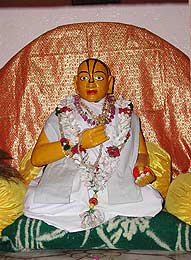
In his last days, he became so distressed with separation from Krishna that in the eyes of ordinary people he left his material body. His learned disciple Dhyanacanda Goswami at that time encountered some problems in Jagannath Puri with the government officials regarding bhajan-kutir of Haridas Thakur and Radha-kanta temple. A vaisnava from Vrindavan told him that he had seen his guru at Dhira-samira in Vrindavan.
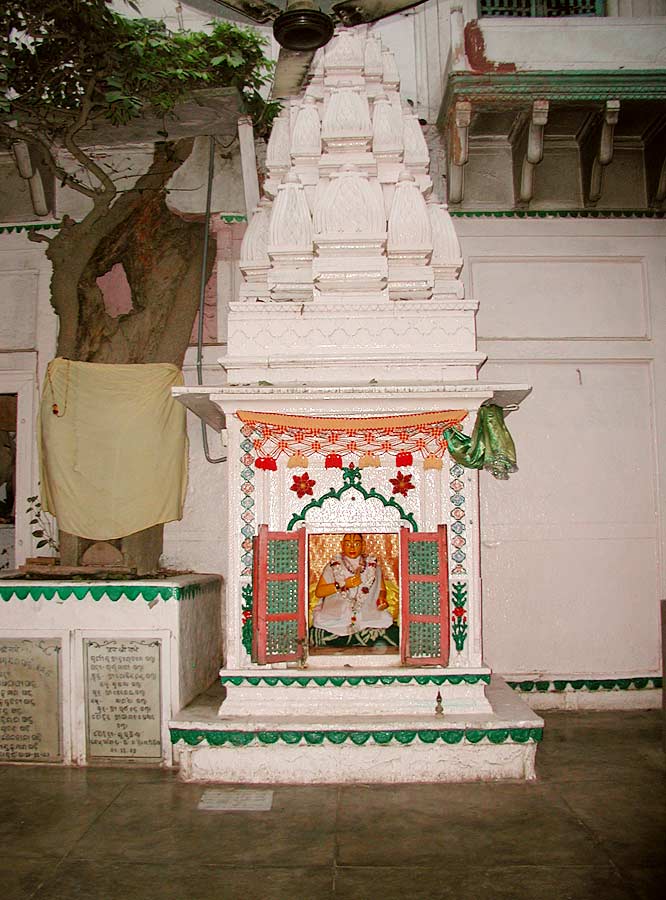
Dhyanacanda Goswami reached Vrindavan in few days and he saw Gopal-guru with nama-mala in his hands and in tears with his eyes as he was remembering various pastimes of the Lord. Dhyanacanda fell at his feet and began to cry. He begged him to return to Puri. Gopal-guru refused, but told him to return without fear. “The disturbance will soon end.” By his order, Dhyanacanda returned to Puri and government officials apologized to him. The disciples of Gopal-guru constructed another samadhi of their spiritual master under the same tree where they saw him in his spiritual body talking to Dhyanacanda.
Dhira-samira: The place on the bank of Yamuna near Vamsi-vat is called Dhira-samira because the breeze (samira) would became so gentle and calm (dhira) upon having darsan of wonderful keli-vilas pastimes and was so stunned seeing them that he was not able to move on and practically stopped. Therefore this place is known as dhira-samira. Gauridas Pandit established a kunja and temple at Dhira-samira and began the puja of Sri Syamaray.

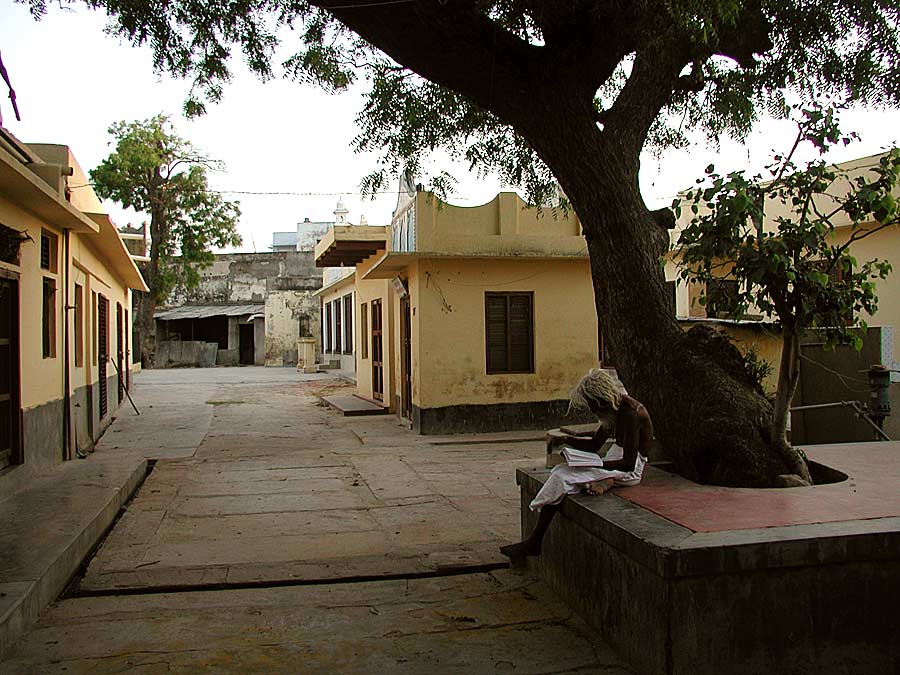
Samadhi of Gauridas Pandit, disciple of Lord Nityananda, is entombed here. Gauridas lived in Ambika-kalna near Santipur. His brother’s daughters, Jahnava and Vasudha, were married to Lord Nityananda.
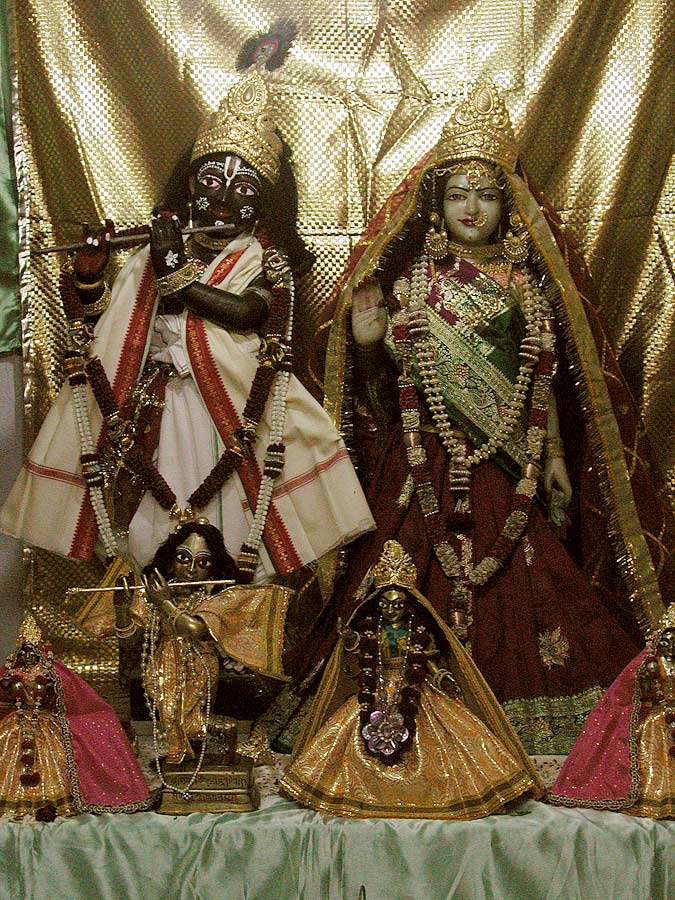
Radha-Syamaray Temple Gauridas Pandit performed his bhajan here at Dhira samira and worshipped his beloved Deity of Radha-Syamaray.
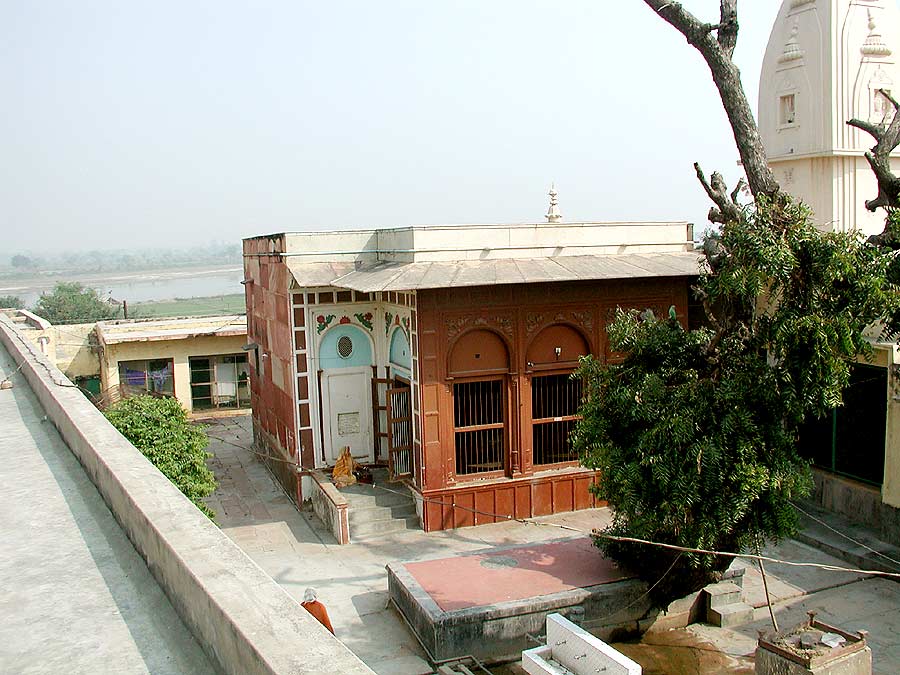
Jayadev Goswami mentions this kunj in Gita-govinda – dhira-samire yamuna-tire vasati vane vana-mali…. – The keli-vat under which Radha and Krishna performed this pastime is situated in Dhira-samira.
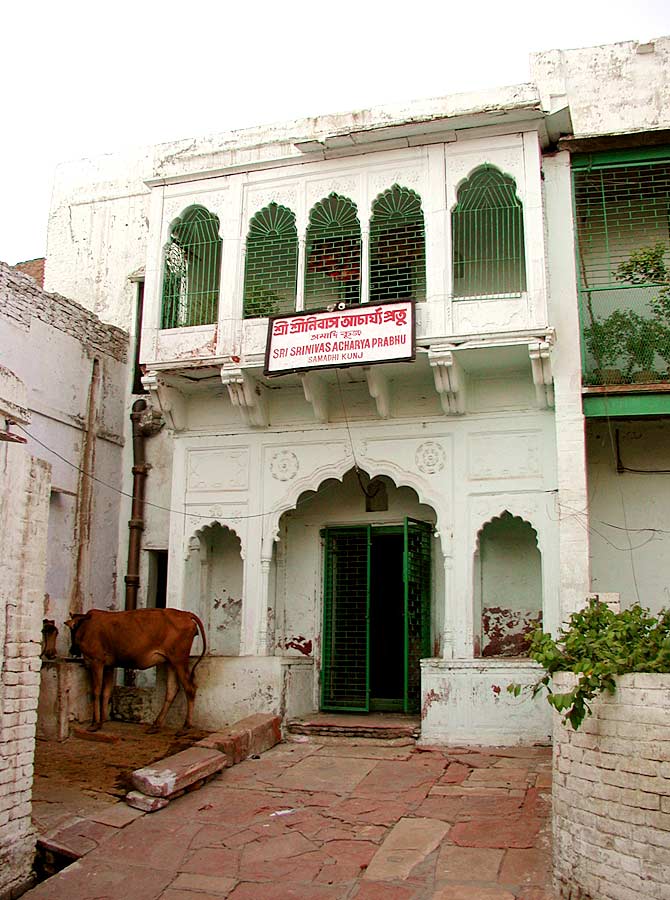
Srinivas-acarya kunj: When the father of Srinivas-acarya met Sri Caitanya Mahaprabhu at his sannyas ceremony, Sri Caitanya predicted that soon a son named Srinivas would be born to him. In his youth, Srinivas became brilliant student and his golden complexion resembled Sri Caitanya. He wanted to meet Sri Caitanya in Puri. But on the way, news about Sri Caitanya’s departure from this world struck him into grief. He studied Srimad-Bhagavatam from Gadadhar Pandit in Puri and later went to Vrindavan. He become disciple of Gopal Bhatta Goswami and studied sastras under Jiva Goswami.

After completing their studies, Jiva Goswami ordered Srinivas, Narottam and Syamananda to take the books of Goswamis and go to Bengal to preach. They set up on the way with bullock cart full of books. Near Vana-Visnupur they entered the kingdom of king Birhambir. He used to consult astrologer about the caravans and rob the merchants. When the first sankirtan party approached his border, the astrologer informed the king that this cart carries an inconceivable treasure. As usually, king’s people took the cart, but found only books.

Narottam and Syamananda continued to preach in Bengal, Orissa, Assam and Manipur and Srinivas stayed to reclaim the books. In his search he visited the court of king Birhambir and heard some brahmin explaining Srimad-Bhagavatam. He pointed out his mistakes during recitation and the brahmin asked him if he knows better. Srinivas started to explain the Bhagavatam as he had learned from Goswamis and everybody included the king told him that they had never heard so beautiful explanation of Bhagavatam. King Birhambir finally become his disciple, returned the books and turned his whole kingdom into Vaisnava state.
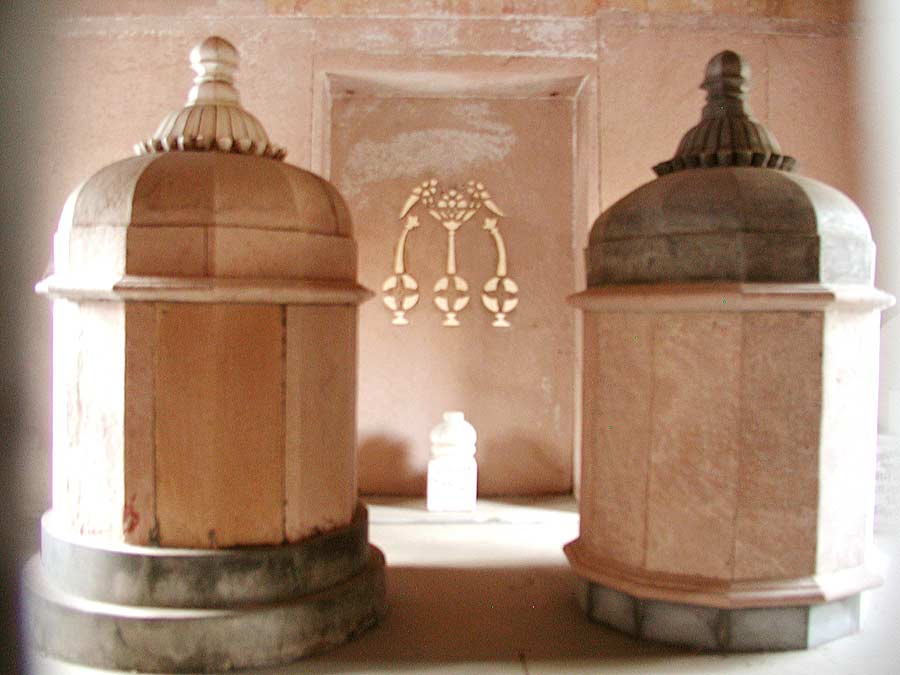
Samadhi of Srinivas-acarya: Entombed here is a sacred body of Srinivas Acarya. He was an incarnation of Mani-manjari, one of the intimate maidservants of Srimati Radharani, and embodiment of Goura-sakti, spiritual energy of Sri Caitanya Mahaprabhu. He was also a famous poet. and his Sad-goswami-astaka is sung by devotees till today. Srinivas, Narottam and Syamananda were most prominent acaryas in the generation immediately following Sri Caitanya Mahaprabhu.

Samadhi of Ramacandra Kaviraj and puspa-samadhi of Hemlata Thakurani: Ramacandra Kaviraj was disciple of Srinivas-acarya and a friend of Narottam das Thakur. He received a title “Kaviraj” for his wonderful poetry describing pastimes of Sri Krishna and Sri Caitanya. Narottam in one of his bhajans sings Ramacandra-sanga mage Narottama-dasa “I always pray to be in the company of such a devotee as Ramacandra Kaviraj.” Hemlata Thakurani was a daughter of Srinivas-acarya and great preacher of Gaudiya-Vaisnava philosophy.
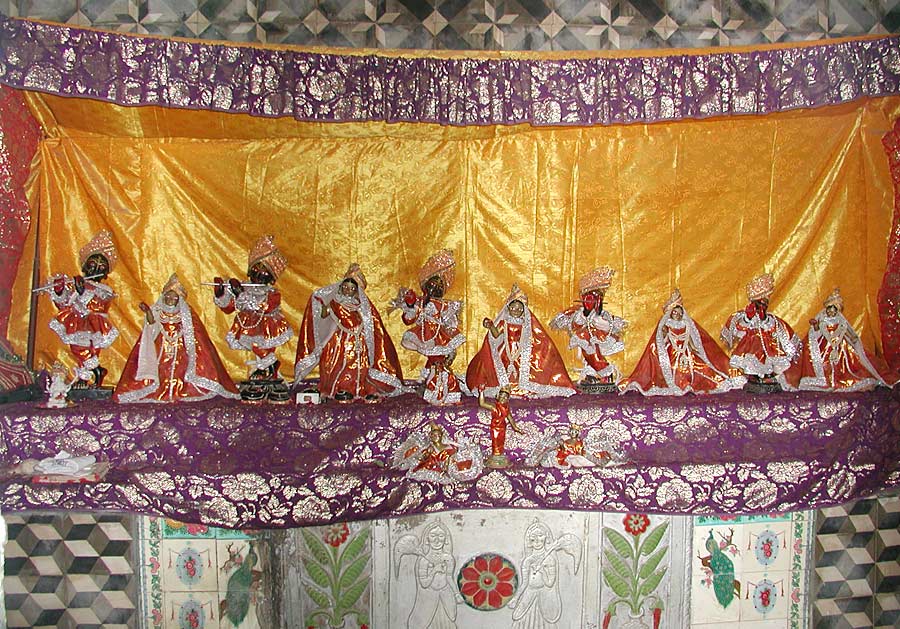
Inside Srinivas-acarya kunj there is a Radha-madhava Temple. Among the Deities, on the bottom shelf is a Jula-Thakur, a personal Deity of Srinivas Thakur who used to carry Him in his bead bag.
. 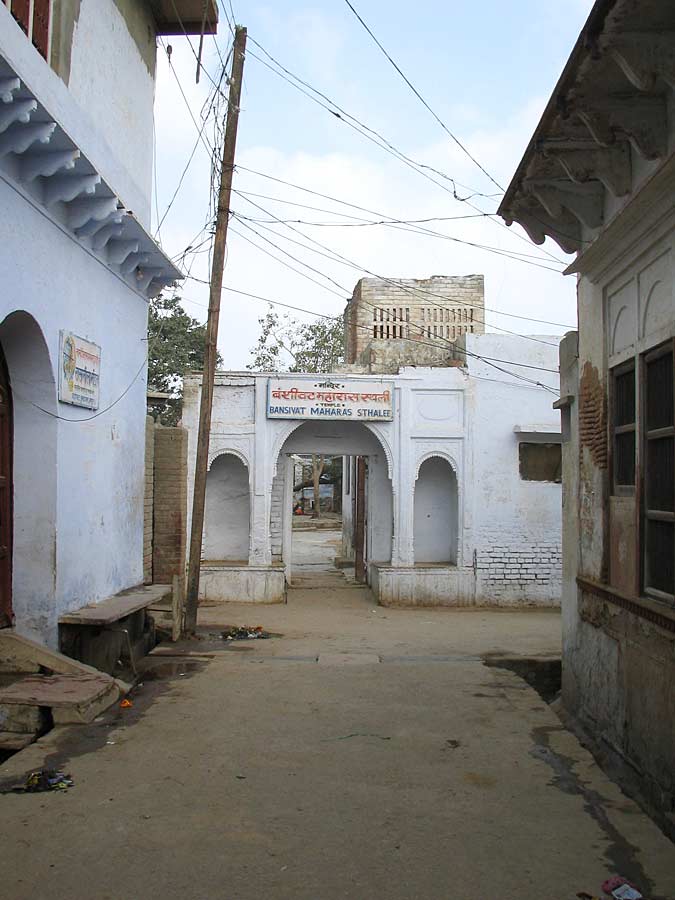
Vamsivat: On the beautiful full moon night of the sarat season, Krishna started to play a sweet tune on His flute (vamsi) and call gopis. They stopped everything and run towards their beloved in the midst of night. “When the young woman of Vrindavan heard Krishna’s flute song, which arose their romantic feelings, their minds were captivated. They wanted to go where their lover waited. Each unknown to others, moving quickly and their earrings swung back and forth”. (Srimad-Bhagavatam 10.29.4).Krishna began to convince them to return home to their husbands, but gopis refuted His arguments. Finally rasa-lila started and gopis felt satisfaction and possibly they felt some pride because of their good fortune. One Krishna was dancing between two gopis and one gopi was dancing between two forms of Krishna.

At this moment, Krishna disappeared and their pride was transformed into transcendental separation and it was so intense that it was reaching the point of madness.
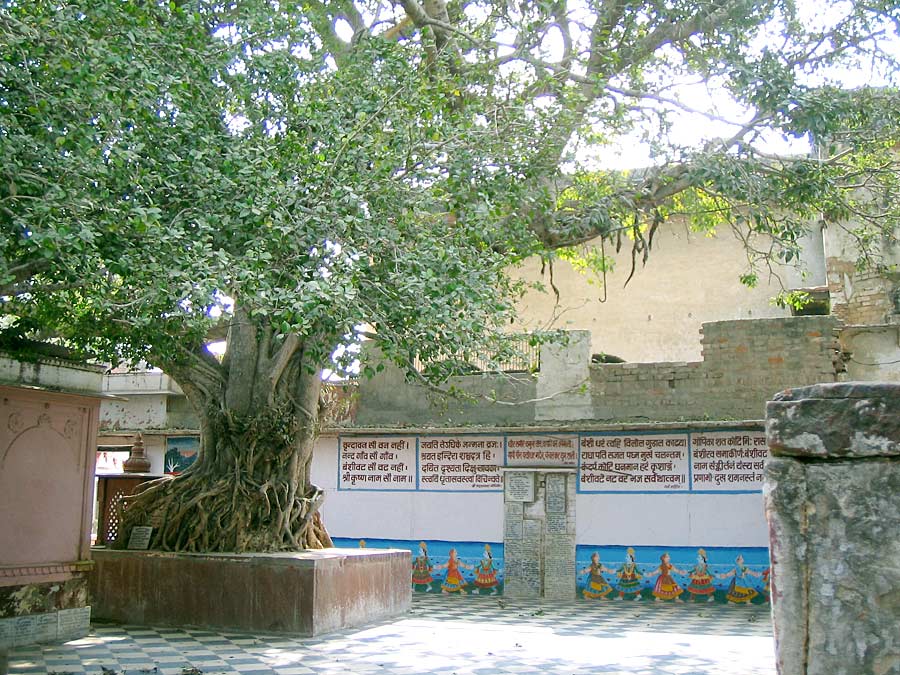
Hearing their despaired singing, Sri Krishna again appeared.

“You have performed an extraordinary deed. You have given up everything for Me. For this sacrifice, I am eternally indebted to you and can never repay you.” Srimad-Bhagavatam 10.32.22

In this way, the divine pastimes of Krishna and gopis continued on Vamsivat, the crest-jewel among lila-sthalis.
Sri Vajranabha planted here a banyan tree (vat) in remembrance of this pastimes.But about 500 years ago; Yamuna flooded the place and took this tree with her. Sri Madhu Pandit, a disciple of Gadadhar Pandit, took one of its branches, brought it back and planted it here.
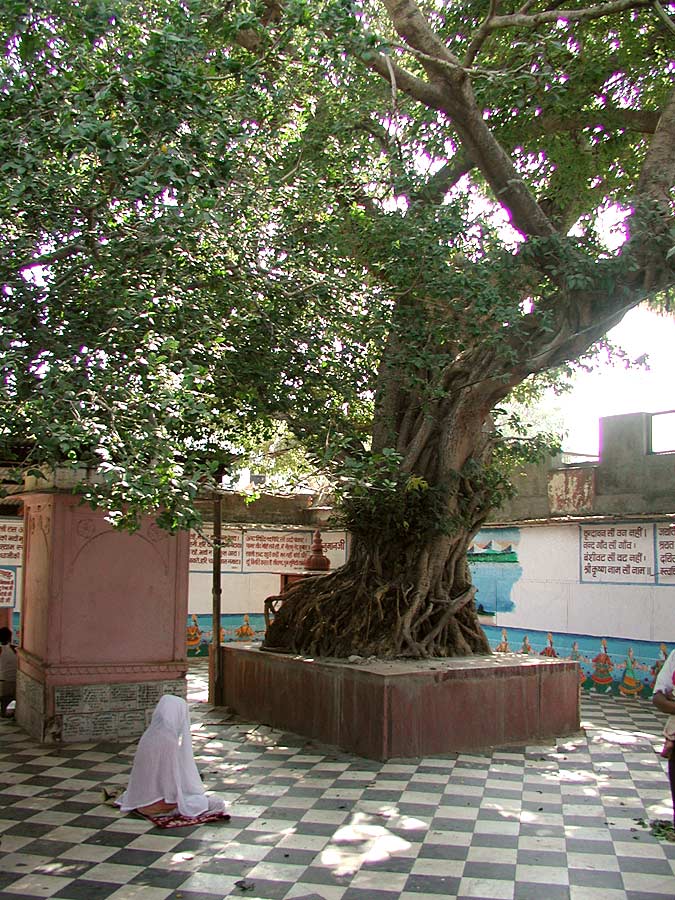
The branch transformed into this vast tree and present till today. While planting the tree, Madhu Pandit discovered the Deity of Gopinath here at Vamsivat. (Some say Padmanabh goswami found the deity and later gave it to Madhu pandit).
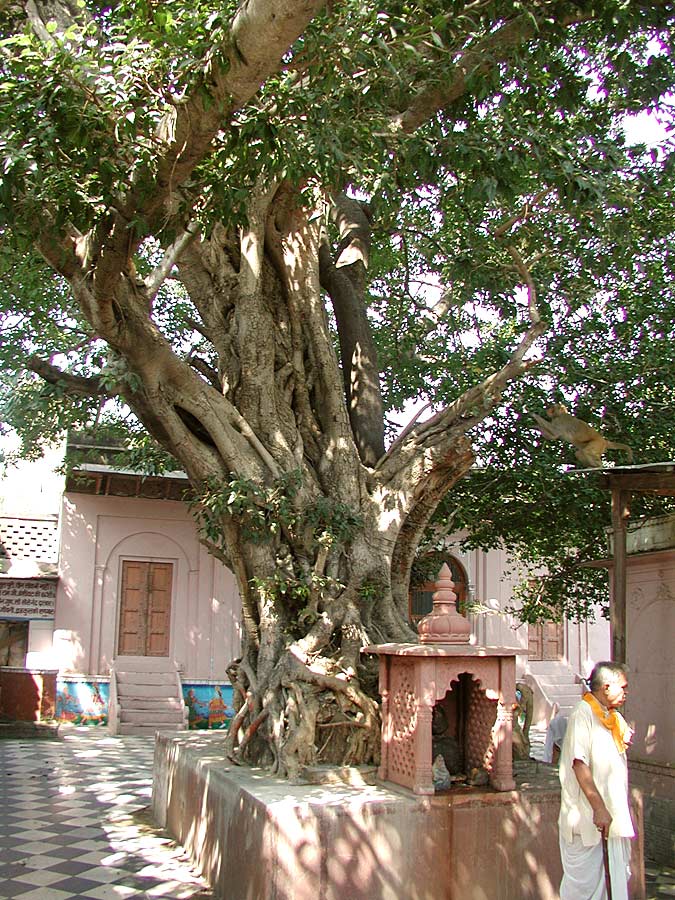
Vamsivat is a famous place mentioned in innumerable songs.
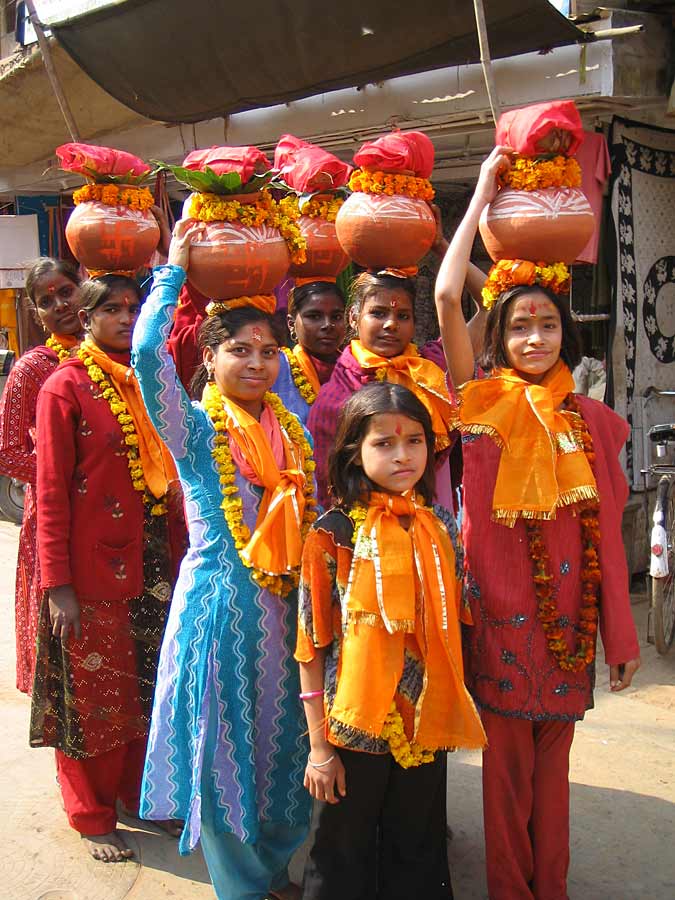
Gopesvar-Mahadev: Mahadev Sankara once desired to take darshan of Krishna’s rasa-lila with his own eyes. Being very eager he came from Kalilas to Vrindavan, but at the gate of Vrindavan, attendant gopis stopped him, because no male except Sri Krishna can enter rasa. Sankara, as usual, didn’t give up easily. He inquired how he might be admitted. Gopis told him to worship Paurnamasi (Purnima). Sankara worshiped her and Purnima, knowing his desire, dipped him into the nearby Brahma-kund. When he came out of the water, he had been transformed into a beautiful young gopi.
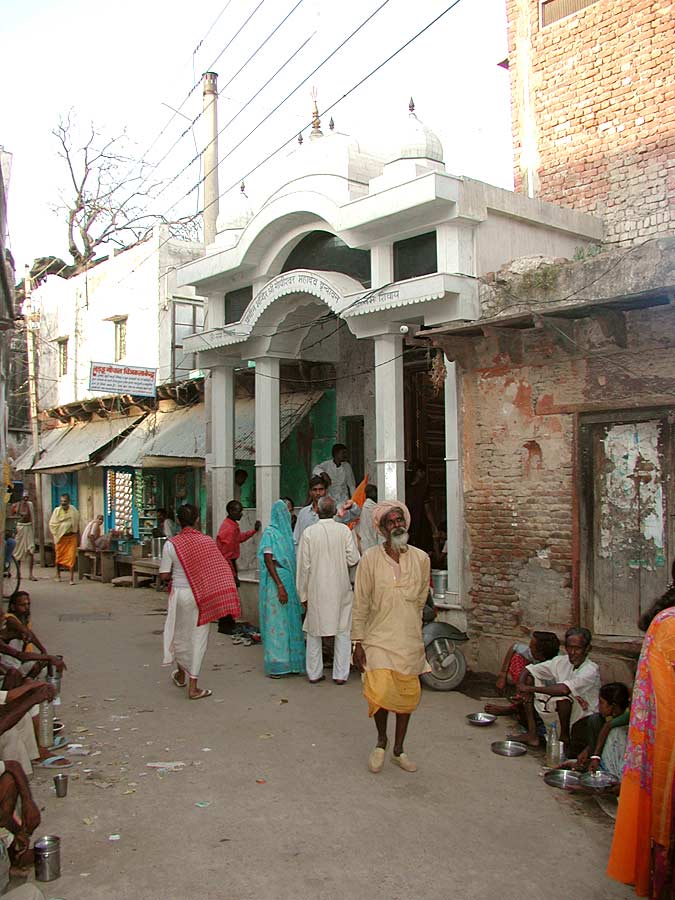
Purnima seated Mahadev, now gopi, inside the kunja of rasa-sthali and disappeared. After a short while, rasa-lila began but the gopis had strange feelings: “For some reason, we do not feel any happiness today!” They have understood that some outsider had entered the place and began to search.

After a while they saw this unknown gopi sitting in this kunj and they began to question her: “What is your name?” “What village are you from?” “Who is your husband?” “Who is your father-in-law?” But the gopi was unable to answer any of those questions and began to cry. Yogamaya had neither arranged her birth from the womb of the gopi, nor given her any name. She was not married to any gopa either, so what answers she could give? Gopis receiving no answer began to slap her cheeks until they became swollen.
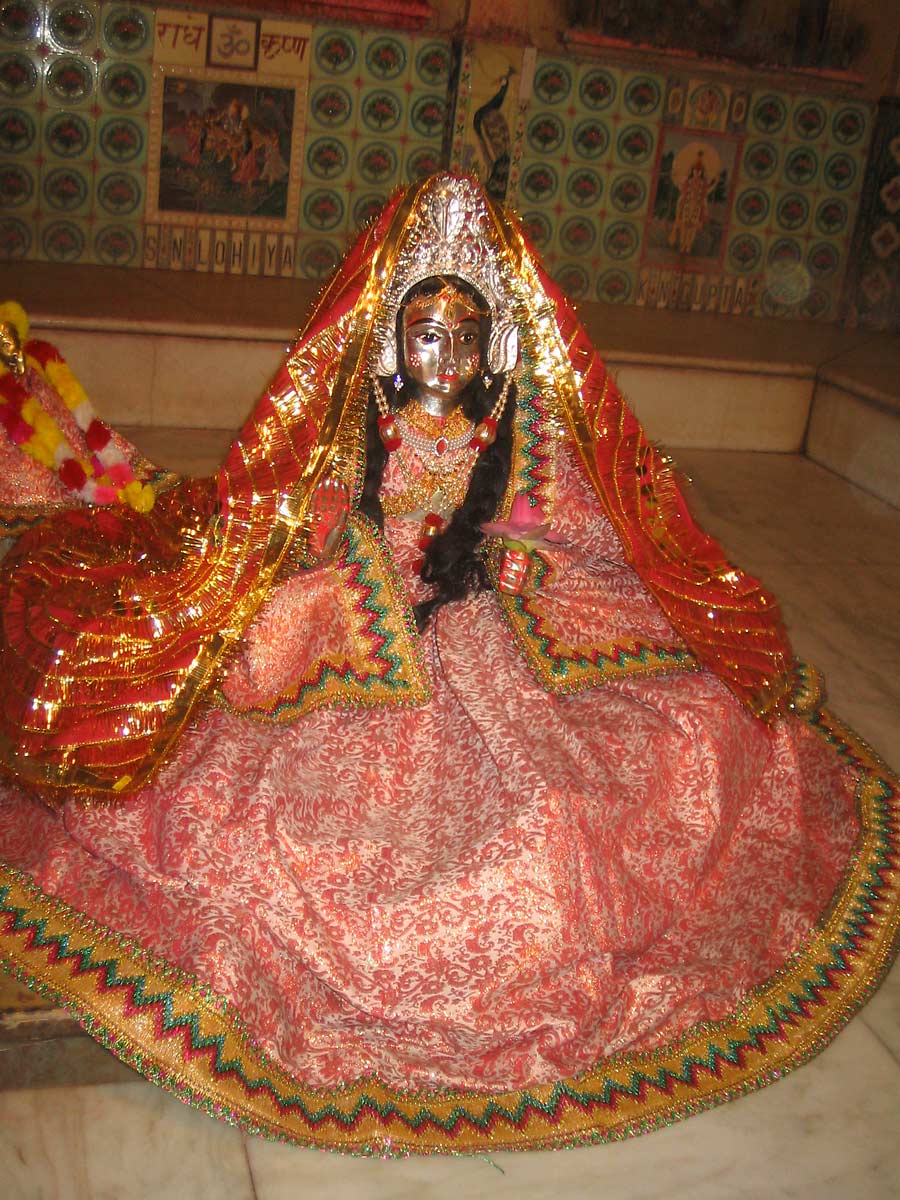
Seeing Mahadev’s misery, Purnima’s heart melted. She went there and explained that this gopi was an object of her mercy. She requested the gopis and Krishna to be merciful to her. Sri Krishna, knowing the desire of Purnima, gave Sankara the name Gopisvar and granted him a boon that a sadhaka would be unable to enter Vrindavan and especially places of Krishna’s sweet pastimes, without the blessing of Mahadev.Vajranabha, the great grandson of Krishna, installed the Siva-linga in this temple. It is said that the big pipal tree here is a kalpa-vriksa tree and will fulfill all desires”. O gatekeeper of Vrindavan! O soma, all glories to you! O you whose forehead is decorated with the moon and who is worshipable for the sages headed by Sanaka, Sanandana, Sanatana and Narada! O Gopisvar! Desiring that you bestow upon me the prema for the lotus feet of Sri-Sri Radha-Madhava, who perform joyous pastimes in braja-dham, I offer pranamas unto you again and again!” Sankalpa Kalpadruma, 103 by Visvanath-Cakravarti Thakur
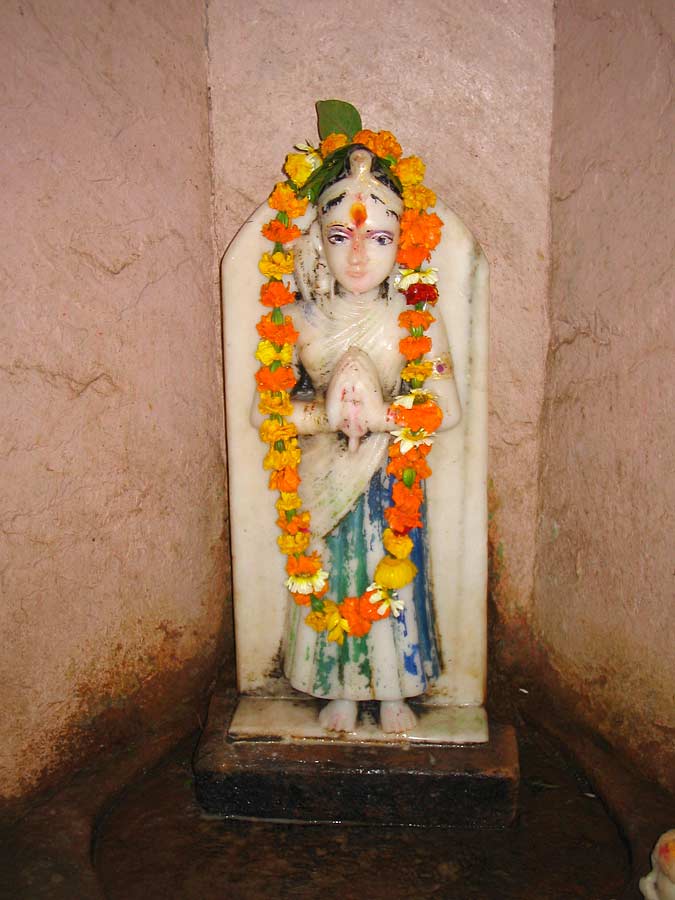
Gopisvar Mahadev from Vamsivat Amiya Nimai. Amiya means “ambrosia” or “immortal”.
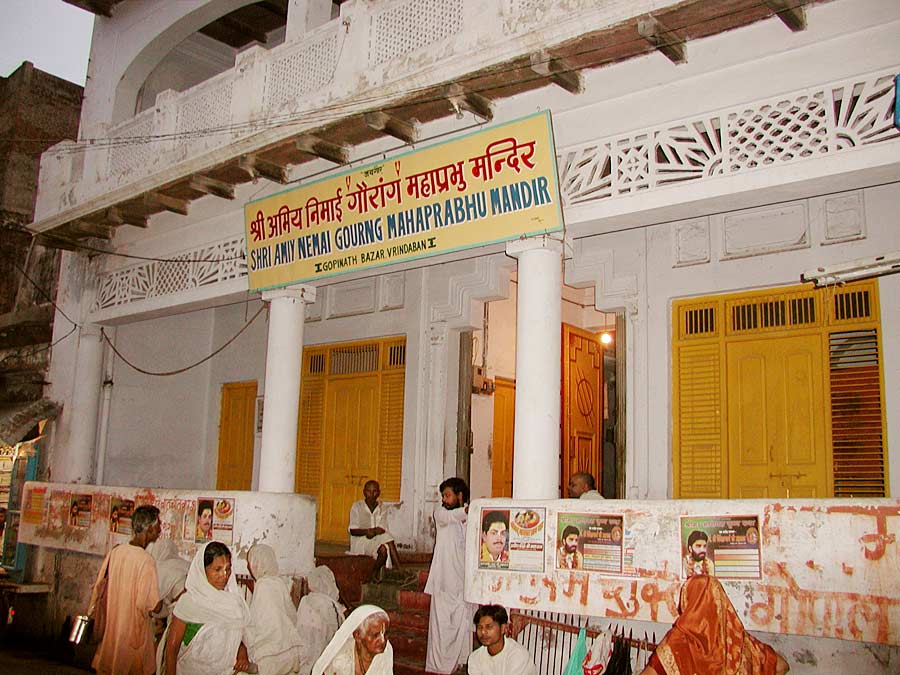
This tall Deity of Sri Caitanya Mahaprabhu is well known throughout Vrindavan as Amiya Nimai. This Deity is installed by priests from Radharaman Temple.
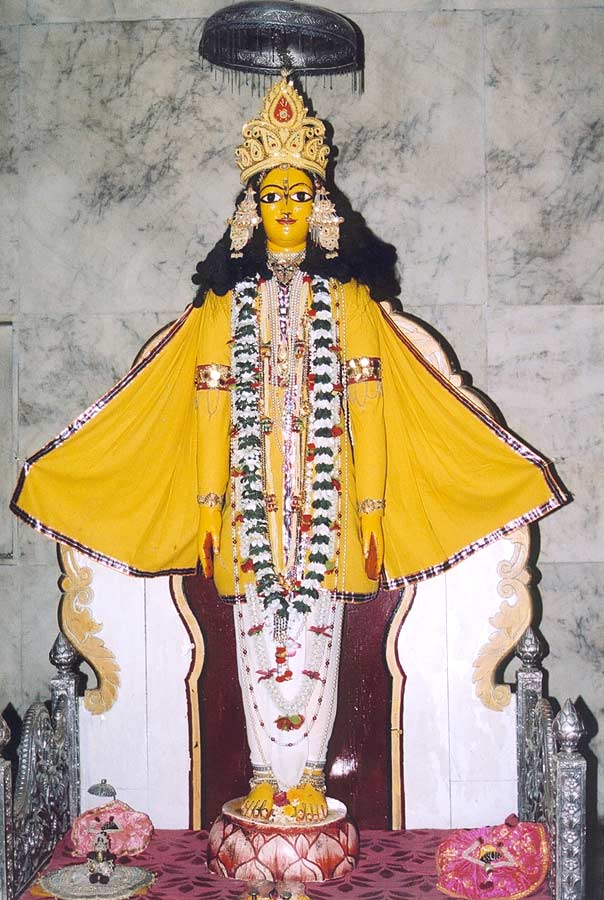
Samadhi of Bilvamangal Thakur:
Bilvamangal Thakur was the most prominent disciple of Visnu Swami from South India.

He was a famous poet and author of Krishna-karnamrita, which was read with delight by Sri Caitanya Mahaprabhu Himself. In his bhajans, he is sometimes mentioned by another name as Lila-sukha.

He performed his bhajan in this area about 700 years ago. His sacred body is entombed in this samadhi. Opposite to the gate of Gopinath Mandir in the same street, there is a temple of Gaura-Nitai called Sona-Gauranga.
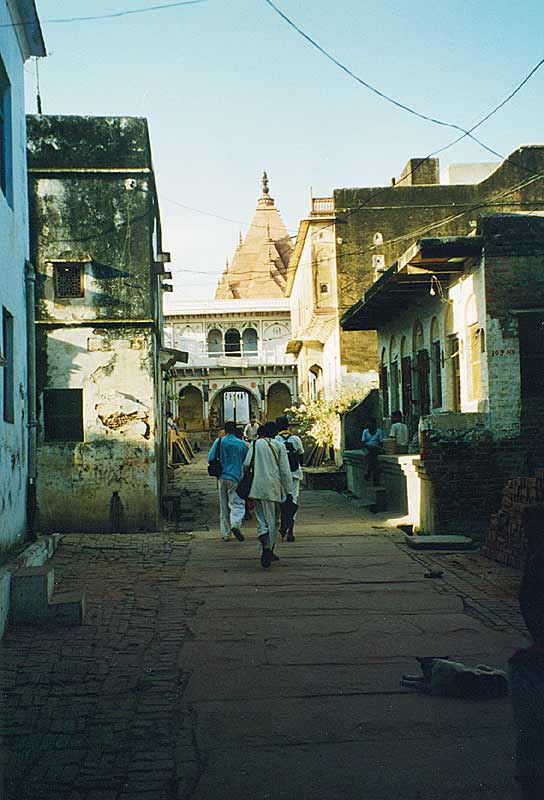
Sona-Gauranga temple: Sona-Gauranga Deities were worshipped by Jagannath das Babaji when he was staying at Surya-kund. After his departure for Bengal, they were looked after by a local brahmana.
 .
.
Thieves once thought that these Deities are from pure gold (sona) and wanted to steal Them. Therefore Sona-Gauranga Deities were moved to Vrindavan.
Sad-bhuj temple: When Jagannath das Babaji again returned from Bengal, he began to feel separation from his Gauranga Deities.
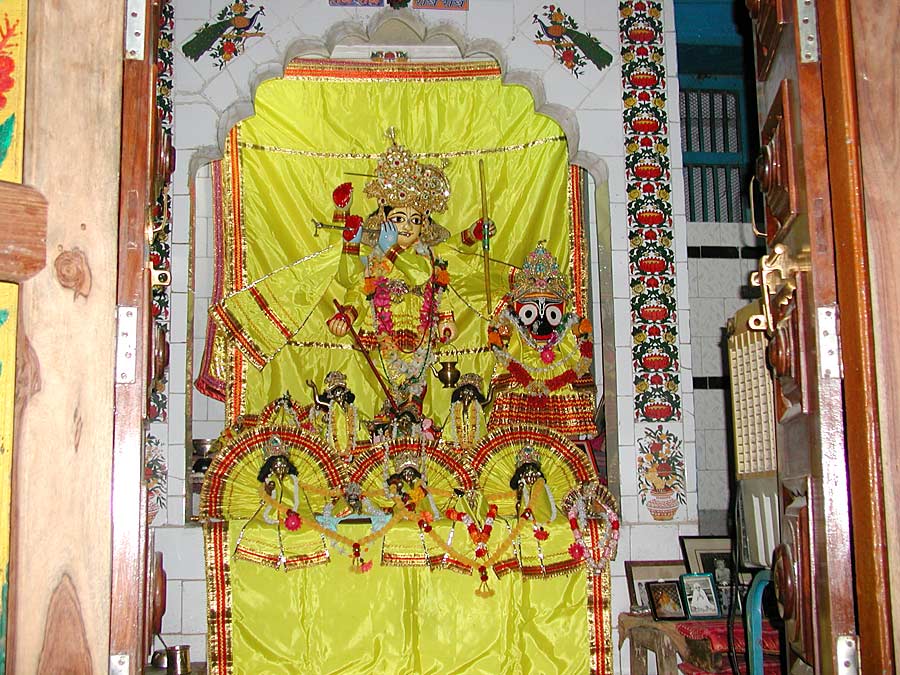
He therefore asked his disciple to find for him another Deity of Lord Gauranga. The disciple just happened to meet a farmer who received a supply of wheat bran for feeding the cows. As the cows began to eat it, beautiful Deity of Sad-bhuj emerged. The farmer gave the Deity to Jagannath das Babaji and when he again returned to Bengal, the Deity was moved to this temple next to Nidhivan.Sad-bhuj has six arms. Upper one are hands of Rama, holding bow and arrow, middle ones are hands of Krishna, holding flute, and the lower ones are hands of Sri Caitanya Mahaprabhu, holding kamandalu (waterpot) and danda (stuff) of a sannyasi. Nidhivan (Nidhuvan) Radha and Krishna are said to take rest here after dancing and other conjugal affairs. “Nidhi” means sleep and “van” means “forest”.
Visakha-kund lies in Nidhivan, similarly as Lalita-kund lies at Seva-kunj. Krishna created this kund with His flute to relieve thirst of Visakha and other gopis. Swami Haridas found a Deity of Sri Banke-bihari here in Visakha-kund.
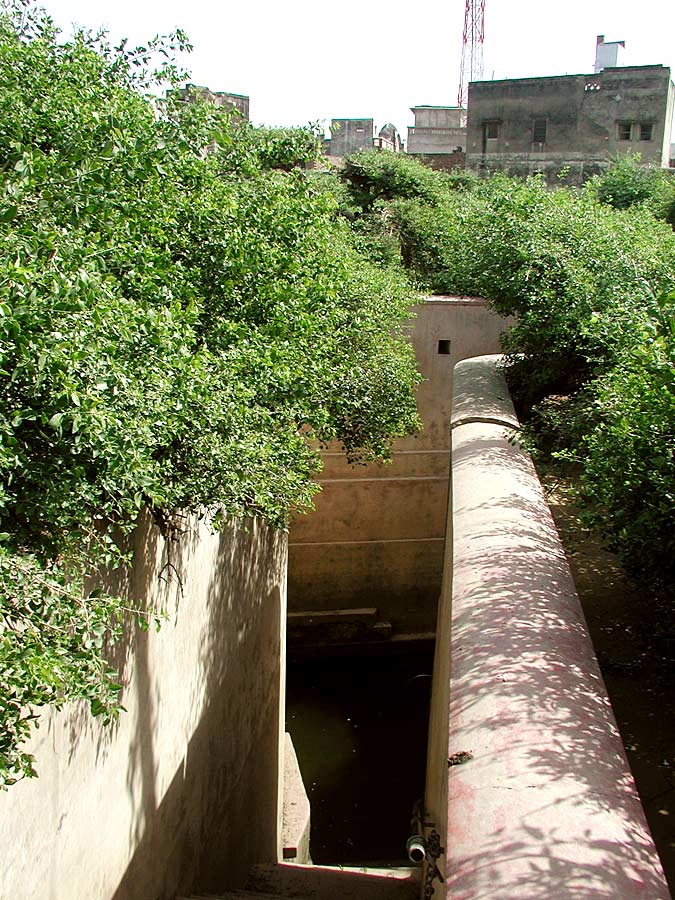
The shrine commemorating His appearance (Banke-bihari Yoga-pith) is just next to it.
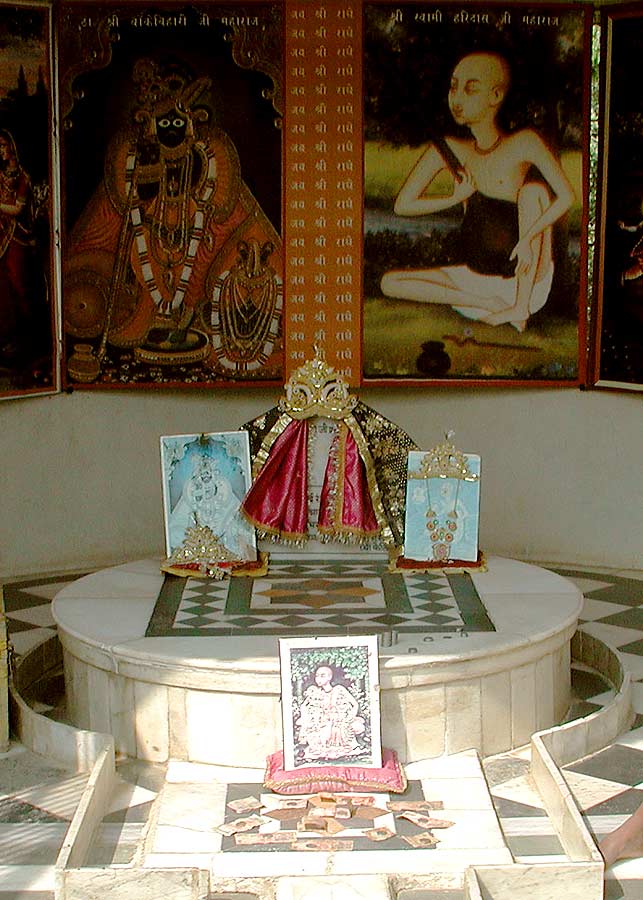
Just next to a place where Haridas Swami discovered Banke-bihari Deity, there is a small temple called Rang-mahal which has a bed where Radha and Krishna are taking rest.

It is also here that Krishna decorates Radharani with various kinds of cosmetics before rasa dance.

There is another small temple dedicated to Radharani.

Once She stole Krishna’s flute and started to play on it accompanied by Lalita and Visakha.

The samadhi of Haridas Swami is to the left from this central temple behind a small shrine where Radha plays a flute.
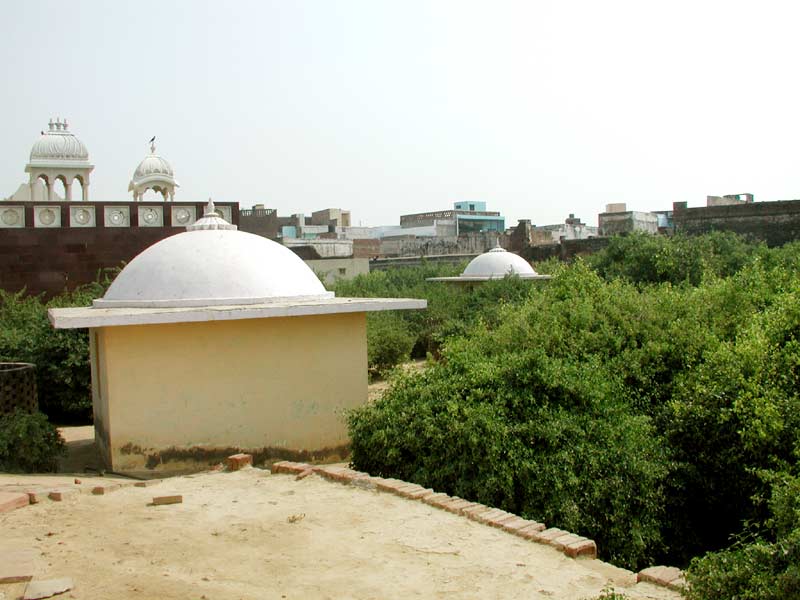
Swami Haridas used to please Sri Bihariji by sweetly singing devotional songs he had personally composed and played vina.
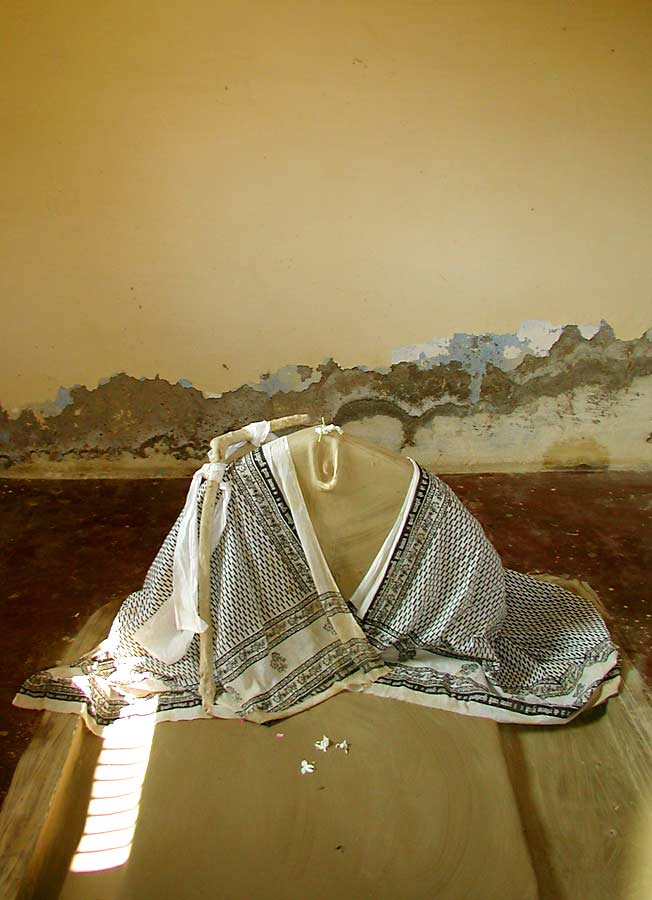
Tanasen and Baijubar were his famous disciples. When Maharaj Akbar heard from Tanasen, his minister, about the Haridas, he desired to hear his singing.
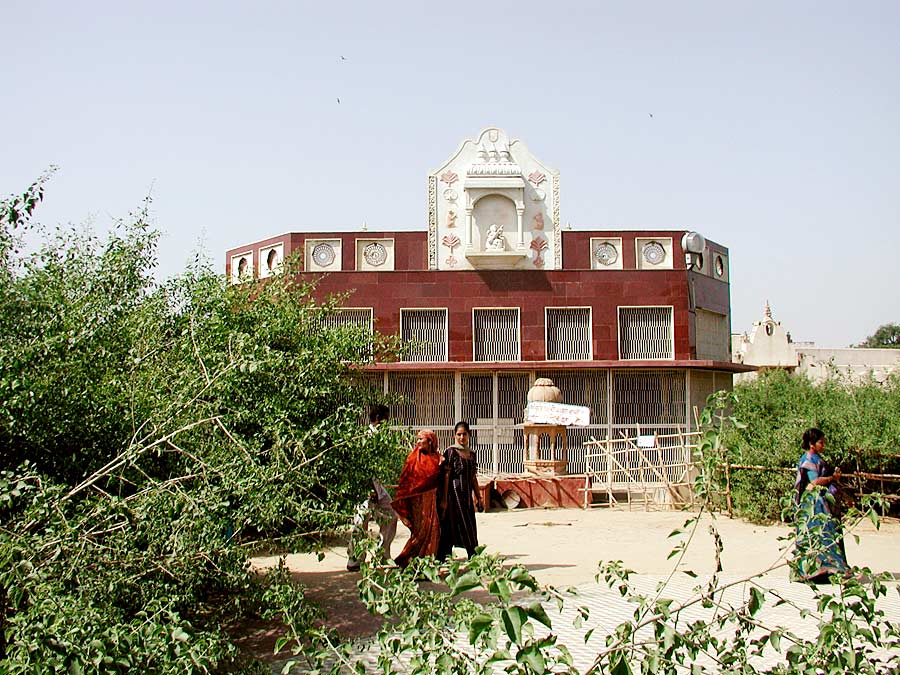
But Haridas had firmly resolved not to entertain anybody but His Bankebihariji. Emperor Akbar therefore resolved to disguise himself as an ordinary man and along with Tanasen went to his kutir at Nidhivan.

Tanasen, being a good musician, purposely brought his vina with him and began to sing in front of Haridas.
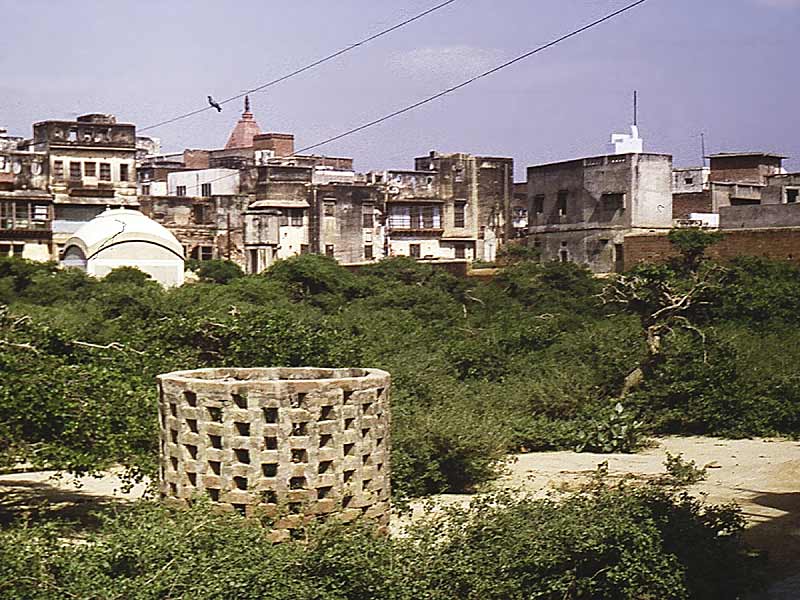
After a while, Haridas took a vina from the hands of his disciple and began to sing the same song pointing out his mistakes.

His singing was so sweet that even the deer, birds and other animals in the forest were attracted to come and silently listen.
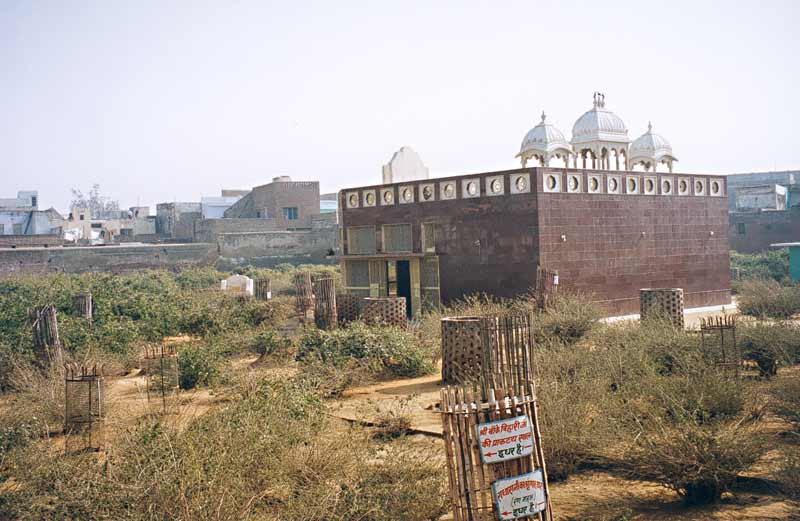
Akbar’s amazement knew no bounds. He was so pleased that he immediately wanted to present something for Swami Haridas, but the wise Tanasen advised him not to do so, since it would disturb Haridasa’s devotional mood.

In Nidhivan, Srimati Radhika sat on the royal throne in a kunj. Sri Krishna, dressed as a police officer, protected the entrance and guarded the area within it. This is called rai-raja-lila and Vaisnava poets sing about it in their songs.
. 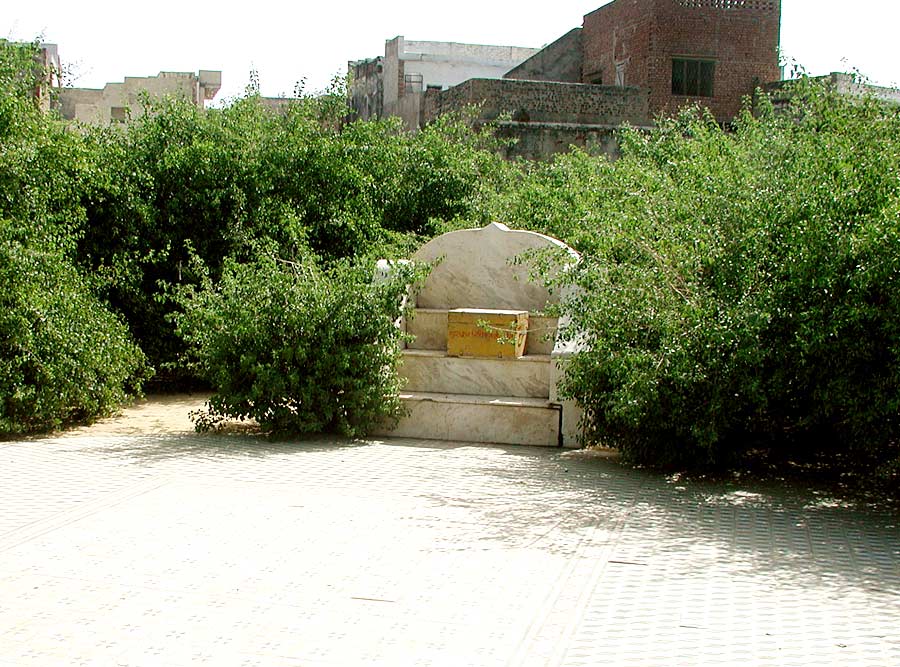
Because of keli-vilas during the night (nisa) which takes place at keli-kunjas at Nidhivan, the sayana-vilas or pastimes of sleeping at the end of the night (nisanta) also take place here.
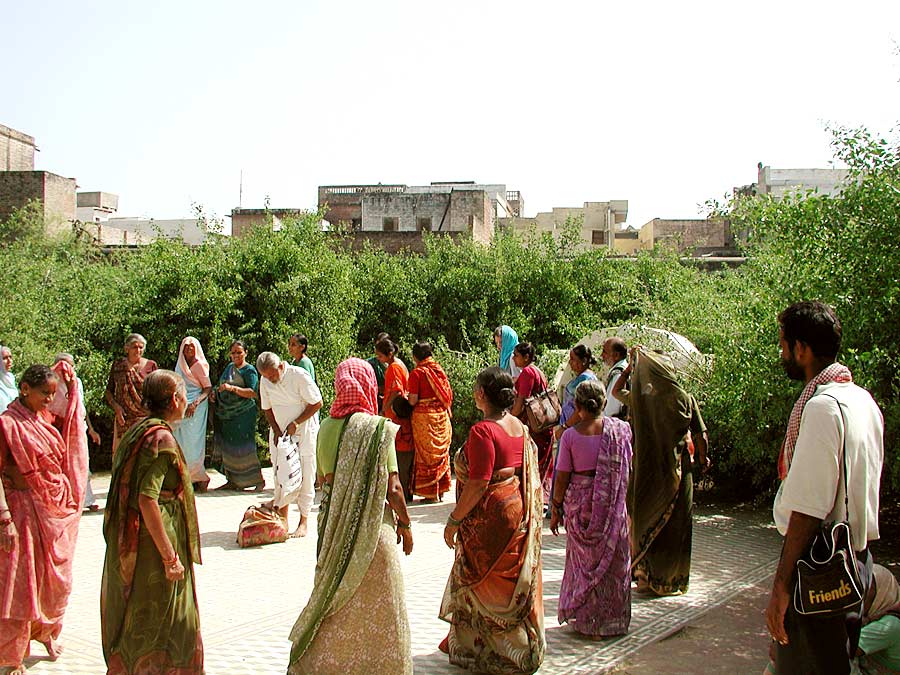
Seeing dawn approaching, Vrinda-devi becomes alarmed and orders the suka, sari, peacocks, cuckoos, bumblebees and others to make their sweet humming and other sounds to wake up Kisor and Kisori.

Once when Radha and Krishna Yugala were sleeping in keli-kunj of Nidhivan at the end of the night, Sri Vrisabhanu-nandini had the amazing dream. Upon waking, She woke Her Prana-vallabha and said: “O Lord, I just had an amazing dream. In that dream, I saw a river just like Yamuna. Along that river I saw beautiful bank resembling kunj near Yamuna in Vrindavan. On that bank I saw a wonderful golden-complexioned young man singing and dancing very beautifully.
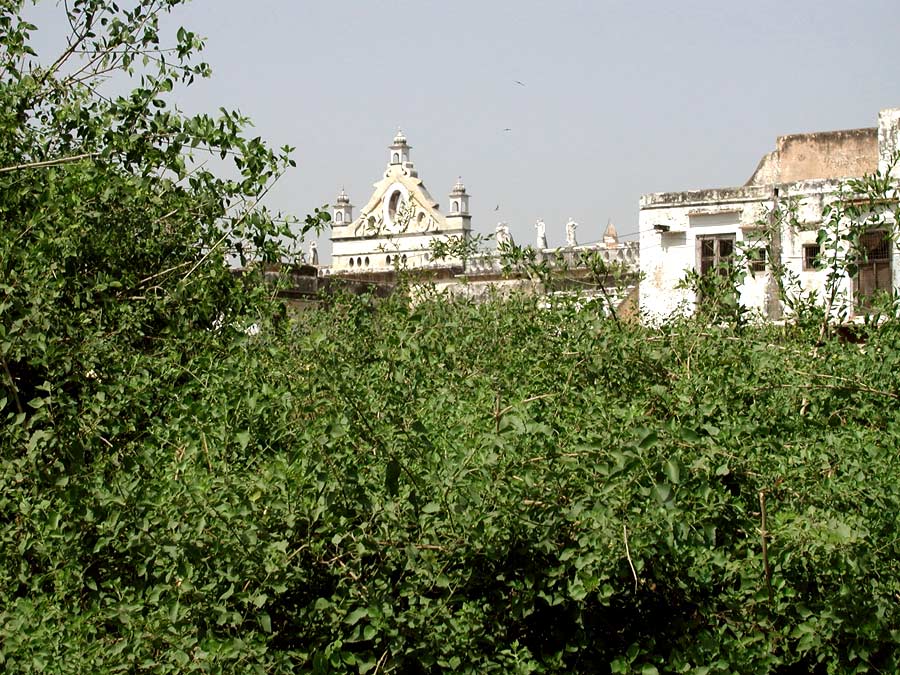
Being absorbed in an internal mood, He was carried away in dancing to the rhythm of the mridangas and kartalas. That gaura-kisor was crying: “Ha Krishna! Ha Krishna! and sometimes Ha Radhe! Ha Radhe! Where are You! Who is this golden-complexioned youth? Am I this gaura-kisor who is constantly crying Ha Krishna? Or is it You?”.
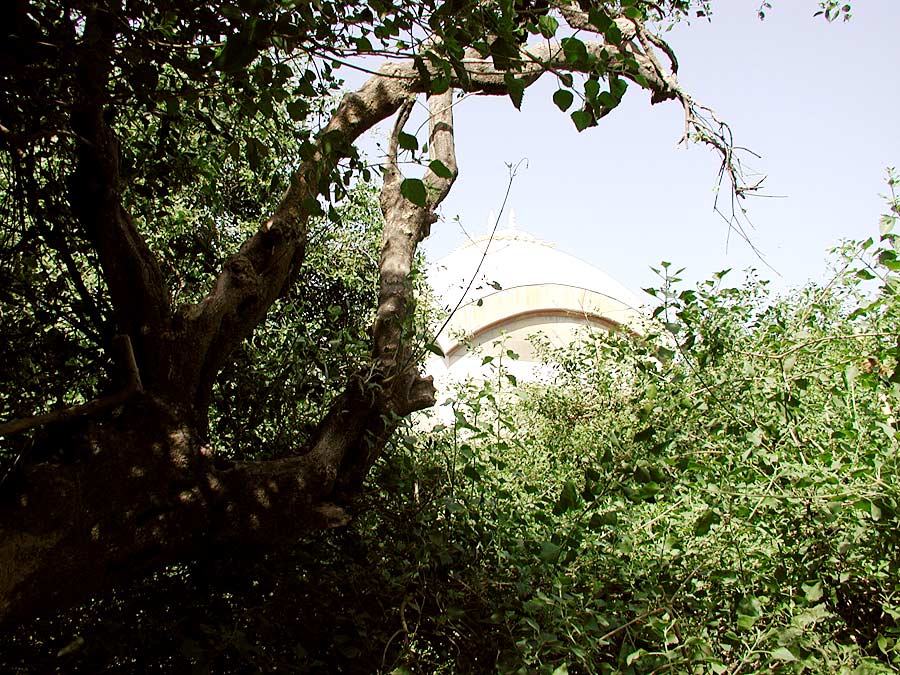 .
.
“He Radhe! At different times, I have given You the darsan of Narayan and other My forms, but You were never astonished. Who is this golden-complexioned youth, bewildering Your mind, I cannot say,” said Krishna and began to smile. Radhika replied: “Prana-vallabha! Now I understand that this golden form is no other than You! No other is able to infatuate Me in this way!”Sri Visvanath Cakravarti, Svapna-vilas

Entrance gate of Nidhivan:

Shahaji Mandir: Shahaji Mandir was built by wealthy jeweller Shah-kundan Lal from Lucknow in 1835.
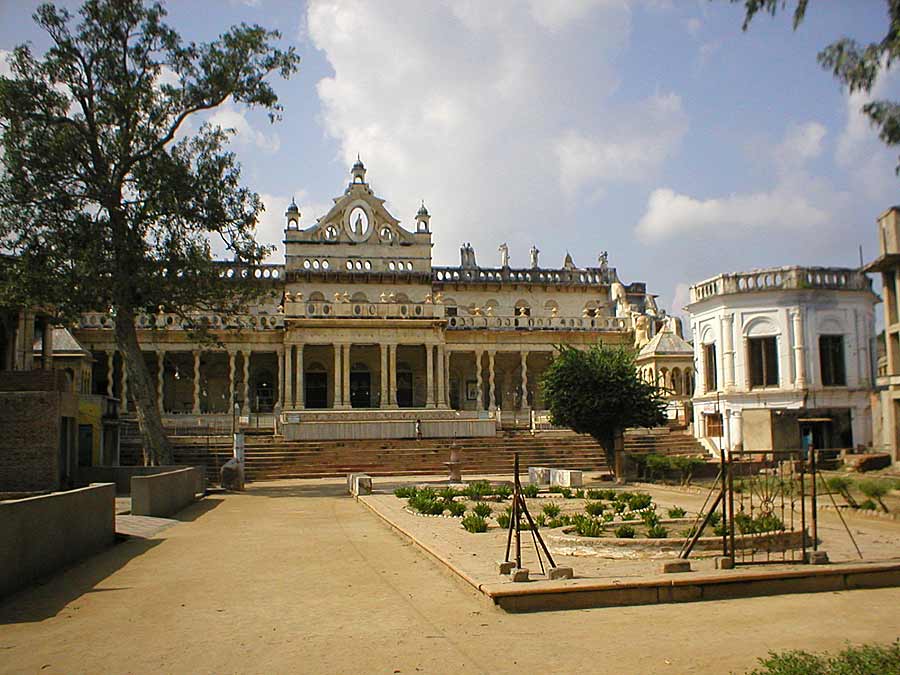 .
.
He was a disciple of one of the gosanis of Radharaman temple and was built for the Radharaman Deity.
 .
.
But the gosanis in the last moment decided not to move Radharaman from the old temple where it stayed for centuries and Chota-radharaman (“small Radharaman”) was installed instead.
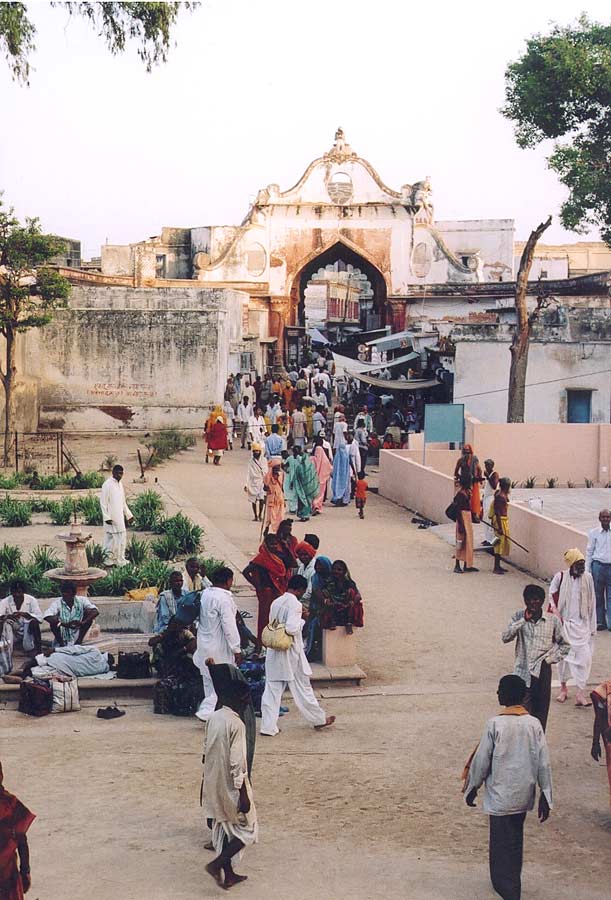
Mira-bai temple: Female saint Mira-bhai renounced the life of a princess and came to live in Vrindavan in this place. She is famous for her devotional songs.
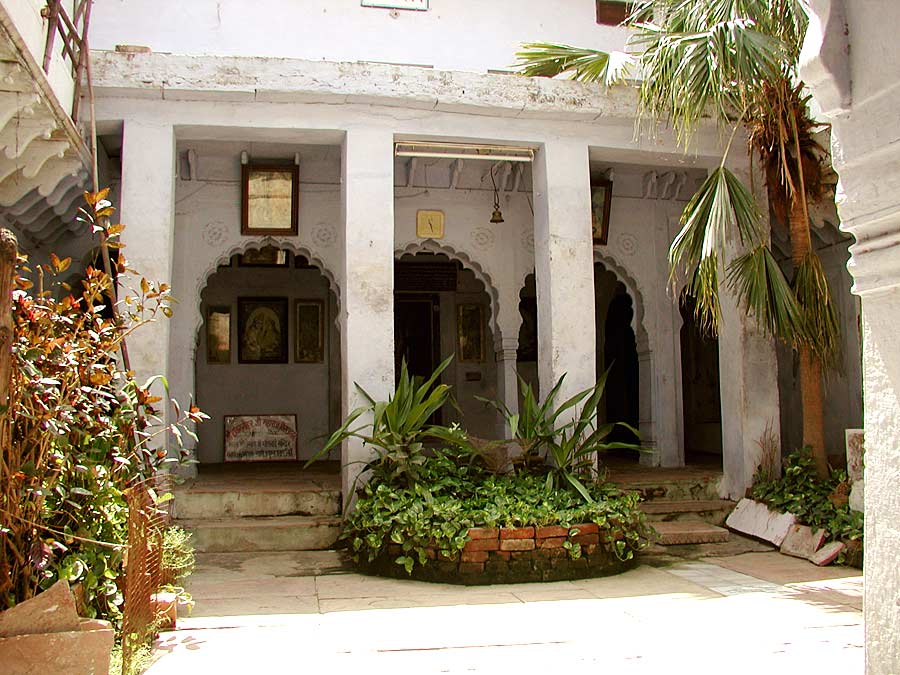
It is said that she encountered many problems and a plot was made to kill her by a snake. But by Krishna’s mercy, poisonous snake turned into a stone in front of Mira-bhai and thus was saved.

This sila (stone) is kept to the left on the altar.

Jugal-kisor Temple: When emperor Akbar visited Vrindavan in 1570, he gave permission to built this temple of Jugal-kisor. It stands next to Kesi-ghat and therefore it is sometimes called Kesi-ghat temple. 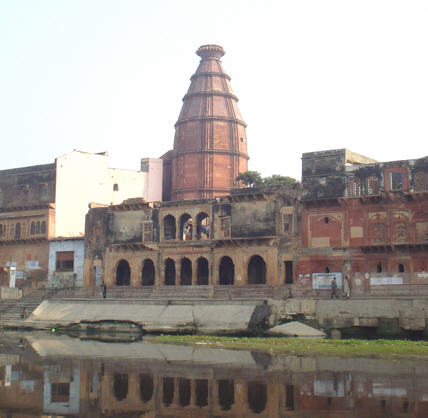
Although it is one of the oldest temples of Vrindavan, it was completely abandoned after desecration by Aurangzeb’s soldiers in 1670. No pratibhu-murti worship was conducted.
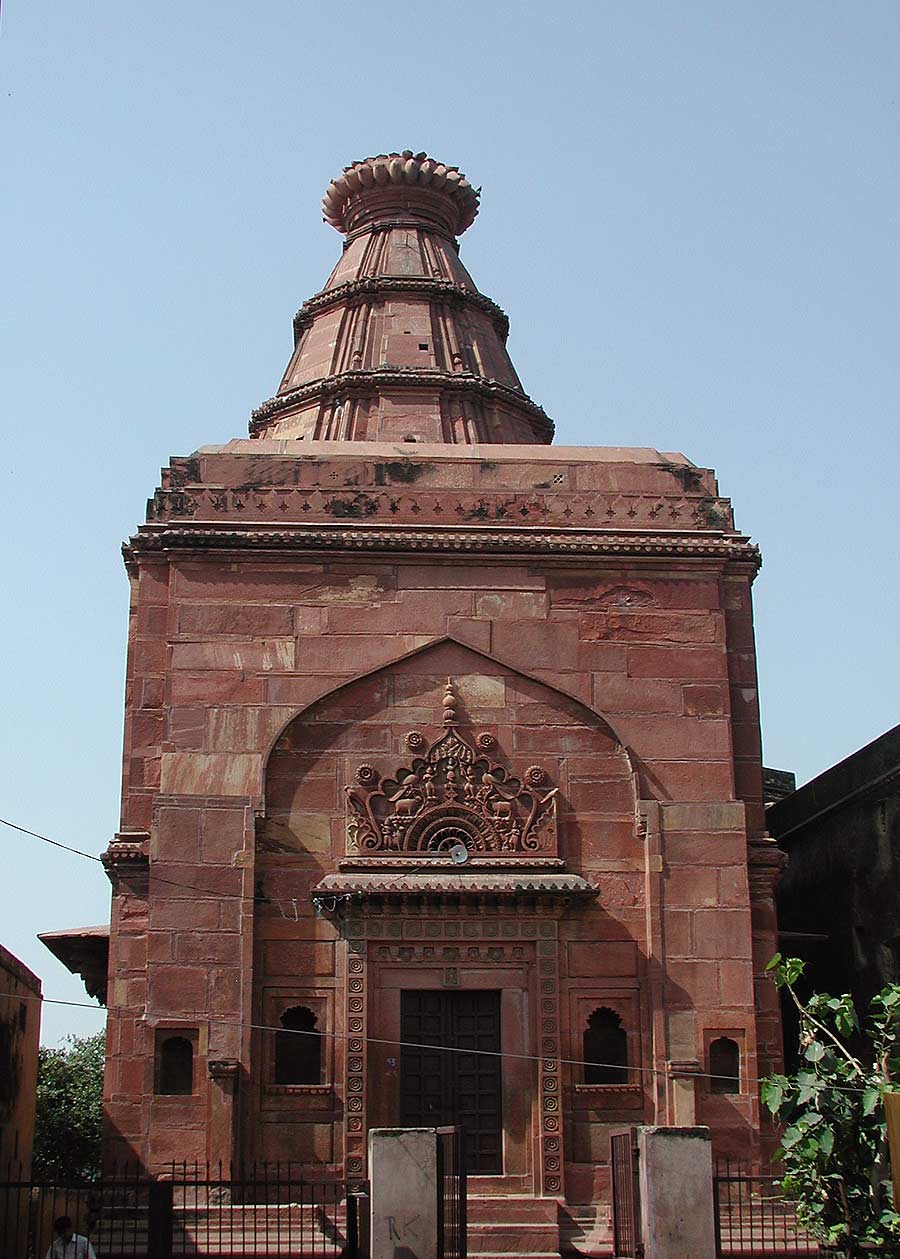

Gadadhar-dant Samadhi: Gadadhar Pandit was born a year after Sri Caitanya Mahaprabhu. He attended the same school as Lord Gauranga, lived close to each other and he grew almost inseparable from Him. When Sri Caitanya performed His Navadvip-lila, Gadadhar Pandit was His chief assistant and another name of Sri Caitanya is Gadadhar-prananath, the life and soul of Gadadhar.
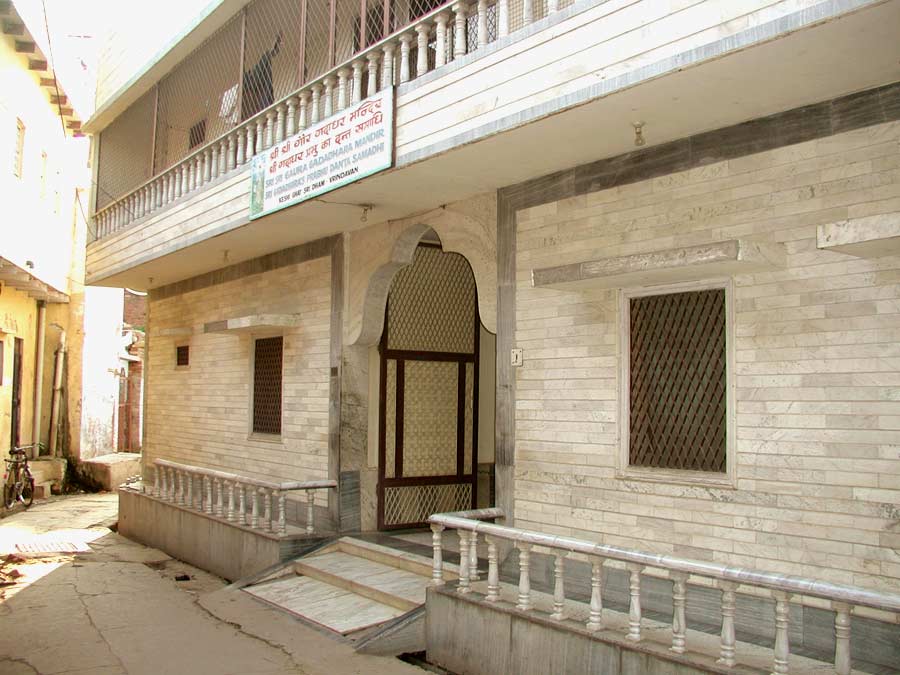
When Lord Caitanya accepted sannyas and went to Jagannath Puri, Gadadhar also accepted sannyas and followed Him. Gadadhar worshipped Tota-Gopinath Deity and Sri Caitanya told him to become ksetra-sannyasi and never leave Jagannath Puri. When Sri Caitanya ended His prakata pastimes He entered and disappeared into Tota-Gopinath Deity of Gadadhar Pandit. Gadadhar was an incarnation of Srimati-Radharani, as being a ksetra-sannyasi on the request of the Lord, never visited Vrindavan. His disciple Nayanananda brought a tooth (dant) of Gadadhar Pandit and entombed it here in this Gadadhar Pandit dant-samadhi.

Vamsi-Gopal temple: From 1956 to 1959, Srila Prabhupada stayed in this temple when he came as vanaprastha.
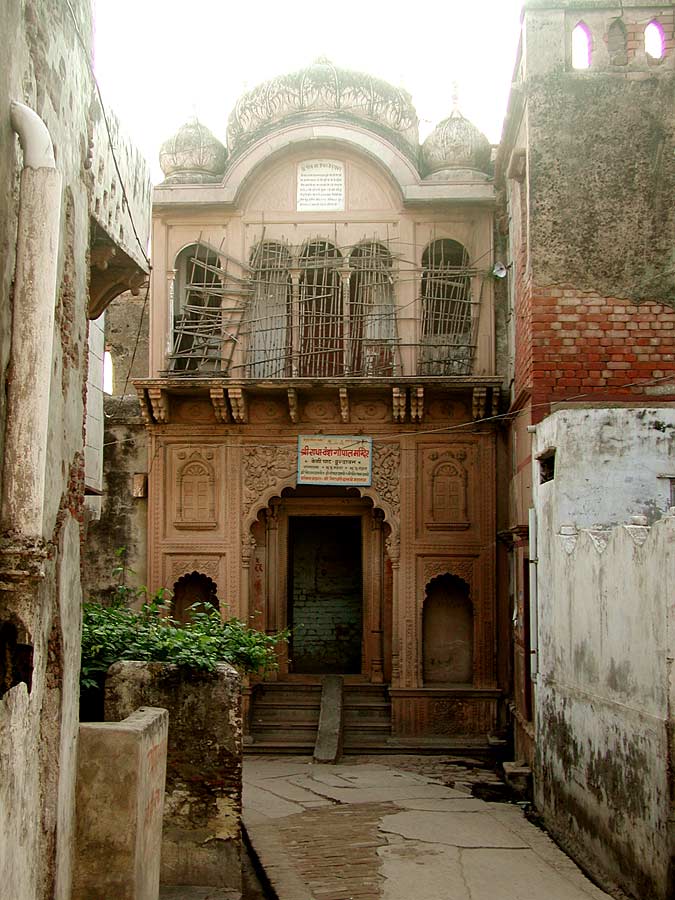
He lived in a room on the second floor before he had moved to Radha Damodar temple.
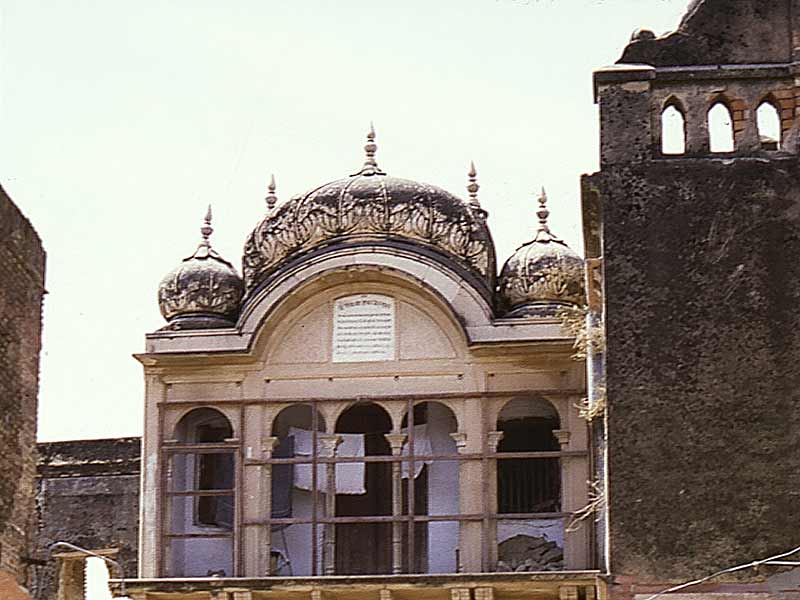
Loi Bazaar is Vrindavan’s most busy marketplace.
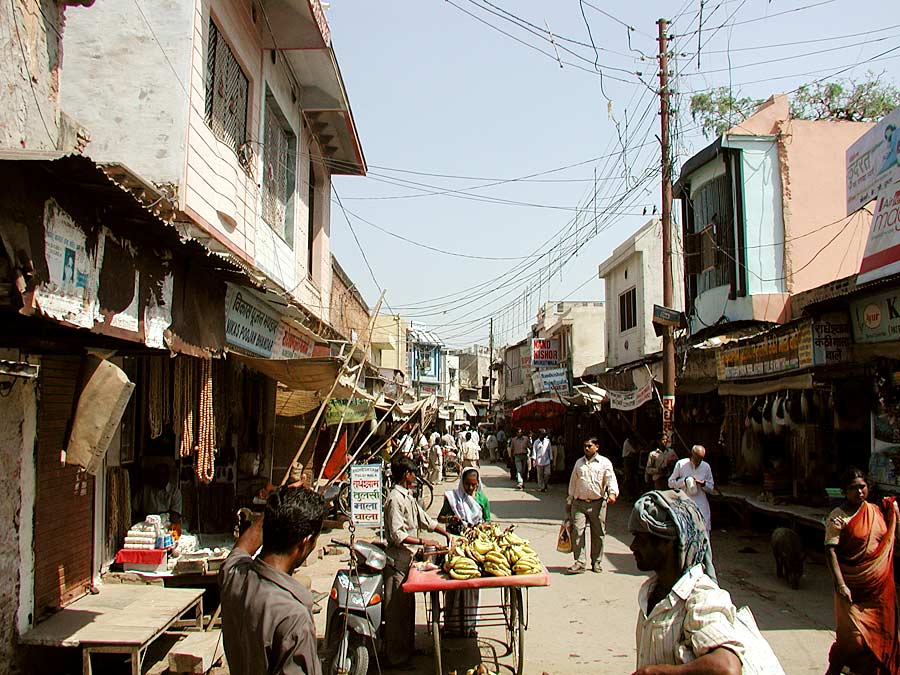
Here you will buy everything necessary like clothes, puja plates, fruits and vegetables for worship.

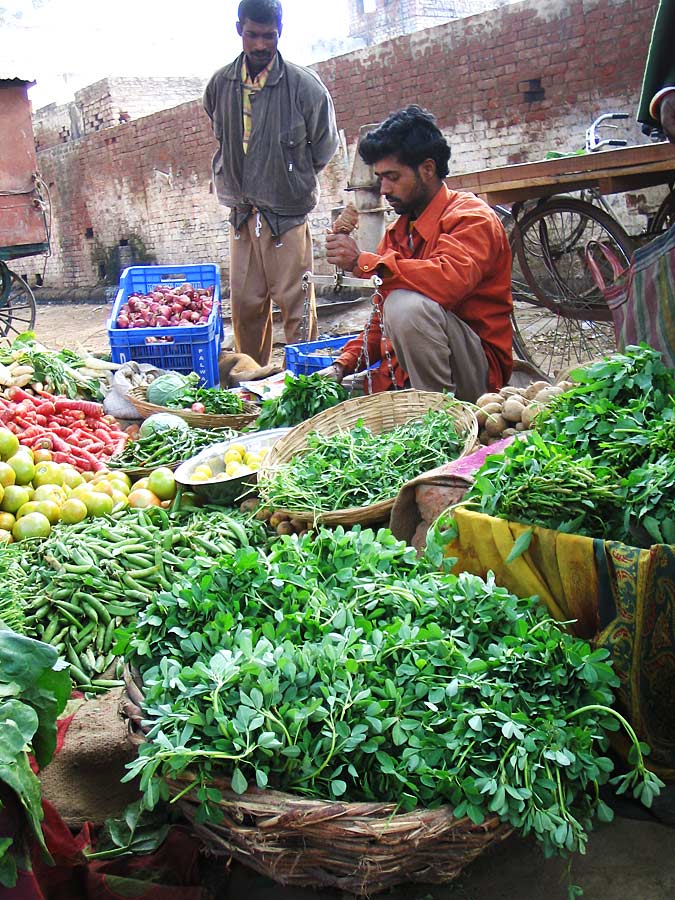
Sweatshop sellers cook milk almost the whole day.
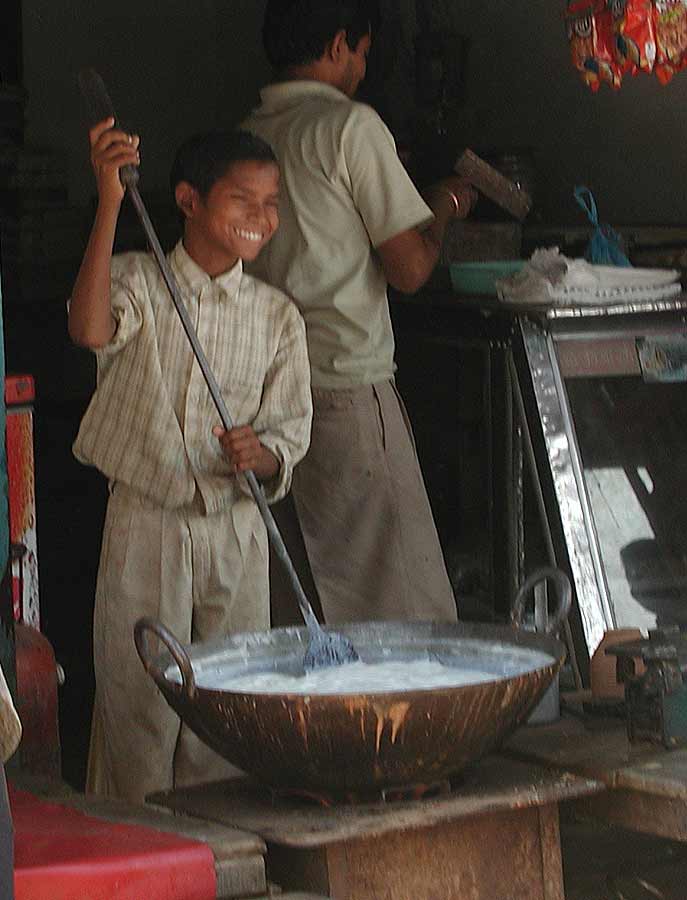
When it is thick and solid they sell it as an ingredient for making home sweets like gulab-jamuns.In India, gulab-jamuns are traditionally fried from this thick milk instead of dough made of powder milk like in the West.
Monkey on the roof is waiting for an opportunity to steal some banana or something glittering. Then it jumps like kamikaze for the fruit and before anybody realizes it is back on the roof. People usually laugh a lot except the fruit seller.
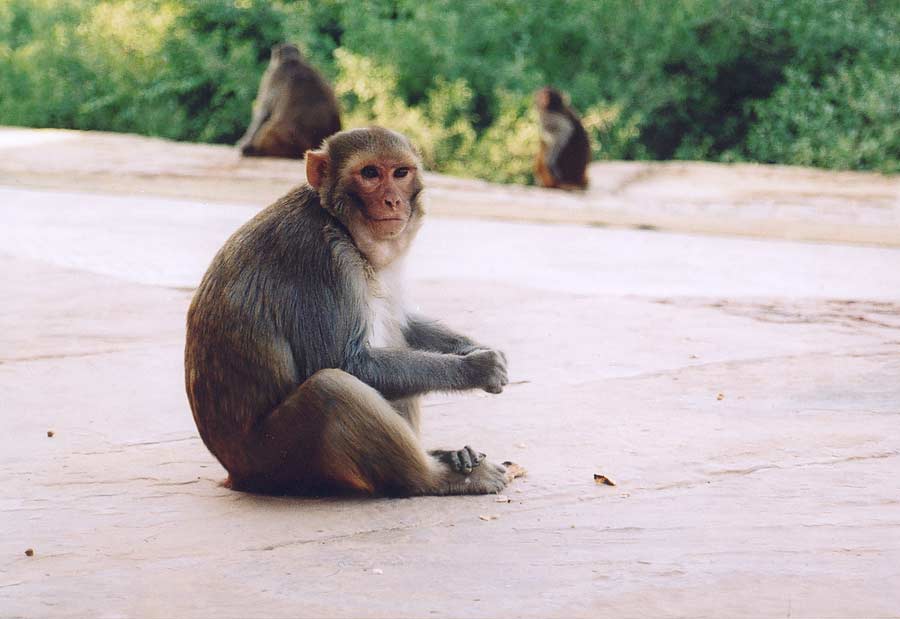
The four brajavasi kumaras!
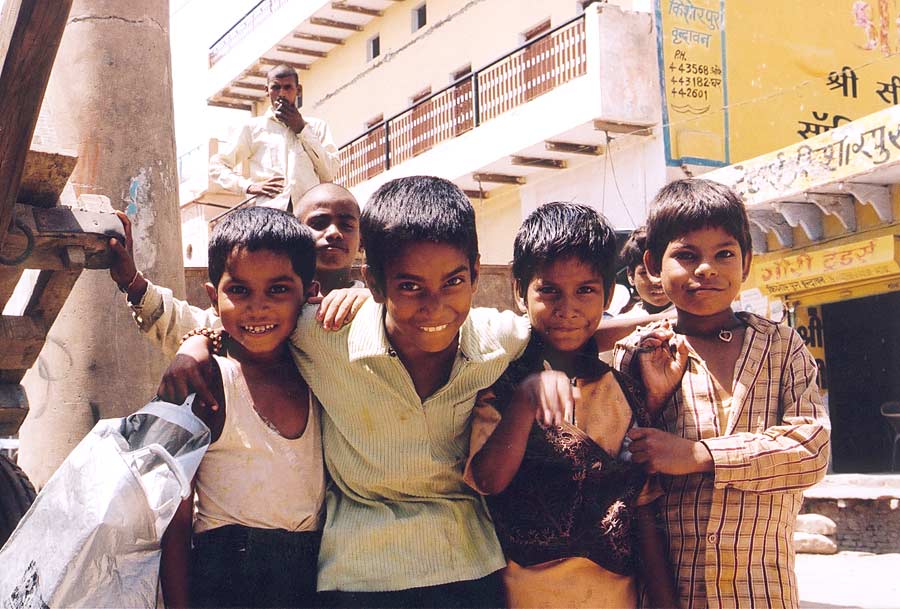
Gaura-Nitai temple of Murari Gupta: Since childhood, Murari Gupta was a great devotee of Lord Ramacandra. When he requested Sri Caitanya to allow him to make a Deity of Gaura-Nitai, Sri Caitanya told him to make them according to his own devotional taste.

These Deities are unique because They stand in tri-bangha form as Krishna and Balaram, Their hands are in the mudra of Ram and Laksman and Their hair is made up into topknot, just like Sri Caitanya and Nityananda in Navadvip. Murari Gupta was actually an incarnation of Lord’s devoted servant Hanuman.
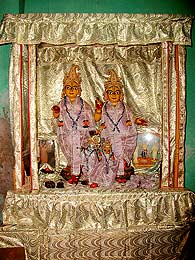
Ban-khandi Mahadev temple: While staying at Govardhan, Sanatan Goswami would take daily darsan of Cakaleswar Mahadev, and in Vrindavan he would go from his bhajan-kutir to take darsan of Gopiswar Mahadev. When he became too old, Mahadev appeared to him in a dream and told him: “Please do not undergo so much trouble seeing me. I shall manifest as Ban-khandi near your bhajan-kutir.
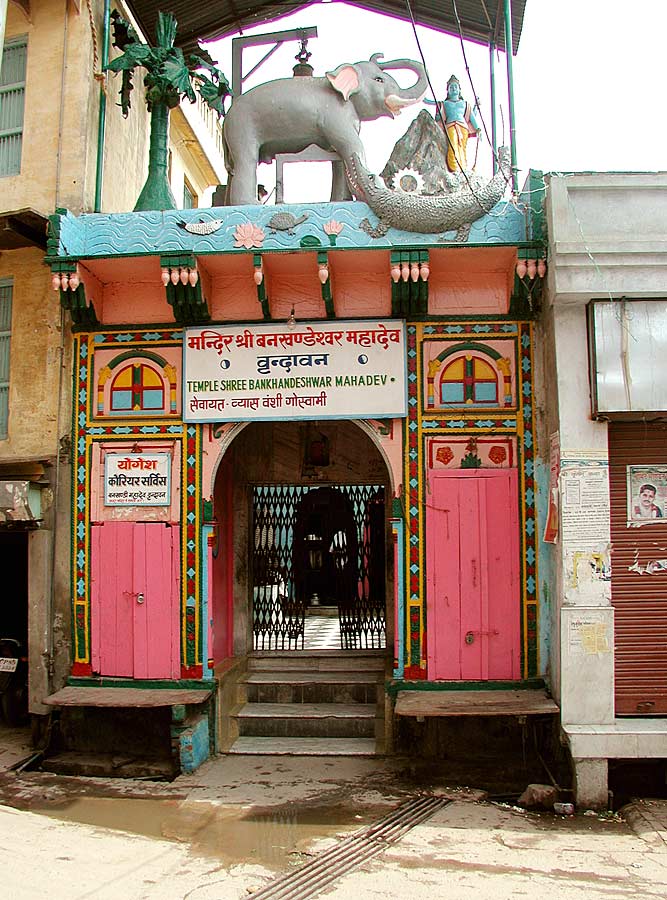
“Seeing Mahadev so mercifully manifested, Sanatan Goswami became overwhelmed with bhava. From then on, he would take daily darsan of Ban-khandi Mahadev before returning to his bhajan-kutir.

Seva-kunja (Nikunjavan) In this garden, Radha and Krishna perform Their eternal lila every night. Therefore each evening at sunset, everyone leaves the grove. No one is allowed within the enclosure at night. The numerous monkeys that are here during the day also leave at night.
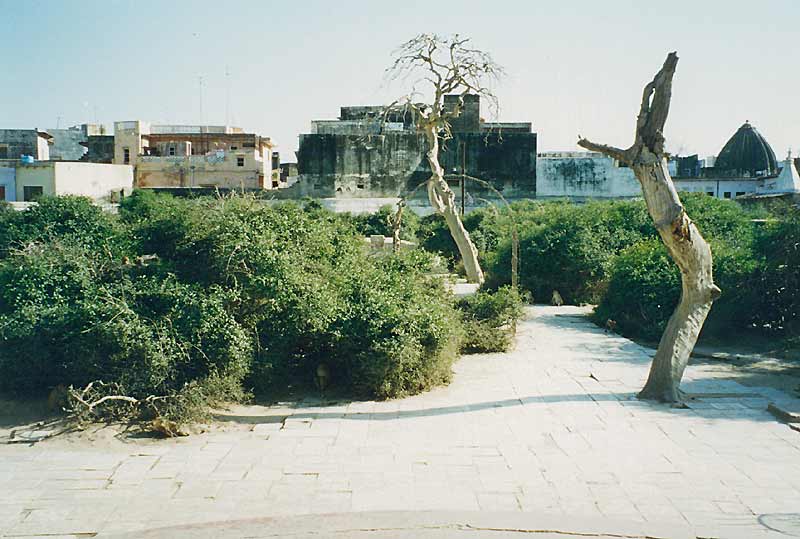
Krishna would massage Radharani’s feet and decorate Her hair with flowers here. There is no wonder that it is the place of topmost sacredness.
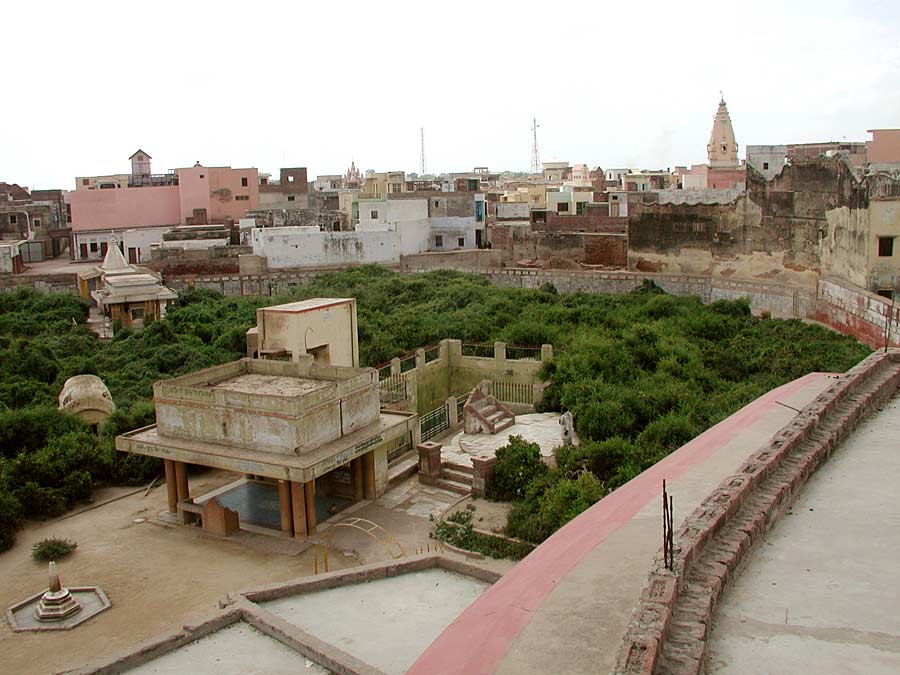
Trees in the garden are not ordinary trees, they are said to be great sages, who wants to touch Radha and Krishna’s lotus feet and their branches are heading downwards near the ground. Seva-kunj is the place of most intimate pastimes of Divine Couple and it is surcharged with spiritual atmosphere.

Once Krishna pushed his flute into the ground here and created a small kund, called Lalita Kund, to satisfy Lalita Sakhi’s thirst. The well is still there within the central part of the garden.
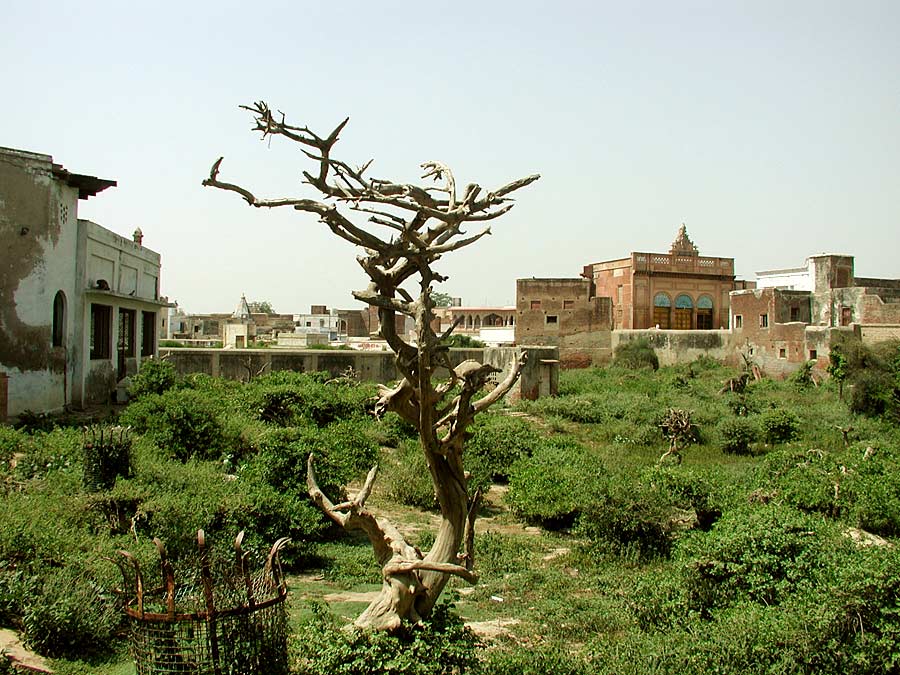
Next to Seva-kunj, separated by wall, there is adjoining garden called Kisori-kunj or Kisori-van.
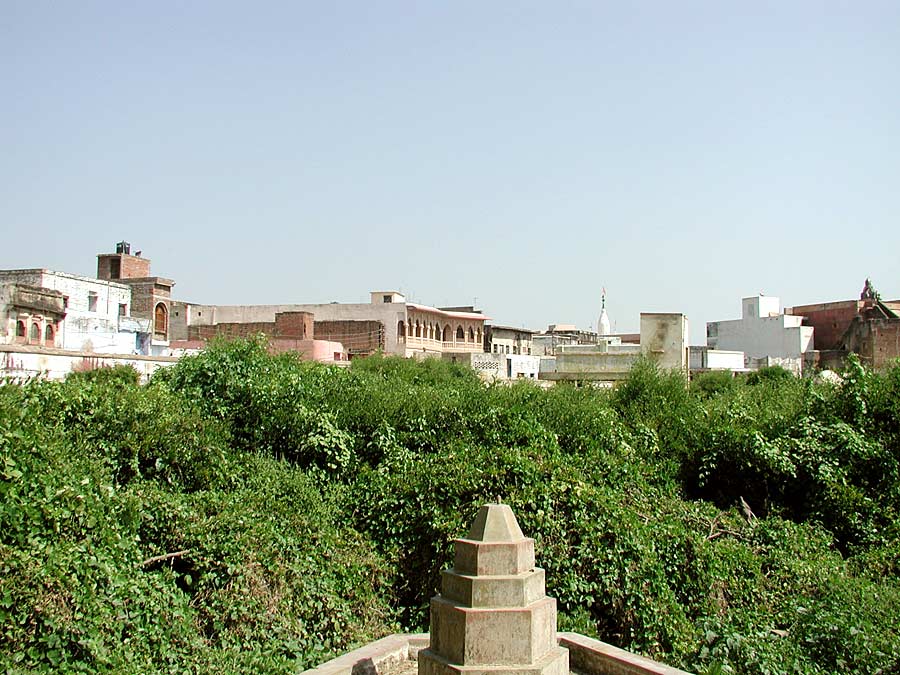
In 1516 Rupa and Sanatan arrived in Vrindavan. Lord Caitanya ordered the two brothers to uncover the places of Krishna’s pastimes. They lived austerely, halting each night under different tree.

By their inner vision as Sri Rupa Manjari and Labanga Manjari, they revealed the site of Krishna’s sporting for the benefit of others. “Vrindavan is a gift of Rupa and Sanatan Goswamis,” Srila Prabhupada used to say. For short periods they stayed at selected places.

Rupa Goswami performed his bhajana at Ter Kadamba (near Nandagram), Varsana, Radha-kund and Seva-kunj. Their bhajan-kutirs were not brick or wooden structures, but a temporary arrangement like hollow of a tree, a clearing under a thorny thicket, or an underground cave. Jiva Goswami spent some time in Nanda-ghat in a vacant crocodile hole.

In these austere natural settings, Rupa and Jiva chanted harinam and wrote the most exalted and sublime transcendental literature about the intimate affairs of Radha and Krishna. Sanatan would sleep only two or three hours and at night he would burn dry leaves and with that light, he would write his books.

At that time, Vaisnavas were writing their book on palm leaves, bark or even old Deity dresses. The Goswamis, however, used hand made paper which was kindly donated by Jaipur kings.
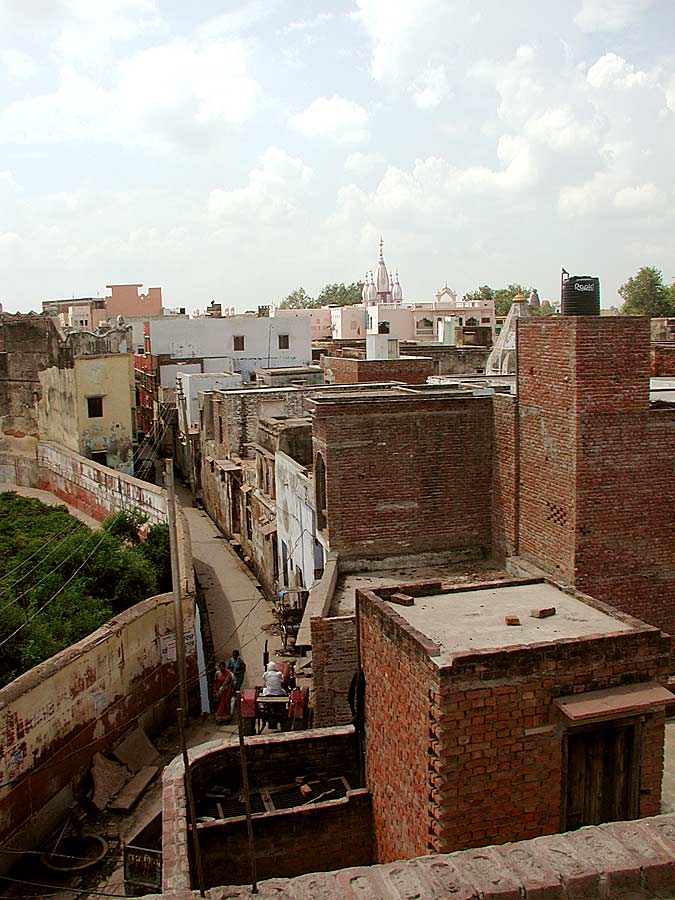
Rupa Goswami didn’t take any land or any deed. Then Seva-kunj was a large area. There were no temples, no buildings, no construction, nothing. The emperor’s landlord, who owned the area, was thinking ‘I am so fortunate that Rupa Goswami is living here on my land’.

‘With Sanatana Goswami’s disappearance in 1588, Jiva Goswami officially purchased the land, to preserve Seva-kunj for the Gaudiya-vaisnavas. Seva-kunj is a special sacred place for many reasons. Here, Sanatan Goswami worshipped his beloved Madanmohan Deity and later entered samadhi. Supreme Lord Damodar appeared here to accept service from Sri Rupa and Sri Jiva Goswamis.

Many famous Vaisnavas lived here and attended Rupa Goswami’s realized discourses on prema bhakti. And most significantly, within Seva-kunj, Sri Syamasundar eternally enjoys pleasure pastimes with Srimati Radharani and the gopis.
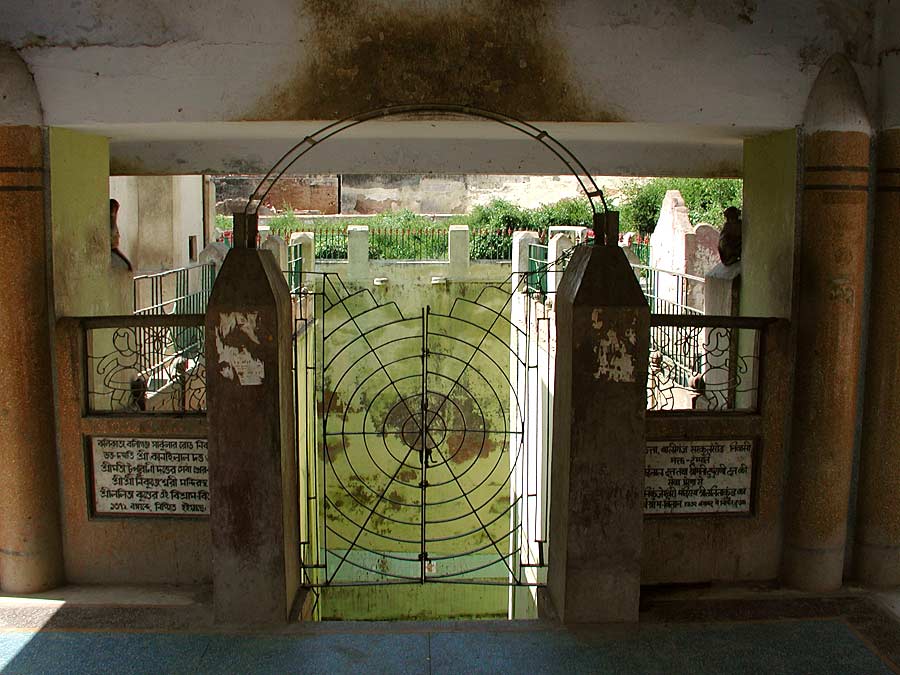
For thirty rupees, Jiva Goswami bought the plot from Emperor Akbar’s landlord Ali Kant Chaundhari. The tract encompassed Seva-kunj, Dan-gull, Imli-tala, Sringar-sthali and Rasa-sthali. Its boundaries were marked by four trees: tamarind, banyan, pipal and kadamba.

Being the youngest, Jiva Goswami inherited many of the elder Goswami’s writings, Deities, properties and temples. He personally managed the temples of Madanmohan, Govindaji, Gopinath and Damodarji.
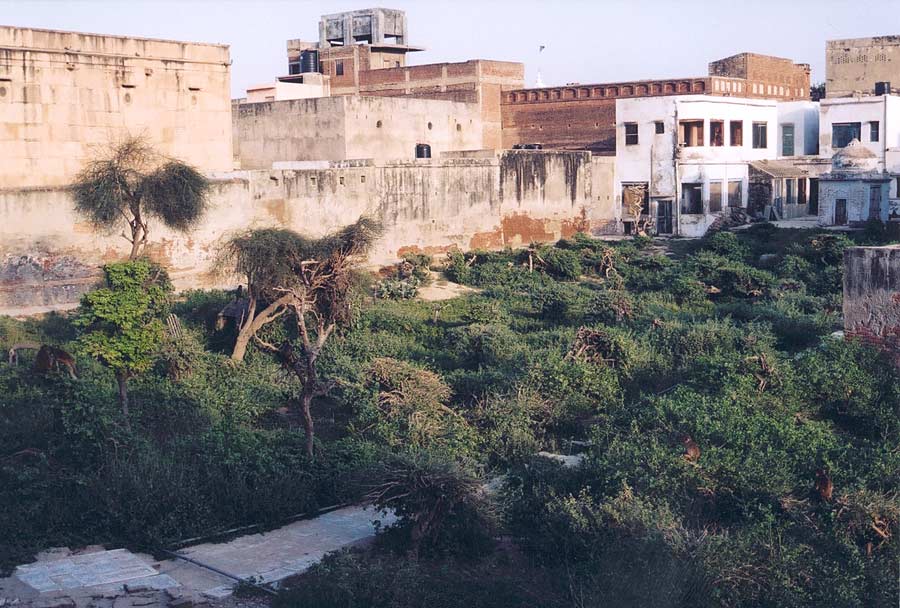
At the request of Raghunath das Goswami, he assisted in excavating Radha-kund and was the supervisor of his will. Although he was a leader of gaudiya-sampradaya, he always consulted important matters with other Vaisnavas.
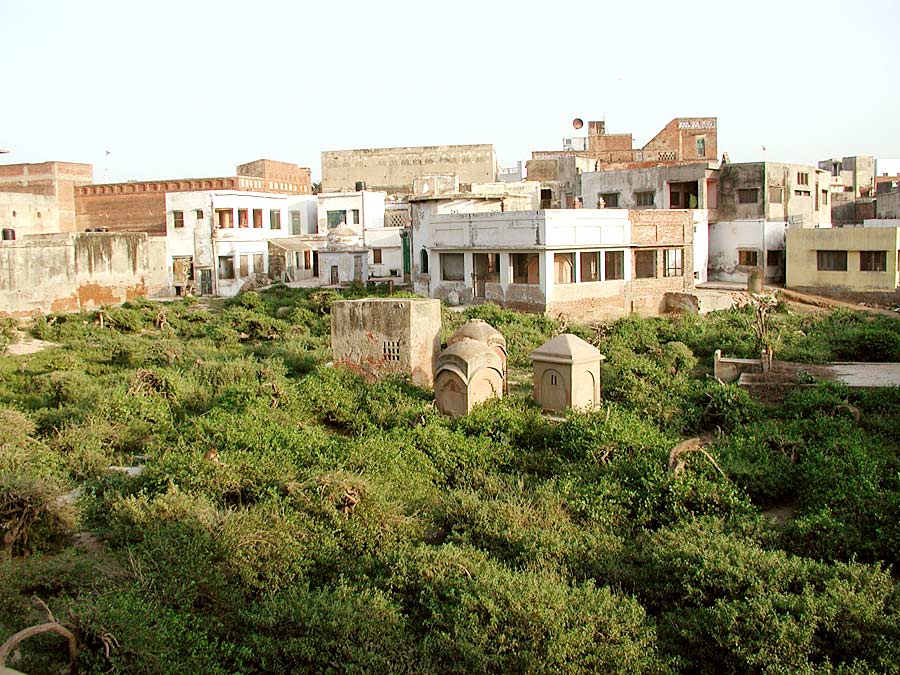
In 1582, he had called a meeting at Radha-Damodar and together with Gopal Bhatta Goswami, Raghunath Bhatta Goswami, Radha- Krishna Goswami and Haridasji and decided to send Srinivas Acharya, Narottam das Thakur and Syamananda Pandit to preach in Bengal, Manipur and Orissa with the copies of Goswami’s writings.
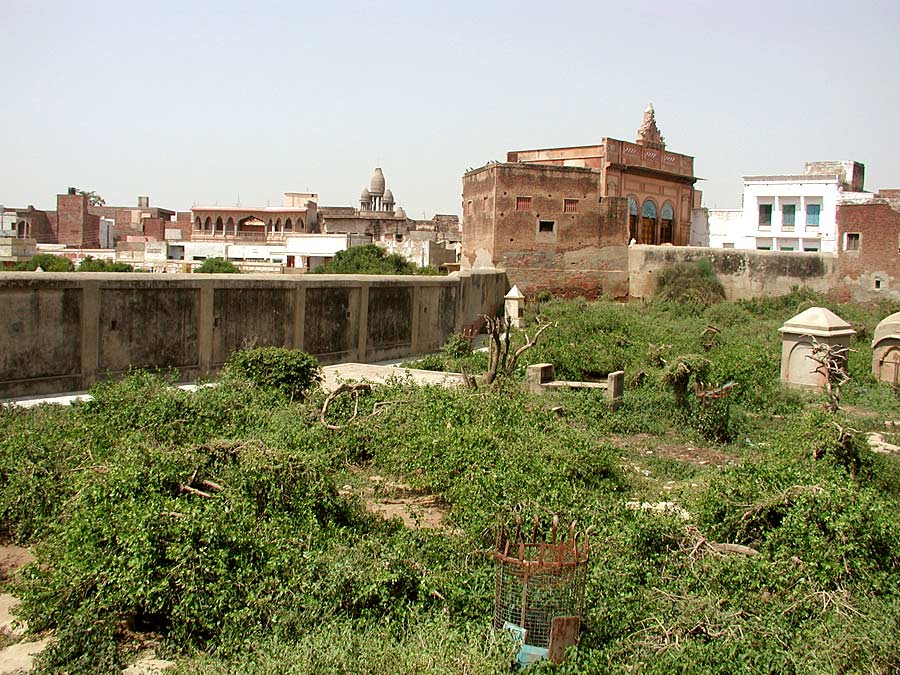
In 1570, Moghul Emperor Akbar came to Vrindavan to meet widely acclaimed Goswamis. After receiving darsan of Nidhivan and Jiva Goswami, the Emperor was deeply impressed and reciprocated by erecting a library at Radha-Damodar temple. Emperor Akbar, an adherent of religion and philosophy, once invited Jiva Goswami to his royal palace to debate about the ontological positions of Ganga and Yamuna rivers.
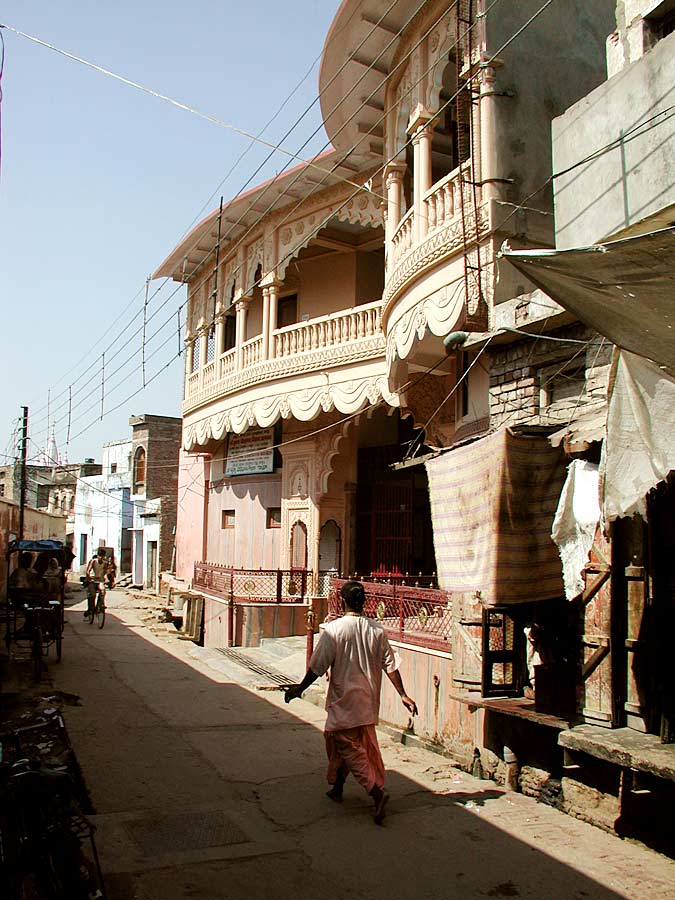
Jiva Goswami declined because of his vow never to leave Vrindavan. He conceded, however, after the eight hearty horses and a promise of return by evening. Years later, Jiva Goswami praised Emperor Akbar in Govinda-mandir-astaka (carved on the walls of Radha-Govinda Mandir) saying “Emperor Akbar is a very kind hearted person and a Vaisnava. I give my blessings to Emperor Akbar. In his kingdom all the Vaisnavas are living very peacefully.

“Gaudiya Math near the entrance of Seva-kunj is the residence of Bhaktivaibhava Puri Maharaj, one of the disciples of Bhaktisiddhanta Sarasvati.
Sitanath Temple:
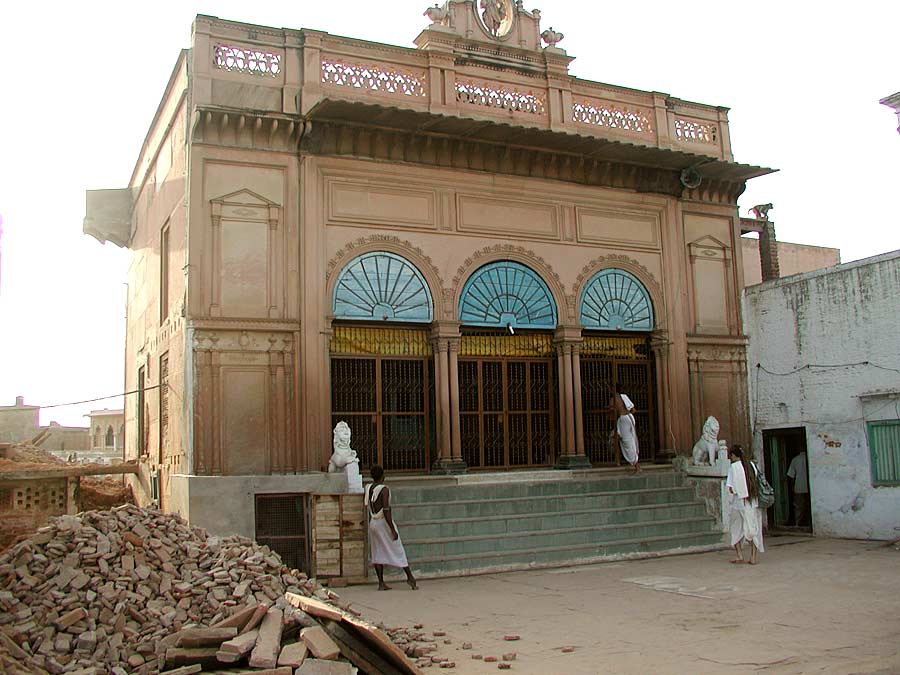
Sitanath is a Deity of Sri Advaita-acarya. “Nath” means “lord” and “Sita” is the wife of Advaita. “Sitanath” therefore means “the lord of Sita”, Advaita-acarya.Advaita-acarya is an incarnation on Sada-Siva and Maha-Visnu and He is the close associate of Sri Caitanya Mahaprabhu.

He appeared prior to Lord Caitanya and by His calling and prayers, Sri Caitanya appeared.
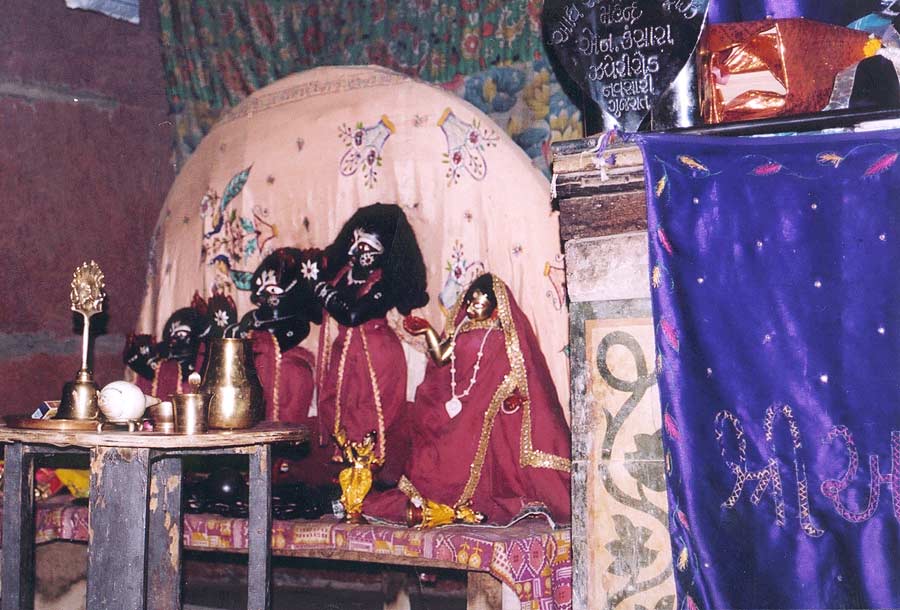
From the courtyard one can see both Seva-kunj (right) and Kisori-kunj (left).
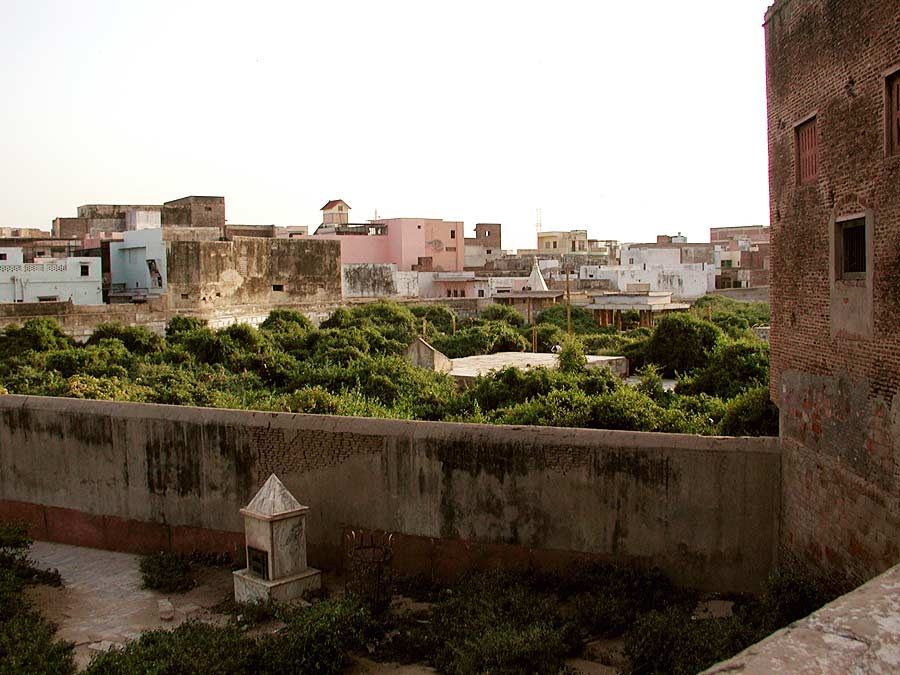
Paurnamasi temple: Paurnamasi is an incarnation of Krishna’s internal potency Yogamaya. Brajvasis consider Paurnamasi their guru as she plays important role in arranging of loving pastimes of Radha and Krishna. Original deity of Paurnamasi is at Sanket, between Nandagram and Varsana.
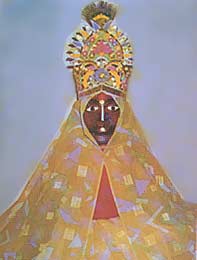
Nrsimhadev temple: On the way to Radha-Vallabha mandir, there is a temple of Nrsimha Deities, which is one of the few temples in Vrindavan.
. 
Sri Nrsimhadev is carved out of wood and Laksmi and Prahlad Maharaj are on His sides.
Radha Vallabha temple: The original temple of Radha Vallabha (right) was desecrated by Muslims in 1670 and a new temple was constructed next to it (left entrance). Original murti is now worshipped in this new temple. Sri Hitahari-vamsaji received Radha-Vallabha Deity as a dowry at his wedding.
.
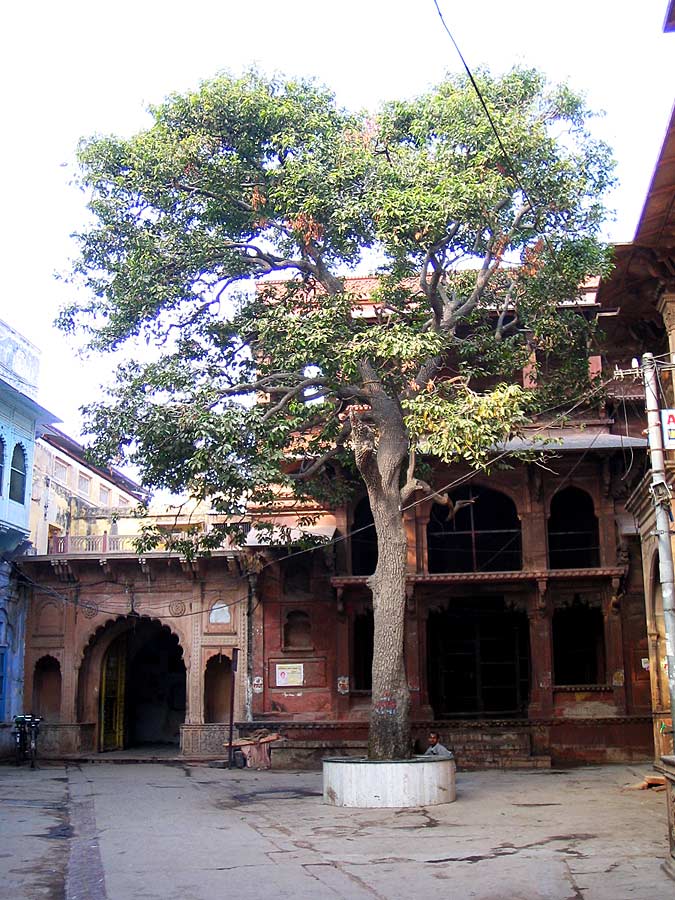
There is no vigraha of Srimati Radharani; instead crown is worshipped on the altar. Radha-Vallabha Deity is extremely beautiful.
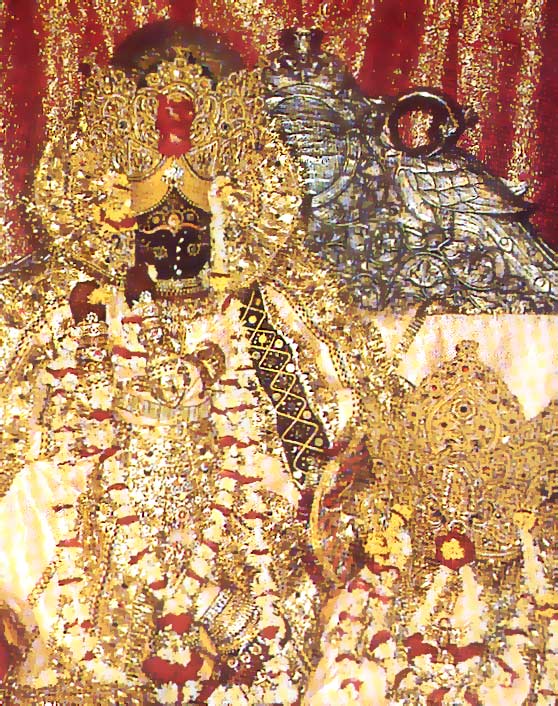
In the same compound there are also temples of Radha Ananda-vallabha, Radha Jivan-vallabha and Radha Kisori-vallabha.
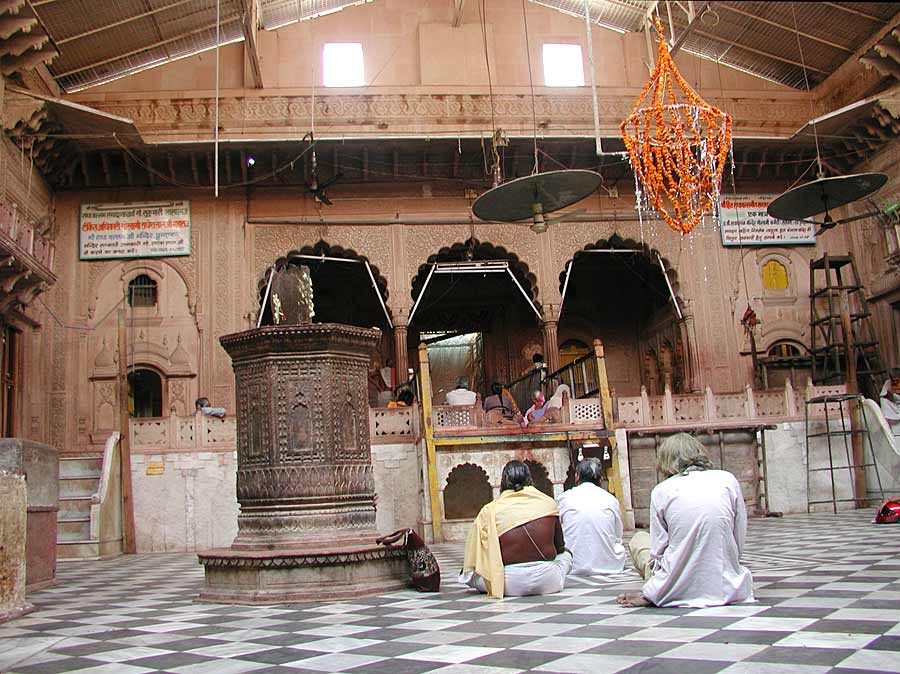
Bhattaji Mandir: Near Radha-Vallabha temple, there is another Madanmohan Mandir where personal Bhagavatam of Raghunath Bhatta Goswami can be seen. That is why it is called “Bhattaji” Mandir.
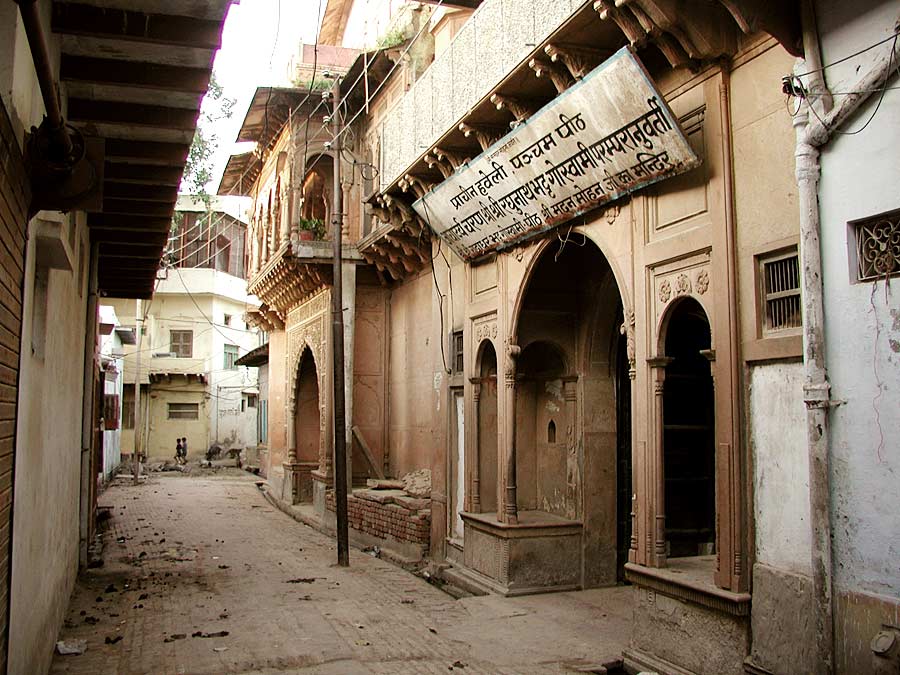
Raghunath Bhatta was famous reciter of Srimad-Bhagavatam and as he chanted the verses in three different ragas, his audience would experience all kind of spiritual transformations. 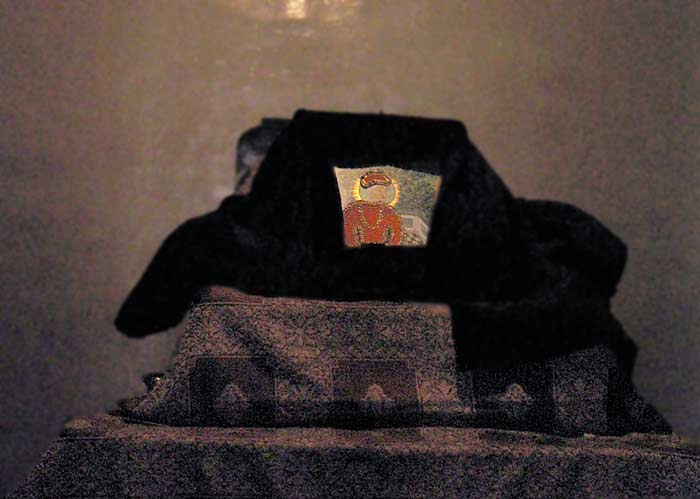
Banki-bihari temple: This temple was established by Haridas Swami, a contemporary of the six Goswamis. He found Banki-bihari Deity in Visakha-kund in Nidhivan. There is no mangala-arati in this temple. “Thakurji performs rasa-lila every night and goes to sleep early in the morning. It is improper to wake Him up so early,” says by the priests from the temple.
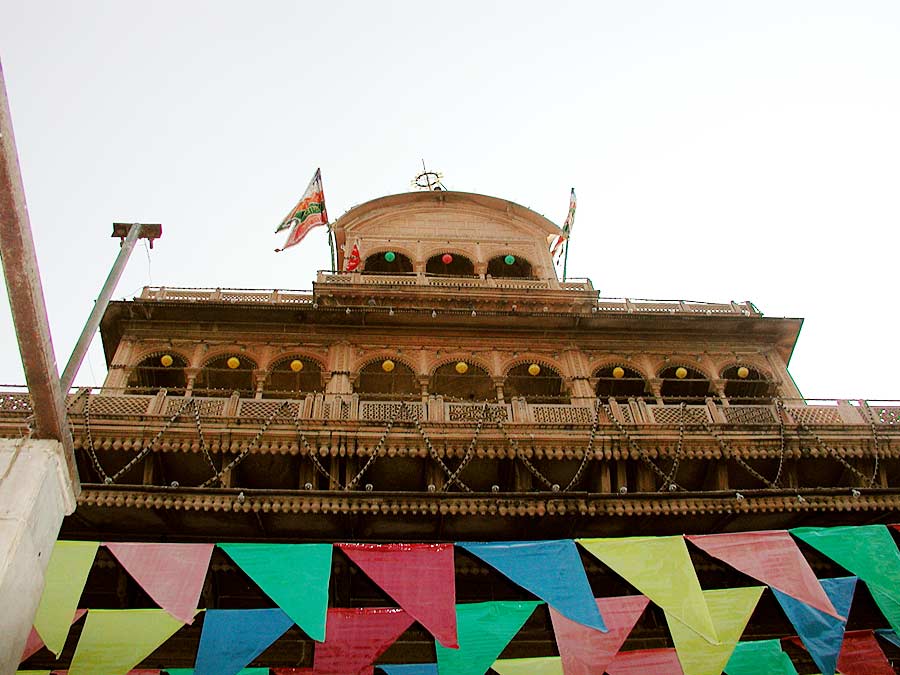
Once a great devotee came to Banki-bihari mandir and for a long time gazed at the Deity. Banki-bihari became so attracted to him that He went with him to his village. Goswamis of Bihariji found it and after much pleading the devotee and Banki-bihari, brought Him back to the temple.
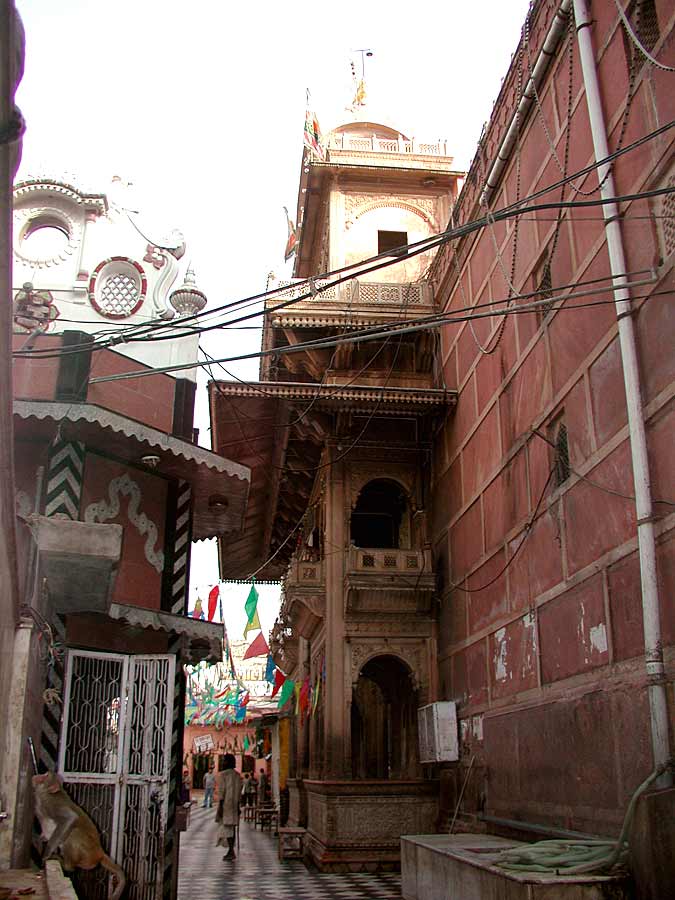
After this incident, a jhanki-darsan (momentary darsan) was introduced. The curtain before the Deities is not left open. Every few minutes, the curtain is shut and then opened again. This is just to make sure that no one will gaze at Him for a long time and thus bhakta-vatsala Banki-bihari will never again leave temple following His devotees.
During the Mughal oppression, Banki-bihari stayed secretly in Vrindavan and did not leave. Banki-bihari is the most popular temple in Vrindavan, especially during Jhulan Yatra in the month of Sravana.
Astha-sakhi temple: This temple was built in 1912 by Ramranjan Cakravarti, the king of Hetampur form West Bengal.

His wife had a dream in which Sri Krishna asked her to build a temple of eight sakhis: Sudevi, Tungavidya, Indulekha, Visakha, Lalita, Citra, Campakalata and Rangadevi. In the center, stands Radha-Rasabihari and four sakhis (maidservants) are on each side.
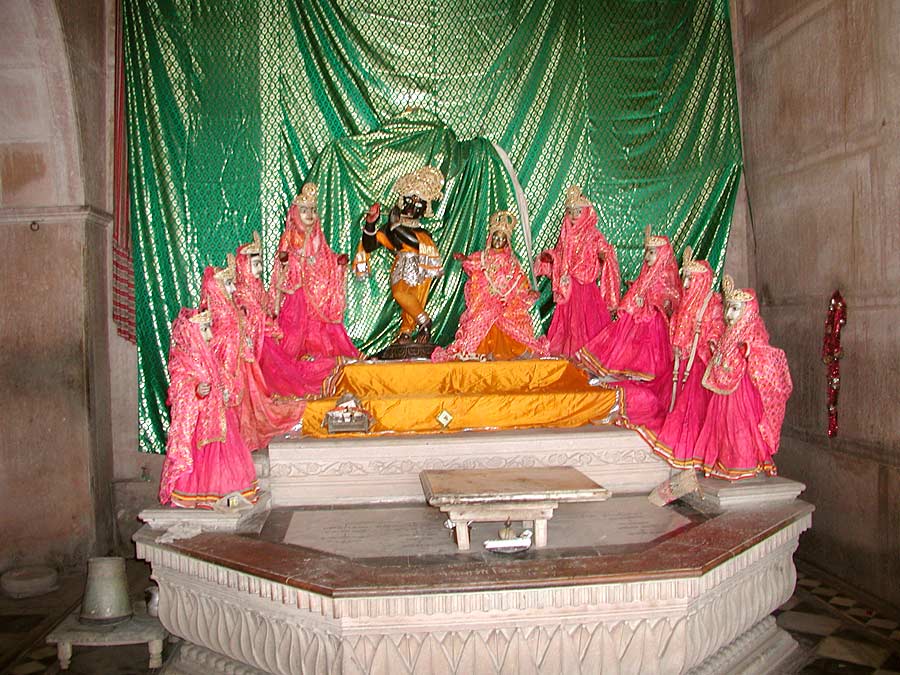
The temple is near Madanmohan mandir and to find entrance is a little tricky.
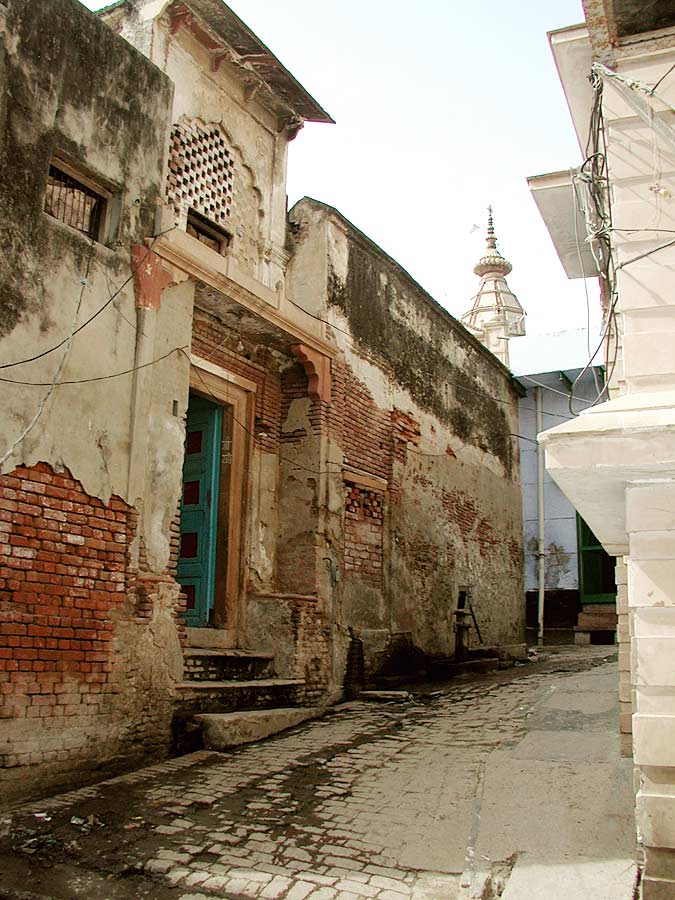
Vrindavan is a small town atmosphere with narrow streets.
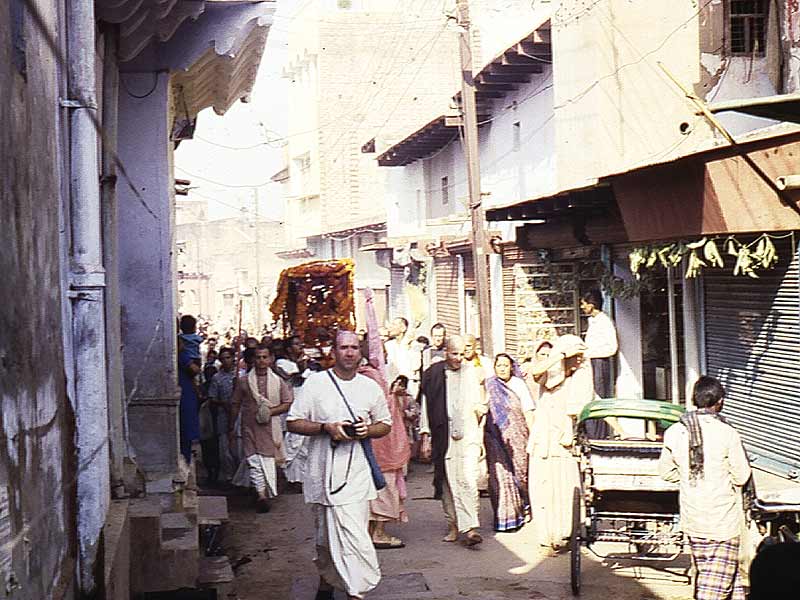
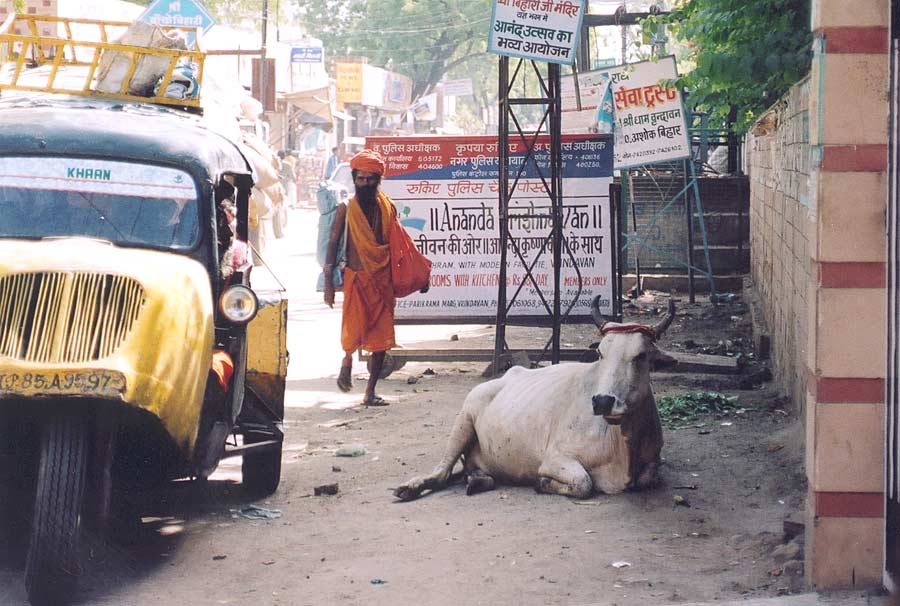
Batharan-bihari temple: Where Krishna’s friends’ begged food from brahmana wives is near Akrura-ghat. Brahmanas wanted to be promoted to the heavenly planets and refused to give food as charity to cowherd boys (vaisyas) despite of their asking in the name of Balaram (son of Vasudev and therefore ksatriya by birth). They would give it only to twice-born brahmanas, but their wives recognized through their devotion to Krishna and Balaram and happily gave Them what they could.
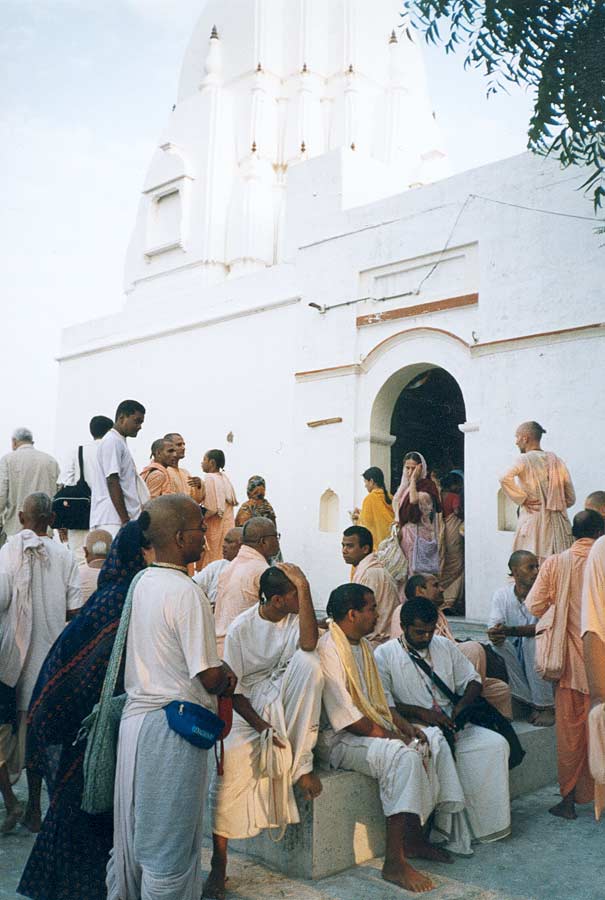
The boys than sat at this spot and enjoyed wonderful preparations sent by wives of brahmanas. Therefore it is sometimes called Bhojan-sthali.
Akrura-ghat marks the border between Vrindavan (where Krishna as Yasoda-nandan performs His pastimes) and Mathura (where Devaki-nandan performs His pastimes).One can take bath little upstream in the Yamuna river to have a darsan of the whole city of Vrindavan from the water.Or even better is to take a boat, chant bhajans on the way to other side.One can perform small puja for Yamunadevi.
“My dear friends, if you still have any desire to enjoy the company of your friends within this material world, then don’t look upon the form of Krishna, who is standing on the bank of Kesi-ghat (a bathing place in Vrindavan). He is known as Govinda, and His eyes are very enchanting. He is playing upon His flute, and on His head there is a peacock feather. And His whole body is illuminated by the moonlight in the sky”- Srila Rupa Goswami, Bhakti-rasamrita-sindhu.
O sakhi, this Vrindavan is spreading the fame of the earth planet even above that of Vaikuntha because it is splendidly decorated by the marks of the lotus feet of Yasoda-nandana, Sri Krishna.
O Sakhi, when Rasikendra Sri Krishna plays on His murali, which enchants the whole world. The peacocks become intoxicated and thinking the sound of the flute to be the roaring thunder of the clouds, spread their tail feathers and begin to dance. Seeing this, the birds and animals roaming on the mountain summits become completely stunned and relish sound of the flute with their ears and dance of the peacocks with their eyes- Srimad-Bhagavatam 10.21.10.
Aho! In all three worlds, only Sri Vrindavan and the gopa-ramanis living there are fortunate, because in that place the parama-purana-purusa, Sri Krishna, disguised as human being, performs human-like pastimes under the arrangement of Yogamaya. Adored with a multi-colored vana-mala, He grazes the cows with Baladev and sakhas, vibrating the sweet flute and absorbed in various kinds of krida-vilas- Srimad-Bhagavatam 10.44.13.
Sri Vrindavan Dham
1. Seva-kunj 2. Kisori-kunj 3. Radha-Syamasundar 4. Sita-nath Mandir, Paurnamasi Mandir 5. Radha-Damodar Mandir 6. Imli-tala 7. Sringar-vat (Nityananda-vat) 8. Jaru-mandala 9. Govinda-ghat 10.Cir Ghat 11. Mira-bai Mandir 12. Shahji Mandir 13. Sadbhuj Mandir 14. Radha-Gokulananda 15. Syamananda-tilak-sthan 16. Nidhivan 17. Radharaman Mandir 18. Gopinath Mandir 19. Murari Gupta Gaura-Nitai 20. Ban-khandi Mahadev 21. Loi-bazaar 22. Sona Gauranga 23. Samadhi of Bilvamangal Thakur 24. Amiya Nimai 25. Govindaji Mandir 26. Brahma-kund 27. Rangaji Mandir 28. 64 samadhis 29. Lal-babu Mandir 30. Gopiswar Mahadev Vrindakunj 31. Srinivas-kunj 32. Dhira-samira 33. Radha-kanta Mandir 34. Vamsi-vat 35. Vamsi-Gopal Mandir 36. Jugal-kisor Mandir Gadadhar-dant samadhi 37. Kesi-ghat 38. Sudama-kutir 39. Jnana-gudadi 40. Braj-mohan Mandir 41. Tekarirani Mandir 42. Jagannath Mandir 43. Mirror Mandir 44. Katyayani Mandir 45. Caitanya-kutir 46. Pani-ghat 47. Rangaji Garden 48. Govinda-kund 49. Adi-badri-ghat 50. Raj-ghat 51. Sri Caitanya Visram-sthali 52. Akrura-ghat 53. Batharan-bihari Mandir 54. Jaipur Mandir 55. Davanala-kund 56. Radha-kupa 57. Krishna-Balaram Mandir 58. Vrindavan Research Institute 59. Krishna-Balaram Tree Raman-reti 60. Varaha-ghat 61. Gautama-risi Asram 62. Go-ghat 63. ISKCON Gosala 64. Kaliya-ghat 65. Samadhi of Prabhodananda Sarasvati 66. Kaliya-mardan Mandir 67. Madanmohan Mandir 68. Samadhi of Sanatan Goswami 69. Advaita-vat 70. Asta-sakhi Mandir 71. Banki-bihari Mandir 72. Radha-Vallabha Mandir 73. Bhattaji Mandir 74. Nrisimhadev Mandir 75. Visram-kund
